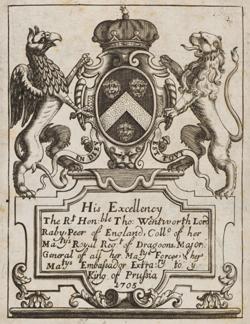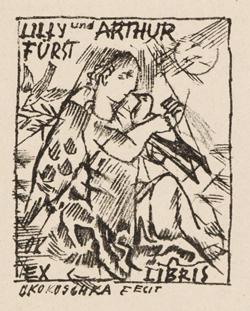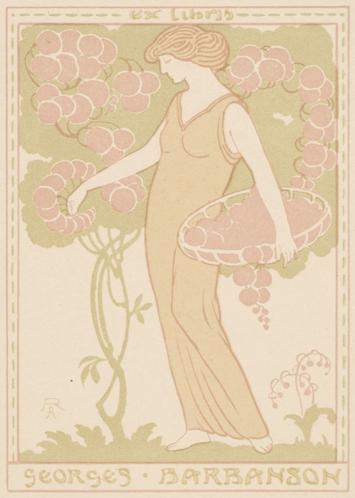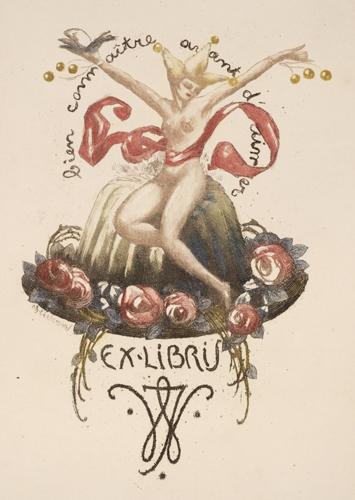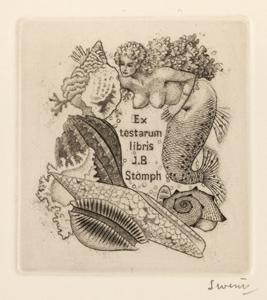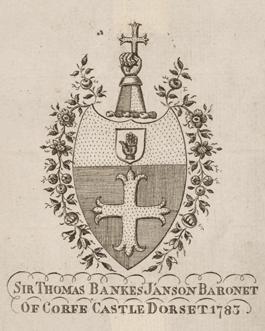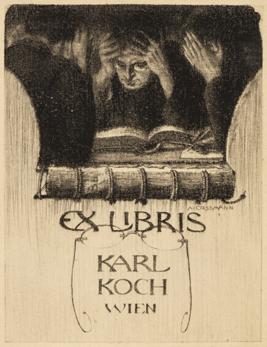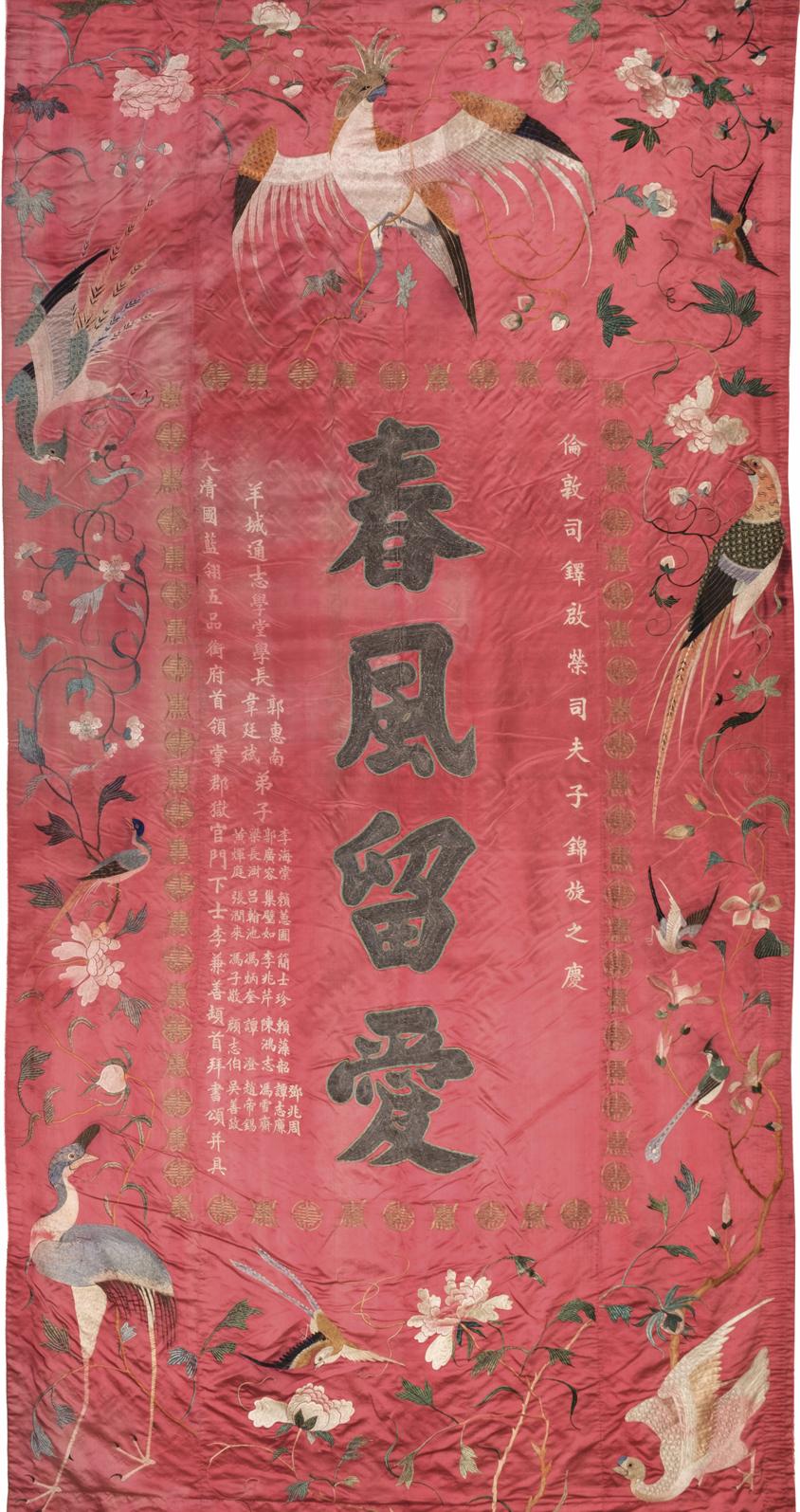
Antiques, Historic Textiles & Studio Pottery 17 OCTOBER 2024



Antiques, Historic Textiles & Studio Pottery 17 OCTOBER 2024

VIEWING
AUCTIONEERS
Henry Meadows
Monday & Tuesday 14/15 October 9.30am-5.30pm Sale morning from 9am (other times by appointment)
Light refreshments available on view days with extra lunch options on sale days

Mallard House, Broadway Lane, South Cerney, Cirencester, Gloucestershire, GL7 5UQ
T: +44 (0) 1285 860006
E: info@dominicwinter.co.uk www.dominicwinter.co.uk




COMMENCING 10.00 am
VIEWING
Monday & Tuesday 14/15 October 9.30am-5.30pm
Morning of sale from 9am (other times strictly by appointment)
Tel: 01285 860006 info@dominicwinter.co.uk
Condition reports now including video conferencing can be requested in the following ways: T: +44 (0)1285 860006 | E: info@dominicwinter.co.uk Via the relevant lot page on our website www.dominicwinter.co.uk
Lots marked with AR next to the lot number may be subject to Droit de Suite. Droit de Suite is payable on the hammer price of any artwork sold in the lifetime of the artist, or within 70 years of the artist's death. The buyer agrees to pay Dominic Winter Auctioneers Ltd. an amount equal to the resale royalty and we will pay such amount to the artist's collecting agent. Resale royalty applies where the Hammer price is 1,000 Euros or more and the amount cannot be more than 12,500 Euros per lot.
The amount is calculated as follows:
Royalty For the Portion of the Hammer Price (in Euros)
4.00% up to 50,000
3.00% between 50,000.01 and 200,000
1.00% between 200,000.01 and 350,000
0.50% between 350,000.01 and 500,000
Invoices will, as usual, be issued in Pounds Sterling. For the purposes of calculating the resale royalty the Pounds Sterling/Euro rate of exchange will be the European Central Bank reference rate on the day of the sale.
Please refer to the DACS website www.dacs.org.uk and the Artists’ Collecting Society website www.artistscollectingsociety.org for further details.
For payment arrangements please refer to information for buyers at rear of this catalogue.
We would kindly request that commission bids are submitted by 9.30am on the morning of sale.
Customers may submit commission bids or request to bid by telephone in the following ways: T: +44 (0)1285 860006. |. E: info@dominicwinter.co.uk Via the relevant lot page on our website www.dominicwinter.co.uk
Live online bidding is available on our website www.dominicwinter.co.uk (surcharge of 3% + vat): a live bidding button will appear 30 minutes before the sale commences. Bidding is also available at the-saleroom.com (surcharge of 4.95% + vat) and invaluable.com (surcharge of 3% + vat).

For payment information see our Information for Buyers page at the rear of this catalogue. For details regarding storage, collection, and delivery please see our Information for Buyers page or contact our office for advice. Successful bidders will not incur storage fees while current government restrictions remain in place.
All lots are offered subject to the Conditions of Sale and Business printed at the back of this catalogue. For full terms and conditions of sale please see our website or contact the auction office. A buyer’s premium of 20% of the hammer price is payable by the buyers of all lots, except those marked with an asterisk, in which case the buyer’s premium is 24%.




Antiques, Textile & Studio Pottery
Henry Meadows BA Hons, MRICS
Susanna Winters MA (History of Art)
Colin Meays BA Hons (Conservation)
Edmund Saddington BMus (Hons)
Tel: 01285 860006 info@dominicwinter.co.uk

Catalogue Produced by Jamm Design 020 7459 4749 | info@jammdesign.co.uk
Photography by Marc Tielemans – 07710 974000 | marc@tielemans.co.uk
Darren Ball – 07593 024858 | darrenball1989@gmail.com
HISTORIC TEXTILES & FANS
To commence at 10am
310* Bed Linen. An early 18th century pillowcase, 1710, large pillowcase of fine linen, with drawn threadwork and insertions of hand-made lace, indistinctly stitched (due to loss of thread) in black cross-stitch with the words ‘Christ is my redemer [sic] in home/I trust my soul is for the Lord and my body is for the dust’, and the date 1710, some light foxing and marks, 50 x 88 cm (19.75 x 34.75 ins), together with a coarse linen shift, probably 18th century, with round neck, elbowlength sleeves, and initials in red cross-stitch to front ‘A x S’, several small stains, chest 56 cm (22 ins), sleeves 27 cm (10.5 ins), length 108 cm (42.5 ins)
Provenance: Private Collection, Derbyshire. (2) £100 - £200
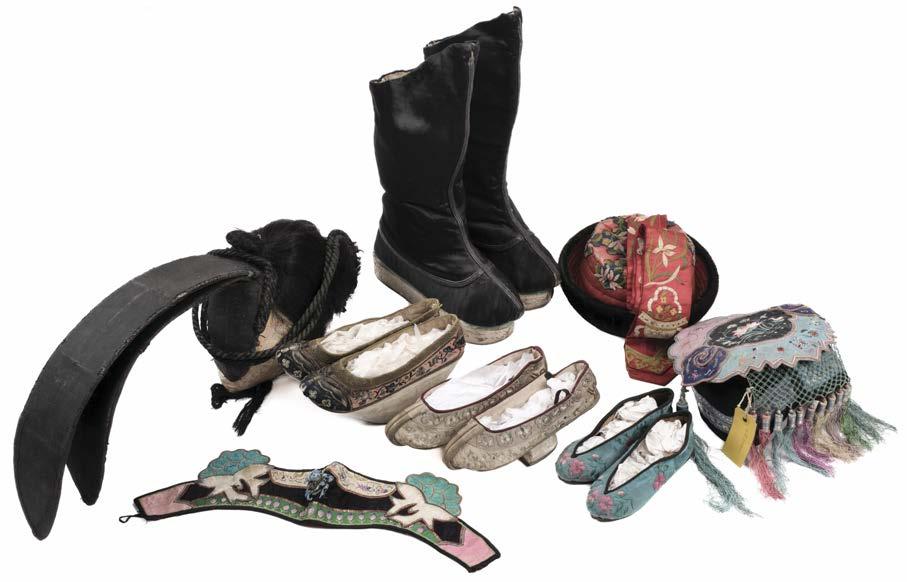
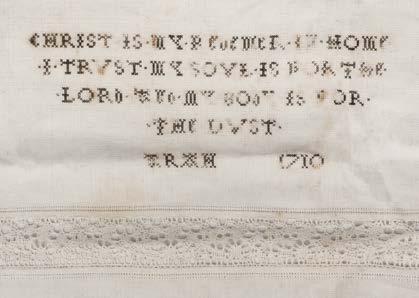
311* Chinese Clothing. A collection relating to Reverend William Chalmers Burns (1815-1868), comprising: William Burns’ own full-length blue cotton coat, long-sleeved, round-necked, and with toggle fastenings to right-hand side, lined with turquoise silk, some staining and scattered small holes, manuscript label stapled to nape ‘W.C. Burns’ Dress Lent by Mrs Islay Burns [wife of William’s brother] Octr. 1894’, chest 122 cm (48 ins), sleeves 69 cm (27 ins), length 133.5 cm (52.5 ins); another long coat, of royal blue figured silk; 2 children’s silk pierrot costumes (blouse and breeches), trimmed with lace and large self buttons; 2 black hair wigs, one with 2 large lappets, and a cap with black hair plait, printed to lining ‘Clarkson, Maker, 15, Wellington St., Strand’; 13 hats or headdresses with various embellishments; an embroidered collar; 3 pairs of boots, 2 of black silk, and the other of black velvet with appliqués, and toggle fasteners to heel; 10 pairs of embroidered or appliquéd shoes; and a tucked sleeve cuff, various condition and sizes, together with a copy of Northern Lights: Pen and Pencil Sketches of Modern Scottish Worthies, [by Reverend Jabez Marrat], 1st edition, London: Wesleyan Conference Office, 1876, letterpress engravings, original gilt decorated olive green cloth, 8vo
Provenance: Private Collection, Derbyshire (purchased by the owner in an antique shop in Portsmouth 65 years ago).
Scottish minister William Chalmers Burns studied theology at Glasgow and was licenced in 1839, travelling to preach first around the British Isles and then to Canada (1844-46), before sailing to China in 1847 as an envoy of the English Presbyterian Missionary Society (EPMS). He adopted the Chinese dress and way of life, and lived in Hong Kong, Canton, Amoy, Shanghai, Peking, and Niu-chwaag, choosing not to stay long in one place so as to more effectively spread the Christian message. Burns was said to be one of the most devoted missionaries of modern times. He won wide-spread respect amongst the Chinese people with whom he lived and worked, and he translated Bunyan’s Pilgrim’s Progress into their native tongue. This collection of Chinese costume was part of a travelling exhibition, which was taken on tour in a covered waggon to parts of Britain in order to raise money for the EPMS. The book which accompanies this lot contains a chapter on the life of William Burns, with a frontispiece showing him wearing Chinese dress (pp.30-54).
Islay Burns was William’s brother; he wrote Memoir of the Rev. Wm. C. Burns, M.A., Missionary to China from the English Presbyterian Church, published by James Nisbet in 1870.
(2 cartons)
Each lot is subject to a Buyer’s Premium of 20% (Lots marked * 24% inclusive of VAT @ 20%)
£400 - £600
312* Chinese Embroidery. A large embroidered silk panel presented to British Sacerdote Qi Rong by his Chinese disciples at Guangzhou Tongzhi Academy and Qing Dynasty officials, circa 1900, appliquéd and embroidered in polychrome siks on a red silk ground, with 4 large appliquéd Chinese characters vertically in centre ('Spring Breeze Holds Love'), composed of couched metallised silver threads, and edged with couched green silk threads, with smaller embroidered characters to each side, within a border of auspicious symbols (e.g. longevity) couched direct in metallised gold threads, large outer border of embroidered exotic birds symbolising good fortune (including cranes, golden pheasants, magpies, and paradise flycatchers) amongst paeony, magnolia, and other flowering stems, some mottled fading to ground, 4 cm tear and a few tiny holes to extreme lower edge, backed with pale cotton (some staining and small holes), top edge mounted with drawing pins to a wooden baton, with modern manuscript label attached, 293 x 145.5 cm (115.5 x 57.25 ins)
Provenance: Private Collection, Derbyshire.
The label, written by the current owner, reads: ‘Given to me 60 years ago by our neighbour, Mrs Hilda Read whose aunt was a missionary in China. I was told this was a gift from the Empress when she left China. It may have been something to do with her trying to stop foot binding’.
We are indebted to Zhe Chen, University of Sheffield, for his translation and analysis of this piece: ‘This impressive silk banner is a celebratory gift, presented by many disciples and led by a mid-level Qing Dynasty official. It was collectively given to a London priest named Qi Rong to honour his glorious return. Based on the text, there are two possible interpretations of Qi Rong’s status. One is that he was a British priest returning to England. The other is that he was a Chinese priest who served in London and is now returning to China. I prefer the first interpretation. As such, this banner signifies a deep friendship between a British priest and his Chinese disciples and holds good value as a historical artefact.
The banner should be read from right to left, and from top to bottom.
The first column (from the right) contains the recipient’s information. The second column, which contains the central message in large characters, conveys words of well-wishing. The third and subsequent columns list the social titles and names of the givers.
Translated from right to left, the banner reads as follows: Celebration for the glorious return of London sacerdote (司鐸), Master (司夫子) Qi Rong (啟榮). Spring breeze holds love (春風留愛).
Givers:
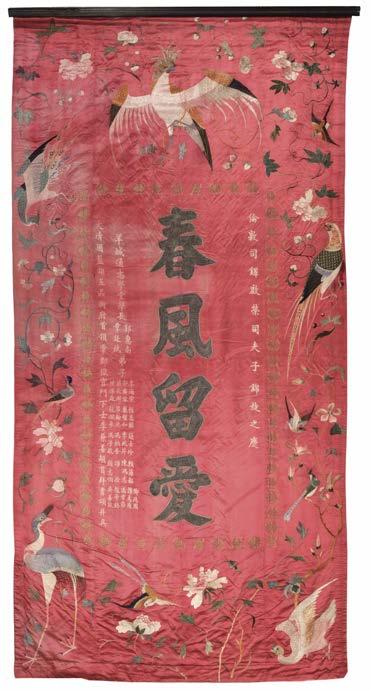
Guangzhou Tongzhi Academy (羊城通志學堂) Headmasters: Huilan Guo (郭惠南), Tingbin Wei (韋廷斌). Disciples: Haitang Li (李海棠), Guangrong Guo (郭廣容), Changshu Liang (梁長㴻), Huiting Huang (黃煇庭), Huipu Lai (賴蕙圃), Biru Cao (巢璧如), Hanchi Lu (呂翰池), Runlai Zhang (張潤來), Shizhen Jian (簡士珍), Zhaoqin Li (李兆芹), Bingkui Feng (馮炳奎), Zijing Feng (馮子敬), Zaoshao Lai (賴藻韶), Hongzhi Chen (陳鴻志), Cheng Tan (譚澄), Zhibo Yan (顏志伯), Zhaozhou Deng (鄧兆周), Zhilian Tan (譚志廉), Xuezhai Feng (馮雪齋), Dixi Zhao (趙帝錫), Shanzheng Wu (吳善政). Big Qing Dynasty, Blue feather five-rank officer (清国藍翎五品銜, mid-level Qing Dynasty rank), head of a provincial prison (府首领掌郡狱官), and disciple Jianshan Li (門下士李兼善), respectfully bows and presents this tribute(頓首拜書頌並具).’
Zhe Chen goes on to quote his colleague: ‘When I first read this document, I was very excited as well. I remember seeing this form of “banner” when I was a child, but this is the first time I have come across such an artefact representing an interaction between East and West. Considering the status of both sides, on one side, we have a British sacerdote (��), which refers to more than just a priest; and on the other side, we have disciples of the Qing Dynasty, not just ordinary disciples, but high-status individuals from Guangdong (the neighbouring province to Hong Kong). This makes the artefact’s value quite exceptional. Furthermore, during the Qing Dynasty, I imagine such artefacts would have been incredibly rare worldwide. It would be worthwhile to consult relevant resources and conduct further research on it.’ (1)
£700 - £1,000
313* Chinese Embroidery. A long length of embroidered silk, early 20th century, finely hand-embroidered in silk threads in shades of green, pink, blue, and cream, using Peking knots edged with couched fine twisted braid, with a pattern of paeonies on sinuous stems, on a royal blue silk ground, top edge hemmed by hand, remains of stitching to sides and lower selvedge, one machine-stitched join (not affecting needlework), and a crudely hand-stitched join 21.5 cm from left-hand edge (pattern not quite matching up), right-hand edge with irregular portion excised (approximately 23 x 23 cm), irregularly-shaped hole in lower edge (13 x 5 cm at largest points) patched with a piece of the same silk (slight loss of embroidery), one 3.5 cm long faint dark mark, overall size 38 x 627 cm (15 x 247 ins)
Notwithstanding the various condition issues noted, this piece of embroidered silk is in bright, clean condition, with the stitching largely intact. (1) £200 - £400
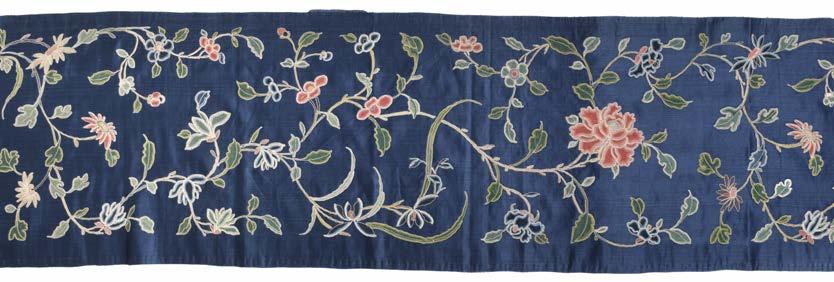
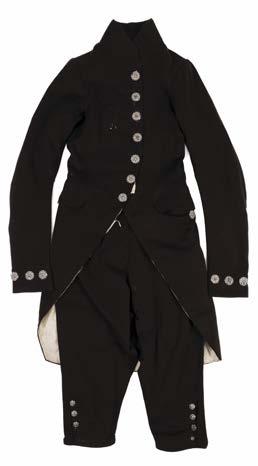

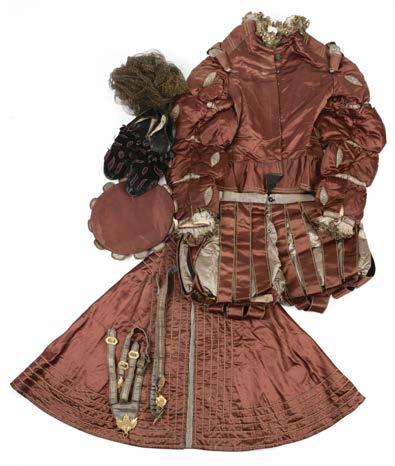
314* Clothing. A Quaker gentleman's wool suit, circa 1780, handstitched brown wool two-piece suit, with some historic moth damage, comprising: a frock coat, with standing collar, curved sleeves, cut steel decorative buttons (7 down the front, 3 to each cuff, 1 below each pocket flap, and 2 to rear), 2 concealed metal hook and eye fasteners to front, and cream silk lining (perishing in places), chest 84 cm (33 ins), sleeves 70 cm (27.5 ins), length 94 cm (37 ins); and a pair of matching fall front knee breeches, with buttons to waist and fly front (1 missing), and 4 cut steel buttons to each knee, waist 80 cm (31.5 ins), length 76 cm (30 ins)
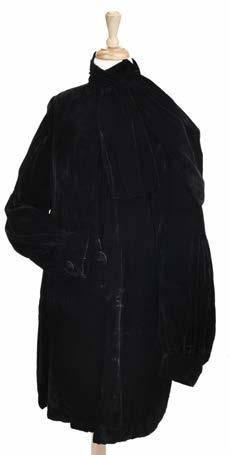
317 Clothing. A black velvet opera coat, circa 1920s, black velvet short coat, with long sleeves and neck tie, bust 98 cm, sleeves 66 cm, length 90.5 cm, together with 7 other items of early to mid 20th century clothing, including a 1930s black velvet dress, a 1950s black chenille coat, a 1930s black crepe dress, a Susan Small black dress, and a Victorian fur cape, various condition and sizes (9)
£150 - £200
Provenance: Private Collection, Derbyshire (from a Quaker family in Winchester). (2)
£100 - £200
315 Clothing. A collection of mid-later 20th century clothing, comprising: a gold full-length evening dress with high neck, balloon sleeves, and sequinned bodice, a Biba skirt, a pair of patterned fabric knee-length boots with leather lining and low heels, a suit, a Top Shop dress with cape attached to the collar and sleeves, and 2 floral dresses, all 1960s/70s; 3 wedding dresses, one 1950s, together with the veil and related wedding photograph album showing the dress being worn; and a Mary Quant umbrella, various condition and sizes (14)
£200 - £300
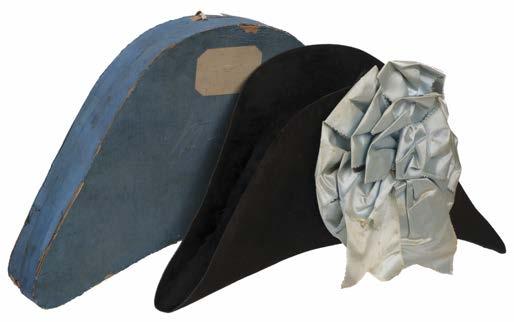
316 Clothing. A 19th century Elizabethan-style theatrical costume or fancy dress outfit, comprising a doublet, trunk hose, cape, and flat cap, all of terracotta satin and pale turquoise satin (latter faded) edged with plaited gold metallic braid, doublet with padded slashed-look sleeves gathered at intervals, and with neck and cuffs trimmed with net lace edged with gold metallic lace, some wear and marks (black silk lining of doublet with historic insect damage), and a matching blue satin holster belt in two parts with yellow metal buckles and embellishments, a gold metallic mesh sash, and a pair of midnight blue and raspberry pink slashed velvet shoes (worn), various sizes (7)
£150 - £250
318* Clothing. A cocked hat belonging to Charles Wykeham Martin of Leeds Castle (1801-1870), black beaver bicorn hat, embellished with a large bow of pale blue picot-edged silk ribbon (with mottled discolouration and one tail torn almost across), lined with black silk, 42 x 13 cm (16.5 x 5 ins), contained in the original blue papercovered cardboard box (dusty and broken, with some small losses), with sepia ink label loosely inserted ‘Hat worn by Charles Wykeham Martin Esqr at the Declaration of the Poll when M.P. for West Kent’ Provenance: Leeds Castle property and contents sale, 1925; Sotheby’s, Sale of the Contents of Sheffield Park, Sussex, March 8th, 1954; Private Collection, Derbyshire. Charles Wykeham Martin, a Conservative Party politician who sat in the House of Commons during three periods between 1841 and 1870, was the son of Fiennes Wykeham and Elizabeth Bignell. Fiennes Wykeham assumed the additional surname of Martin by royal license in 1821 when he succeeded to Leeds Castle on the death of his relative, General Philip Martin. Charles wrote The History and Description of Leeds Castle, Kent, published by Nichols and Sons in an edition of 500 copies in 1869. (1) £100 - £200

319* Clothing. A collection of ladies’ shoes and half boots, early to later 19th century, comprising: 3 pairs of cream silk evening or wedding slippers, 2 pairs bearing the engraved oval label of ‘Thunder, Boots & Shoe Maker, to the Queen, 2, Castle Square, Brighton’, and ‘Borsley, Maker, No.43, Wigmore Street, Cavendish Square’ respectively, latter pair annotated inside in pencil ‘My Wedding Shoes F.C. Stilwell’, and in ink to one sole ‘Mrs Hales’s Wedding shoes on her marriage with James Stilwell 1825’, and a black pair similar; 3 pairs of bow-embellished shoes with heels, 2 pairs of cream silk, the other pair of yellow silk; and 3 pairs of cream leather half boots, 2 pairs gusset ted and with heels (one adorned with silk bows), the other pair flat, with stitched eyelets and tongue to side (lacking lacing), latter contained in a hand-stitched linen bag, generally dusty and worn, although the boots in better condition, various sizes
Provenance: Private Collection, Derbyshire. (10 pairs)
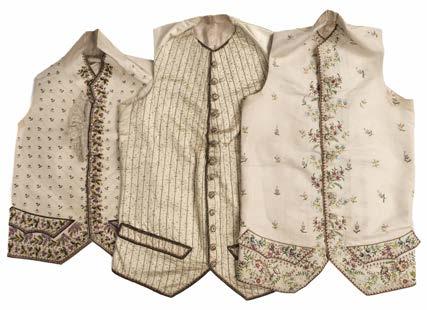
320* Clothing. A gentleman’s embroidered silk waistcoat, late 18th century, hand-stitched cream silk waistcoat finely embroidered to front panels in polychrome silk threads, using satin stitch, stem stitch, french knots, and chain stitch, with all-over large floral sprigs, and wide borders of flowers and leaves on sinuous stems, pocket flaps and 10 buttons embroidered to match, back of cream wool, some foxing (especially to back), underarms stained, edges of neck and underarms slightly fraying, lined with silk and linen (toned), chest 88 cm (34.5 ins), length 70 cm (27.5 ins), together with two other embroidered cream silk waistcoats similar: one with small sprigs overall, and trefoil and leaf border, worked in shades of green, burgundy, yellow, and brown, with 8 embroidered buttons and pocket flaps (for false pockets) to match, flaps becoming detached, later hand-made lace ruffle stitched to edge of left-hand side, a few stains, mainly to underarms, edges of neck and underarms slightly frayed, chest 86 cm (34 ins), length 57 cm (22.5 ins), and the other with chain stitch stripes of green silk thread flanked by cream silk thread, additionally stitched all over with tiny silver spangles in a lattice pattern (some missing), edges of front panels and pocket flaps embroidered with a border of metallic thread and green and pink chenille thread, buttons stitched with spangles and a flower to match, chest 97 cm (38 ins), length 74.5 cm (29.25 ins) (3) £300 - £500
£300 - £400

321* Clothing. A green and gold silk waistcoat, 18th century, hand-stitched waistcoat of gold and olive green narrow stripes, with matching buttons and pocket flaps, edges of front panels and flaps with green and metallised gold braid, olive green wool back (with some small areas of historic moth damage), lined with linen and cotton (slightly toned and marked), together with a striped yellow silk waistcoat, early 19th century, with later cloth tabs on back for tying, and:
A gentleman’s needlework waistcoat, mid 19th century, handstitched waistcoat, the front panels finely worked in polychrome wools in cross-stitch, with vertical lines of alternating floral and dotted flourishes, with slit pockets, back of brown twilled cotton, with laced half-belt, lined with beige twilled cotton annotated in contemporary ink ‘Edwd D. Nesfield Esqre Sept. 28/50’, lining lightly stained, but otherwise in very good condition overall, chest 100 cm (39 ins), length 54 cm (21.25 ins), plus a pair of hand-stitched short braces, worked in cross-stitch in coloured wools on canvas, backed with kid leather, and edged with cream silk ribbon (perishing), length 53.5 cm (21 ins) (5)
£200 - £300

322*
Clothing. A lady’s day dress, circa 1850s, hand-sewn lady’s gown of cotton patterned with wide and narrow stripes in a green and brown marbled effect, boned bodice with v-shaped neck, metal hook and eye fastenings at front (rusty, a couple missing), long flared sleeves, and gathered skirt with small train, rear with small shield-shaped lappet over 2 longer lappets, neck, sleeves and lappets embellished with black velvet ribbon and fringing, black velvet belt with bow to waist, and 3 bands of black velvet ribbon to skirt, lightly toned, bodice lined with twilled cotton, and the sleeves with fine linen (stained to underarms), hem doublelayered, the inner layer lined with gauze, bust 89 cm (35 ins), waist 72.5 cm (29 ins), sleeves 51 cm (20 ins), length at front 134.5 cm (53 ins), and at back 152 cm (60 ins), together with:
A day dress with gigot sleeves, circa 1890s, light brown shot silk gown with pattern of gold woven ovals, with gathered bodice, high buttoned neck with gold frill-edged collar (1 button missing and stitched loops broken), and very wide sleeves narrowing at cuff to terminate in a gold frill, metal hooks and eyes/stitched loops to front opening and waist (some missing), some small holes (mostly towards hem), stitching lost to left-hand shoulder seam, 6 cm closed tear to right-hand sleeve, lined with brown silk, together with a matching square collar, bust 79 cm (30.5 ins), waist 64 cm (25 ins), sleeves 73.5 cm (29 ins), length 137 cm (54 ins), and slightly longer at rear, plus 17 other ladies’ garments, mid 19th-early 20th century, comprising 9 gowns, 2 two-piece dresses, 5 bodices, 2 with gigot sleeves, 2 possibly of 18th century silk (though later construction), and a pink silk-lined wool cape with ruffle collar by W. Rowntree & Sons, Scarborough, various sizes and condition
Provenance: Private Collection, Derbyshire. (21)
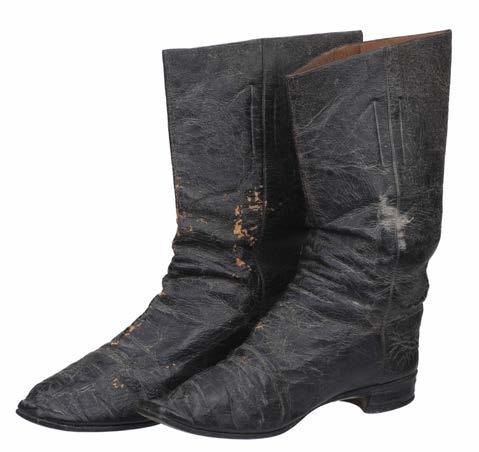
323* Clothing. A pair of 18th century ladies’ riding boots, by Stone of Brighton, 1737, black leather, back of low heels with small square metal-lined aperture (presumably for attaching spurs), each boot with pair of woven cloth loop pulls inside, leather dry with some surface flaking, back of left boot with 20 cm vertical split from top edge, each boot with contemporary ink inscription inside ‘ Stone Maker To Their Majesties Brighton, 10.12.6. 1737’, height 26 cm (10.25 ins), width 6 cm (2.5 ins), length 23 cm (9 ins)
Provenance: Private Collection, Derbyshire.
£300 - £500
Rare pair of early ladies’ boots, with the maker’s name written inside each. A Mr Stone, shoemaker to His Royal Highness the Prince Regent, is documented as having a shop in East Street, Brighton, in 1819 (see History of Brighthelmston, by John Ackerson Erredge, 1862), and a Solomon Stone is listed as working out of 4 Gardner Street in Brighton in a 19th century Kelly’s Directory online, but we have been unable to trace the maker of these boots, who was most likely their forebear. (a pair)
£200 - £300
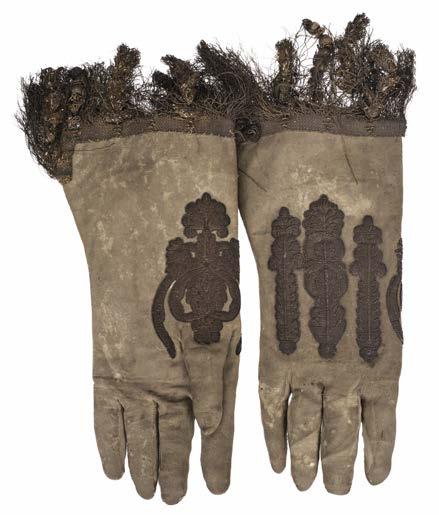
324* Clothing. A pair of ceremonial gauntlet gloves believed to belong to the King’s Champion, British, before 1728, hand-stitched buff leather gloves, some surface rubbing and several small holes, embellished with metalwork embroidery, comprising a large stylised palmette design emanating from each thumb, and 3 vertical lines of decoration in a similar style on the back of each glove, finely worked in bullion stitch incorporating spangles, each cuff with 11.5 cm (4.5 ins) wide gold metallised twisted fringe border incorporating ornate tassels (some losses, that to right glove partly detached), lined with cream silk (perishing at edges), initialled in sepia ink in an early hand just inside each cuff ‘G.B.’, length excluding fringing 32 cm (12.5 ins), width at cuff 17 cm (6.75 ins)
Provenance: Leeds Castle property and contents sale, 1925; Sotheby’s, Sale of the Contents of Sheffield Park, Sussex, March 8th, 1954; Private Collection, Derbyshire.
The Museum of Leathercraft in Northampton (to which we are indebted for help with our research) has a left-hand glove almost identical in style to this pair, which is identified as a King’s Champion glove, used during the coronation of King George IV in 1821. The Worshipful Company of Saddlers also has such a glove, which was used at the coronation of King George III in 1760. The Manor of Scrivelsby in Lincolnshire traditionally carries with it the hereditary title of the Grand Champion of England, a title dating back to William the Conqueror, and held by the Dymoke family since 1292. The Champion’s duty was performed at the coronation of each monarch: clad in full armour, carrying a gauntlet and attended by trumpeters, Serjeantsat-Arms, a Herald and the Lord High Constable, the King’s Champion rode into Westminster Hall to deliver a challenge against anybody who might gainsay the Sovereign. The Garter King of Arms read out the challenge three times, and on each reading the Champion threw down the gauntlet - first at the entrance to Westminster Hall, then in the middle of the Hall, and finally at the foot of the throne. Each time the gauntlet was recovered by the Garter. After the third challenge, there being no response, the undisputed monarch would toast the health of the Champion. Since the last such ceremony took place at the coronation of King George IV in 1821, and gauntlets exist for both his coronation, and his predecessor’s, our pair is believed to date from 1727 (the date of King George II’s coronation) or earlier.
(a pair)
£700 - £1,000
325* Clothing. A pair of gentleman’s shoes, European, mid 17th century, hand-stitched reversed grained leather, with blunt square toes, original latchet fasteners, carved wooden soles, and leathercovered high heels painted red, some minor rubbing and light dust-soiling, length 27 cm (10.75 ins), width 7.5 cm (3 ins), height 16 cm (6 ins), heel height 6 cm (2.5 ins)
Provenance: Private Collection, Derbyshire.
An extremely rare pair of 17th century gentleman’s shoes, surviving in extraordinary condition. Men’s shoes survive in far fewer numbers than women’s, meaning that a pair such as these is seldom seen outside of large collections and institutions (for a similar pair see The Met, accession number 1973.114.3a, b); in fact, we have been unable to trace anything similar sold at auction.
There are several clues to suggest that these shoes were owned by a personage of some consequence. Firstly, heels - not exclusive to women’s shoes as they most often are now - were worn by those who did not have to labour. The upper classes have always used impractical, uncomfortable and luxurious clothing to announce their privileged status. Heels were a hindrance for workers in the fields or people who had to walk any distance. Eventually, when the fashion of wearing heels did begin to infiltrate the lower ranks of society, the aristocracy responded by dramatically increasing the height of their shoes, so the higher the heels, the more important the wearer. Secondly, these shoes have leather-covered heels, rather than leather-stacked heels. The latter were more durable, and therefore more likely to be worn by soldiers, and others engaging in activity. Whilst leathercovered heels showed that the wearer was of high status, the addition of adding a layer of colour to the heels took the message to another level, as the dye used was expensive and associated with royalty and the upper echelons of society. Charles II’s 1661 coronation portrait by John Michael Wright (Royal Collection, Throne Room, Palace of Holyroodhouse), features him wearing a pair of enormous red heels. Unlike King Louis XIV, who also adopted heels, and was a diminuitive 5 ft 4 ins, King Charles didn’t need to add to his stature of over 6 ft. In 1771 Hyacinthe Rigaud painted a portrait of King Louis (Louvre Museum), in which his right foot is in profile to display prominently one of his red-painted heels. In the 1670s, Louis XIV issued an edict that only members of his court were allowed to wear red heels, although this didn’t prevent others from adopting the practice. (a pair)

£2,000 - £3,000

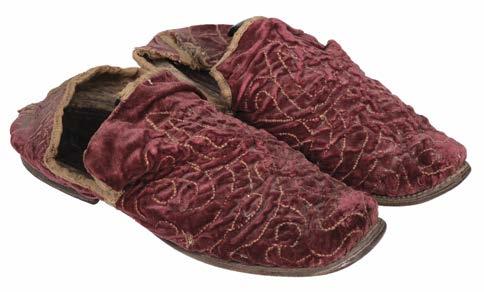
326*
Clothing. A pair of gentlemen’s slippers, probably Italian, early-mid 18th century, a pair of hand-made slippers of crimson velvet, with pointed toe and 2 cm heel, hand-embroidered overall with a meandering line in gold thread, soles and lining of leather, edges bound with fabric tape, some minor fraying to edges in places, heels trodden down and threadbare (the left one consequently split vertically), width 10 cm (4 ins), length 26 cm (10.25 ins)
Provenance: Private Collection, Derbyshire.
See: Museum of Fine Arts Boston for a similar pair, accession number 46.754a-b.

328* Clothing. A pair of wooden pattens, probably 18th century, hand-carved wooden overshoes, with small heel, pointed toe cap, and embossed leather strap riveted on underside of shoes (left clog with 2 rivets missing), leather rubbed and a little cracked, width 8 cm (3.25 ins), length 26 cm (10.25 ins)
Provenance: Private Collection, Derbyshire. (a pair)
£150 - £250
Slippers such as these would have been worn by a wealthy European gentleman, and as with other expensive clothing, were something of a status symbol. They likely would have completed an ensemble comprising a banyan (a type of loose coat or dressing gown), a matching waistcoat, and a cap or turban (with breeches borrowed from another outfit). Gentlemen received guests whilst attired in these, often luxurious, but informal, comfortable garments, as a mark of their intimacy with the visitor. By the 1780s gentlemen even ventured out of doors in this stylish costume. It is very rare for men’s footwear to survive, particularly slippers, which are inevitably less durable than a pair of boots for instance, added to which, women’s slippers were more likely to be kept for sentimental reasons. (a pair)
£200 - £400

327* Clothing. A pair of shoes belonging to Robert, 7th Lord Fairfax of Cameron (1707-1793), hand-stitched white kid leather, with front fastenings for buckle, blunt toe, leather soles, and red leather low heels, tongue of right shoe with label inside written in sepia ink in an early hand ‘Shoes of 7th Lord Fairfax’, soiled, length 27 cm (10.5 ins), width 9.5 cm (3.37 ins), heel height 2.5 cm (1 in)
Provenance: Robert, 7th Lord Fairfax of Cameron (1707-1793); Leeds Castle property and contents sale, 1925; Sotheby’s, Sale of the Contents of Sheffield Park, Sussex, March 8th, 1954; Private Collection, Derbyshire. Major Robert Fairfax served in the 1st Troop of Horse Guards. He was MP for Maidstone from 1740 to 1741 and from 1747 to 1754, and MP for Kent between 1754 and 1768. He was born and died at Leeds Castle, which he inherited from his mother Catherine, daughter of Thomas Culpeper, 2nd Baron Culpeper of Thoresway. (a pair)
£500 - £800

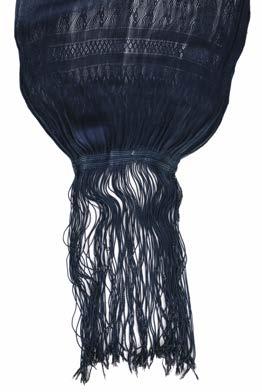

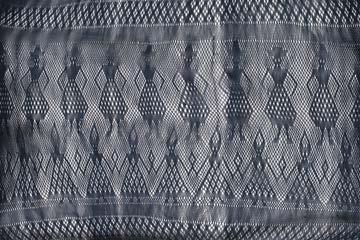
329* Clothing. A rare blue sprang sash, probably Hungarian or Turkish, circa 1620, long sash of blue fine silk, worked in the sprang technique, probably with a circular warp, with a number of different repeated horizontal patterns, including stylised cockerels, ships, women wearing high-waisted dresses, and men wearing hats and wide breeches with arms akimbo, short ends with 28 cm (11 ins) long twisted fringe, some very minor light discolouration in places, several small holes or splits (largest 3 cm long), width (when not stretched) 38 cm (15 ins), length (excluding fringe) 4.11 metres (13.5 foot)
Provenance: By descent through the Enys Family of Penryn, Cornwall, at least until the time of exhibition (see below).
A remarkable survival, in very good condition, this sash was exhibited, along with a red one similar, under the title ‘The Enys Family Sashes’ at a Civil War Exhibition at the Royal Cornwall Museum in 1992/3 (lent by the Trustees of the Enys estate, by permission of Professor Gordon Leonard Rogers who inherited the estate in 1980). Eminent clothing historian Janet Arnold (19321998) examined the sashes at that time, and dated the blue one to circa 1620. The V&A has a similar, though later, sprang sash in the more commonly found red hue (accession number T.193-1957).
Enys family tradition was that both sashes had been worn by family members during the English Civil War, although there is no documentary evidence for this. Such sashes were indeed worn by senior military officers, and were known to have had a practical as well as a decorative purpose; such is their tensile strength (silk being five times stronger than steel) and ability to stretch laterally (due to the sprang technique), that they were used as stretchers to carry wounded men off the battlefield. A sprang sash of circa 1709 in the collection at George Washington’s Mount Vernon (object number W-86) was apparently used to transport the fatally wounded Major General Edward Braddock during the Battle of the Monongahela in 1755 (he managed to present his sash to George Washington, his aide-de-camp, before expiring four days later).
After the Royal Cornwall Museum exhibition two of the curators there wrote an article for the museum’s biannual newsletter (RIC Newsletter 13, April 1993: full text available), in which the Enys sashes are compared to early 17th century sprang sash fragments in the National Museum of Hungary. The article concludes that it is highly probable that the blue sash is early 17th century and Hungarian in origin, although it has also been suggested by other scholars that the fragments came from Istanbul. George Rákóczi, Prince of Transylvania (1593-1648) ordered sprang sashes from the Turkish capital several times, where it seems from extant correspondence that such sashes were hard to come by, only one aged woman being proficient in the technique (see The Influence of Ottoman Turkish Textiles and Costume in Eastern Europe with particular reference to Hungary, by Veronika Gervers, Royal Ontario Museum, 1982). By whose hand this blue sash and its red companion were made, and how they came to be in the possession of the Enys family, is lost in the mists of time, but their worth was clearly known by the family, who passed them down the generations until the end of the 20th century when financial decisions had to be taken to ensure the survival of the estate.
(1)
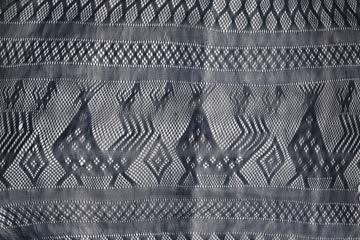

330* Clothing. A rare pair of sleeve plumpers, circa 1830, two sleeve puffs of fine cotton lawn, filled with swansdown, with flap to sit on shoulders, and ties to attach to a corset, lightly stained and marked, 1 or 2 small holes and mends, each approximately 23 x 30.5 cm (9 x 12 ins)
See the V&A: accession number T.212-1917 (one sleeve puff only).
Sleeve plumpers rarely come onto the market, and are seldom found in institutions; we have been able to find only two other occasions when they have appeared at auction, in 2007 and in 2018, and even the V&A holds only a single puff and not a pair.
Sleeves began to widen to an exaggerated form during the second half of the 1820s, reaching their zinith around 1836, after which they began to decrease in size again. For full effect these capacious sleeves were kept in place with wire or cane structures or sleeve plumpers which were filled with either wool or swansdown. Often such structures would be sewn into gowns, others were designed to attach to a corset’s shoulder straps by means of cotton ties. In the 1830s these straps were oriented at a 45degree angle from the body, and sometimes even more obliquely, therefore puffs attached to them did not disrupt the line of the shoulder. Instead, they were poised somewhat precariously on the upper arm, with the sleeve’s outline simply continued in a descending line from the shoulder. It wasn’t until the 1890s, when sleeves ballooned again, that puffed sleeves rose vertically above the shoulder. In the late 1820s and early 1830s there were many engraved caricatures produced, satirising the ridiculous proportions of ladies’ sleeves and exaggerating them to even greater absurdity.
(a pair)
£1,000 - £1,500
£500 - £800
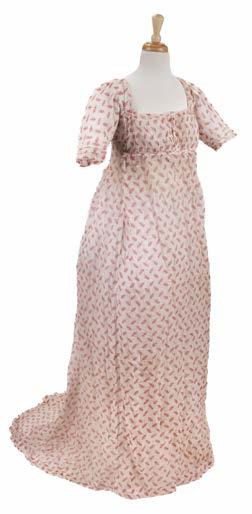

331 Clothing. A Regency muslin dress, circa 1805, hand-stitched white muslin fall-front gown, with red printed pattern of stylised foliate sprigs, short sleeves terminating in tucks, eyelets for lacing at front and back (lacing not extant), and train to rear (with some light discolouration), bodice lined with linen, a number of tears, holes, and darns, bust 78 cm (30.5 ins), sleeves 27.5 cm (10.75 ins), length at front 142 cm (56 ins), and at back 170 cm (67 ins)
Provenance: Private Collection, Derbyshire.
(1)
£200 - £400
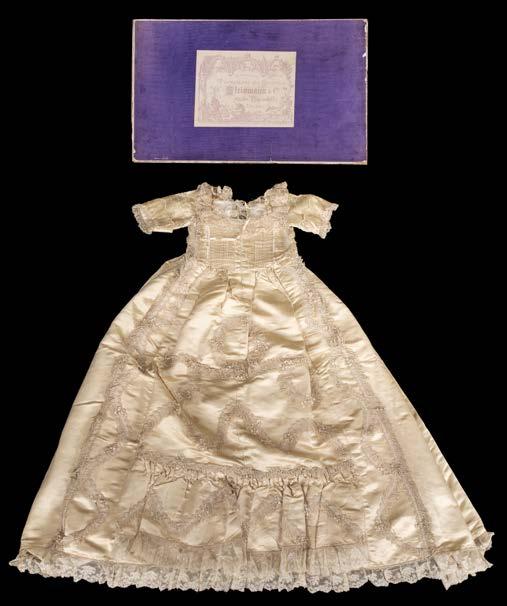
332* Clothing. A silk christening gown, Steinmann & Co., Piccadilly, London, circa 1900, hand and machine-stitched cream silk baby gown, with tucked bodice, and elbow-length sleeves with deep turned-back scallop-edged cuffs, heavily ornamented all over with cream fringed and tasselled braid, lace edging to round neck, rear opening (with silk ribbon ties), sleeves, and hem, silk beginning to perish in places (notably to bodice), a few small marks, lined with ivory silk (that to bodice lightly stained), waist 42 cm (16.5 ins), sleeves 16 cm (6.25 ins), length 91 cm (25.75 ins), contained in purple paper-covered cardboard box (broken, with some losses), with printed label (foxed) on pull-off lid ‘Embroideries, Laces, Trousseaux and Layettes, Steinmann & Co., 185, 186, Piccadilly, London’ Steinmann & Company in Piccadilly was a famous and old established London firm specialising in wedding attire, lingerie, baby linen, and antique lace. Only producing the finest quality garments, Steinmann was an establishment frequented by the wealthy. (1) £100 - £150
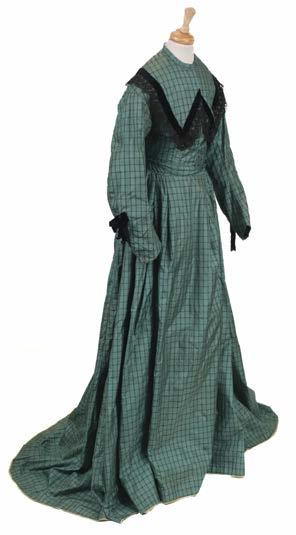
333* Clothing. A silk taffeta two-piece gown, circa 1865, blackchequered emerald green silk, with machine and hand-stitching, comprising a long-sleeved boned bodice with round neck, embellished with black velvet ribbon and machine lace in a v-shape to each side terminating in a V on rear of bodice, and black velvet bows to shaped sleeves, concealed metal hooks and stitched loops to front opening, 3 buttons to back of waistband for attaching to buttonholes on skirt waistband, linen lining with a few marks and stained to underarms, chest 76 cm (30 ins), waist 62 cm (24 ins), sleeves 53 cm (21 ins), and a gathered skirt with train made up of 11 sections, with watch pocket at waistband and large pocket in side, occasional small holes and marks, small L-shaped tear near side opening (crudely stitch-repaired), lime green wool dust gatherer to hem (with some historic moth damage), linen lining with some staining, waist 64 cm (24.5 ins), length at front 118 cm (46.5 ins), and at back 141 cm (55.5 ins)
Provenance: From the collection of the late Mrs June Jeffreys (1928-2016), of Newhouse, Redlynch, near Salisbury, Wiltshire.
The fact that this gown has machine stitching suggests that it was made by a professional dressmaker, as sewing machines were still too expensive at this period to be found in ordinary domestic settings.
(2)
£200 - £300
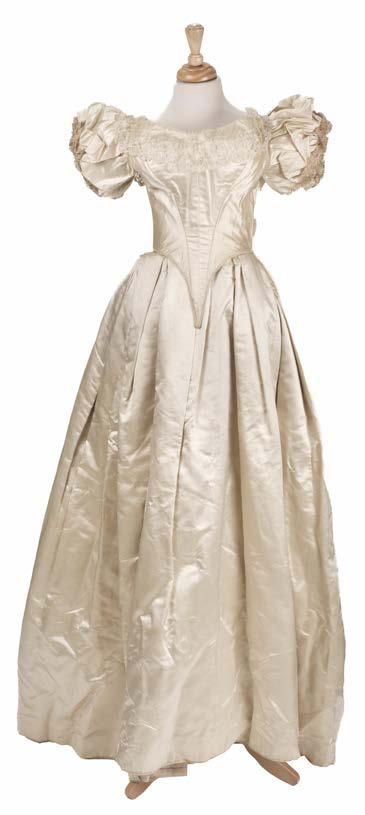
334* Clothing. A two-piece satin wedding gown, circa 1840s, a hand-stitched cream heavy satin two-piece wedding dress, the boned bodice with deep v-shaped waist, and metal hook and loop fastening at rear with eyelets for lacing (not extant), boat neck and puffed seeves trimmed with hand-made lace, bust 71 cm (28 ins), overall length 48 cm (19 ins), the matching pleated skirt with short train, lined with calico (one portion replaced with cotton fabric, and machine-stitched), some minor small marks and foxing in places, waist 56 cm (22 ins), length at front 109 cm (43 ins), and at the back 123 cm (48.5 ins), together with other ladies’ wedding attire, comprising: a 1930s wedding trouseau consisting of a long cream satin sleeveless wedding dress with short train, some overall discolouration, a cream silk belt with faux diamond and pearl clasp (some stones missing), a cream silk petticoat, a cream silk skirt with gold sequin border to hem (worn), a net veil (scattered holes), a pair of cream silk beaded shoes lined with pink satin (some beads missing), a faux flower and pearl chaplet, and a cream satin clutch bag with faux pearl clasp (some pearls detached, yellow metal frame tarnished with verdigris), all contained in a cardboard box lettered on lid ‘G.S. Nicol Ltd., Glasgow’, broken; a two-piece cream satin gown, circa 1890, heavily embellished with lace and faux pearls, sequins, and ruffles, some wear and marks; and 3 small boxes containing other wedding accoutrements, e.g. veils and head-pieces, various condition and sizes
Provenance: Private Collection, Derbyshire. (15) £300 - £500
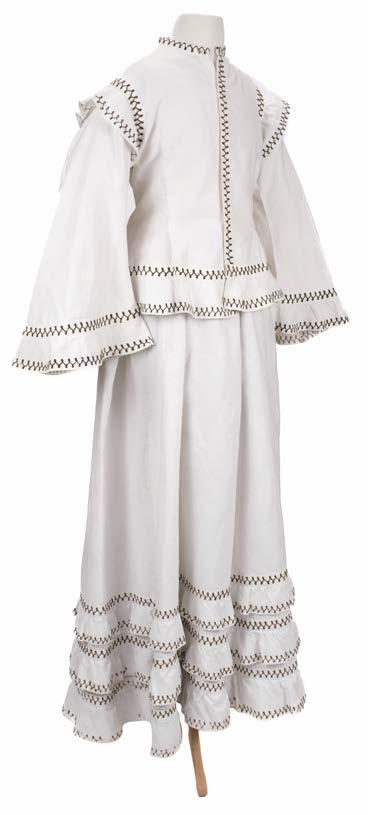
335* Clothing. A two-piece walking or croquet dress, circa 1860, white twilled cotton two-piece, machine-stitched, comprising a fitted jacket with 1.5 cm standing collar and flared waist, long sleeves with flared cuffs, and caps to shoulders, and concealed metal hooks and stitched loop closure to front, edges with looped zig-zag pattern border hand-stitched in brown wool using chain stitch, bust 80 cm (31.5 ins), sleeves 55 cm (21.5 ins), length 56 cm (22 ins), and a matching full gathered skirt with 3 frills to hem similarly embroidered with zig-zag pattern (some loss of threadwork), metal hook and eye fastening to waistband, pocket in side, inside of skirt with loops, ties, and 3 covered buttons, each hanging from a strip of fabric tape at the waist, closed L-shaped tear at top of skirt near waistband (5 cm x 5 cm) crudely repaired with stitching, waist 68 cm (27 ins), length 116 cm (45.75 ins)
Provenance: From the collection of the late Mrs June Jeffreys (1928-2016), of Newhouse, Redlynch, near Salisbury, Wiltshire. Machine stitched, apart from the embroidery, and therefore almost certainly made by a professional dressmaker, as sewing machines were still too expensive at this period to be found in the average home.
An unusual two-piece from the 1860s, with buttons, loops and tapes inside the skirt allowing it to be pulled up in order to gain greater freedom of movement; most likely made for playing croquet, a game which became very popular in the 1860s.
(2)
£300 - £400
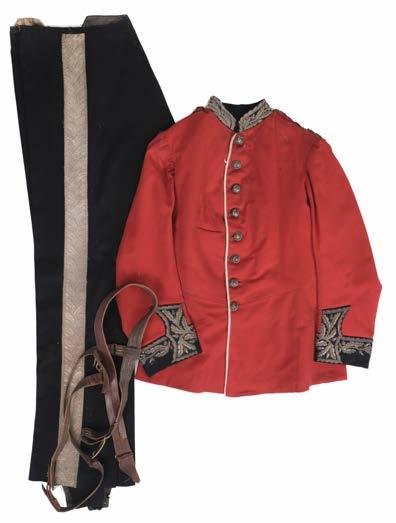
336* Clothing. A Victorian General Officer’s Uniform, comprising: a scarlet melton cloth tunic with black facings and heavy bullion embroidered collar, cuffs, and shoulder cords, general officers silvered buttons by Jennens & Co, London, to the breast, epaulettes, and tail, historic moth damage, chest 80 cm (31.5 ins), inner arm of sleeves 49.5 cm (19.5 ins), length 81 cm (32 ins); black cloth trousers with silver oak leaf braiding, waist 102 cm (40 ins), length 118 cm (46.5 ins); and sword belt with bi-metal V.R. belt plate, manuscript label in the owner’s hand pertaining to provenance attached, general wear commensurate with age Provenance: Josslyn Francis Pennington, 5th Baron Muncaster (1834-1917); Private Collection, Derbyshire (purchased from the Penningtons at Ardverikie Castle).
(1)
337* Clothing. An Egyptian-style Assuit blouse, circa 1920s, cream net woven with hammered white metal pieces forming geometric vertical bands, with short ruched sleeves, and shallow v-neck, the shoulders and centre of front elaborately beaded with silvercoloured seed beads, cream bugle beads, glass beads, and faux pearls, occasional loss of beads, bust 112 cm (44 ins), sleeves 13 cm (5 ins), length 57 cm (22.5 ins), together with a black Assuit shawl woven with yellow metal pieces, sometime crudely made into an overdress (some edges raw and slightly fraying)
(2)
£200 - £300
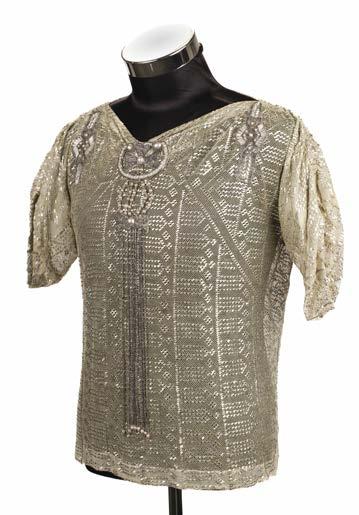
£100 - £150

338* Clothing. An Egyptian-style Assuit dress, circa 1920s, sleeveless black net dress woven with hammered white metal pieces forming diamond patterns, lined with turquoise silk (some small stains and perishing around armholes, with a few stitched repairs), bust 132 cm (52 ins), length 129 cm (50.75 ins), together with a black Assuit shawl woven with yellow metal pieces forming geometric horizontal and diagonal bands depicting figures, camels, and other motifs, some scattered small holes and repairs, 88 x 247.5 cm (34.5 x 97.5 ins)
(2)
£200 - £300


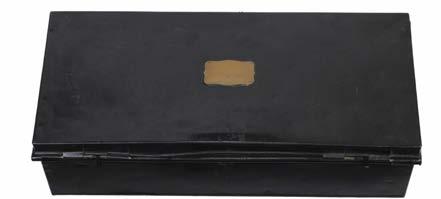
339* Clothing. An embroidered jacket, possibly North African/Ottoman, early 20th century, hand-stitched jacket of gold brocade, with woven pattern of botehs and other motifs in cream and gold metallised threads, heavily embroidered with couched gold metallised threads and silk threads in orange, green, and blue, the front with 2 large wreaths enclosing roundels above 3 smaller roundels on each side, the edges of the jacket (including standing collar and ends of the short sleeves) with a wide matching border, cream silk moiré lining (slightly discoloured to neck), bust 92 cm (36 ins), sleeves, 20 cm (8 ins), length 48.5 cm (19 ins), together with two quilted jackets, also early 20th century, one a bolero in pale pink satin, chest 88 cm (34.5 ins), sleeves 61 cm (24 ins), length 47.5 cm (18.75 ins), the other of apricot silk woven with an oriental pattern, scalloped edges, including to collar, silk perishing on sleeves, bust 96 cm (37.75 ins), sleeves 62 cm (24.5 ins), length 66 cm (26 ins)
A striking jacket, in excellent, wearable condition. (3)
£150 - £250
340* Clothing. Ceremonial uniform in tin trunk belonging to E.J. Boothby, 1911, consisting of: a black wool tailcoat, with standing collar, decorative pocket flaps, and cuffs all decorated with heavy goldwork embroidery embellished with spangles, 9 armorial buttons to front, 2 matching to rear (with further goldwork motif between) and another 2 to end of tails, a few superficial small holes, lined with black silk, starched linen protective collar buttoned to nape, and stitched manuscript label ‘E.J. Boothby. Esqr 28.3.11’, chest 96 cm (38 ins), sleeves 69 cm (27.25 ins), length 106 cm (41.74 ins); a pair of black wool trousers, with metallised gold braid down each leg, some scattered small holes and marks, waist 76 cm (30 ins), length 118 cm (46.5 ins); a pair of cream wool knee breeches, with 3 self buttons and an embossed yellow metal buckle at each knee, some small scattered holes, waist 82 cm (32 ins), length 83 cm (32.75 ins); a black beaver cocked hat by F. P. Scholte, 7 Savile Row, embellished with black silk moiré ribbon and interwoven metallised gold braid with armorial button, edged with black ostrich feathers, lined with black silk, with maker’s gold stamp inside, height 23 cm (9 ins), length 52 cm (20.5 ins); a pair of black leather calf-length boots by N. Tuczek, 15B Clifford Street, Bond Street, with maker’s name etched on leather soles, and stamped in gold on red leather lining to top of boots, height 35 cm (13.75 ins), length 30 cm (11.75 ins); and 2 holsters and 3 pairs of stockings, all contained in a black metal trunk, with brass plaque on lid (left blank)
Provenance: Private Collection, Derbyshire.
Almost certainly purchased for the coronation of King George V and Queeen Mary, which took place at Westminster Abbey on 22nd June 1911. Frederick Scholte, known for his perfectionism and attention to detail, was one of the most influential tailors of the 20th century. He dressed many of the rich and famous, notably the Duke of Windsor. Scholte’s apprentice, Peter Gustav Anderson, founded Anderson & Sheppard, which dresses King Charles.
Renowned British shoemaker Nikolaus Tuczek was born to a family of Austro-Hungarian immigrants. Such was his masterful skill that he became cordwainer to the privileged; Winston Churchill was one of his many wellknown customers, even purchasing his monogrammed velvet slippers there. Tuczek’s legacy continues: George Cleverley started his career with Tuczek in 1920 and worked there for 38 years before opening his own workshop, which was taken over by John Lobb in 1970, a company which still exists today.
(1)
£400 - £600
341* Clothing. Shoes and a tricorn hat belonging to Charles Wykeham Martin of Leeds (1801-1870), hand-stitched black grained leather shoes, rubbed (with some surface flaking), with front fastenings for buckle (versos bearing the name ‘Martin C W Esqr’ in contemporary ink), cream silk lining (perishing), leather soles, and red leather low heels, length 28.5 cm (11.25 ins), width 8 cm (3 ins), heel height 3 cm (1.25 ins); and a black beaver tricorn hat, made by Moore & Co. Late Bicknells & Moore, Old Bond Street, London, with maker’s name to cream silk lining, embellished with gold metallised trim and soutache braid with button, worn, with crown torn, loss of white ostrich feather to brim, and large brown ostrich feather detached, 33.5 x 39 cm (13.25 x 15.25 ins), together with a note written in sepia ink in an early hand ‘Shoes & Hat worn by Charles Wykeham Martin Esqr M.P. at Queen Victoria’s Fancy Ball 1845’
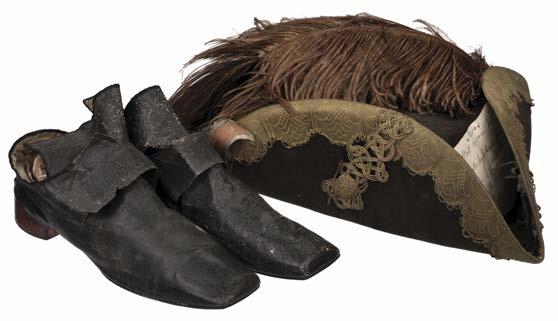
Provenance: Leeds Castle property and contents sale, 1925; Sotheby’s, Sale of the Contents of Sheffield Park, Sussex, March 8th, 1954; Private Collection, Derbyshire.
Worn by Charles Wykeham Martin to the second of three fancy dress balls held by Queen Victoria and Prince Albert at Buckingham Palace. At the first, on 12th May 1842, the Queen and her Consort appeared as King Edward III and Queen Philippa of Hainault; at the second, on 6th June 1845, the attendees were invited to wear early Georgian dress; and the third, on 13th June 1851, was in the style of the Restoration. (a pair)
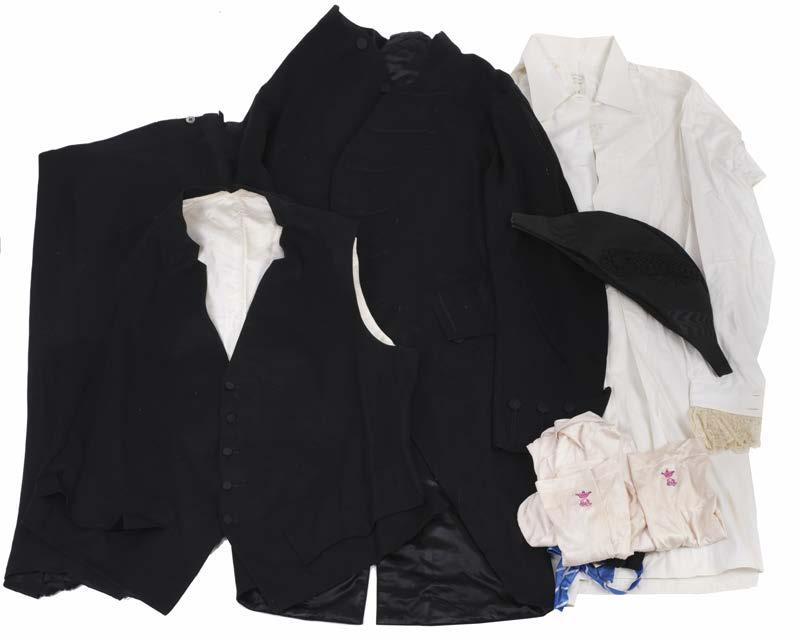

342* Crichton-Stuart (John Patrick, 3rd Marquis of Bute, 18471900). Court dress in tin trunk, comprising: a black wool tailcoat by Meyer & Mortimer, 36 Conduit Street, London, with their printed label at nape annotated in contemporary manuscript ‘Marquess of Bute’, 6 self buttons to front, 3 to each cuff, and 2 to reverse, black braid to front, cuffs, and ornamental pocket flaps, black silk rosette to reverse of neck, and ribbon bows to shoulders, black silk lining; black wool breeches, knees with self buttons, buckles, and black grosgrain ribbon bows, a few tiny holes in rear; a black silk bicorn hat by Meyer & Mortimer, embellished with interwoven black braid, and grosgrain ribbon with matching button, black silk lining, with maker’s name in gilt, some light spotting to crown; a black wool and silk waistcoat by Meyer & Mortimer, with their label to verso of rear belt annotated in contemporary manuscript ‘Marquess of Bute’, with pockets, and 5 self buttons, lined with ivory silk; a long white cotton shirt by Thresher & Glenny Outfitters, 152 Strand, London, with their oval printed label at nape, cuffs with lace frill, a ‘B’ surmounted by a coronet embroidered in red cross-stitch to right side of front, foxed in places; 5 silk bow ties; and 3 pairs of silk stockings, one pair with ‘B’ surmounted by a coronet embroidered in pink thread, generally in good condition, various sizes, all contained in a large black metal trunk, with engraved brass plaque lettered ‘Marquess of Bute’ below the badge of H. Poole & Co., Army & Navy Tailors, 52 Saville[sic] Row, and 4 Old Burlington St, London, height 12 cm (4.75 ins), length 104 cm (41 ins), depth 32 cm (12.75 ins)
Provenance: Private Collection, Derbyshire.
John Patrick Crichton-Stuart acceded to the title 3rd Marquess of Bute at the tender age of six months, whereupon it was said that his inheritance made him the richest person in the world. He became an industrial magnate, antiquarian, scholar, philanthropist and architectural patron. His collaboration with architect William Burges led to the creation of two of the finest examples of late Victorian Gothic Revival architecture, Cardiff Castle and Castell Coch. When he died at the age of 53 his heart was buried on the Mount of Olives in Jerusalem. He was a Knight Grand Cross of the Holy Sepulchre, Knight of the Order of Saint Gregory the Great and Hereditary Keeper of Rothesay Castle.
343* Embroidered Panel. An Arts & Crafts ecclesiastical panel, circa 1870s, expertly worked in polychrome silk threads, using long and short stitch, couching, and french knots, on a pink-purple velvet ground, with a central quatrefoil enclosing a half-length portrait of St Michael, titled to left, with lilies at outer corners, to each side a fire-breathing dragon encircling a cross, flanked by flame-bladed swords surmounted by a crown, ground beginning to perish in places, backed with linen, and with remains of terracotta silk lining, hem stitching unpicked, 24 x 193 cm (9.5 x 76 ins), together with: a large brocade tablecloth, late 18th/early 19th century, fraying overall, with some losses, edged with metallised fringing; 2 embroidered pelmets and 2 appliquéd pelmets, Victorian; a square panel with heavily embossed metalwork embroidery on a velvet ground, depicting a coat of arms, probably Spanish, 19th century, worn; and a collection of curtain ties, 19th & early 20th century, comprising a quantity of tasseled ties, including 7 pairs, 2 sets of 6, a set of 3, and several single ties, and some twisted cord ties, including a set of 4, some wear and losses, various sizes
Provenance: Private Collection, Derbyshire.
Probably made to adorn an altar, the panel takes Revelation chapter 12 for its themes of St Michael and the dragon.
According to the current owner, the second item (large brocade tablecloth) was acquired by a Captain Barwell during the Napoleonic Wars in Spain. (2 cartons)
£200 - £400
Prestigious bespoke tailors Meyer & Mortimer, Thresher & Glenny, and Henry Poole are all still in operation today. (1)
£700 - £1,000
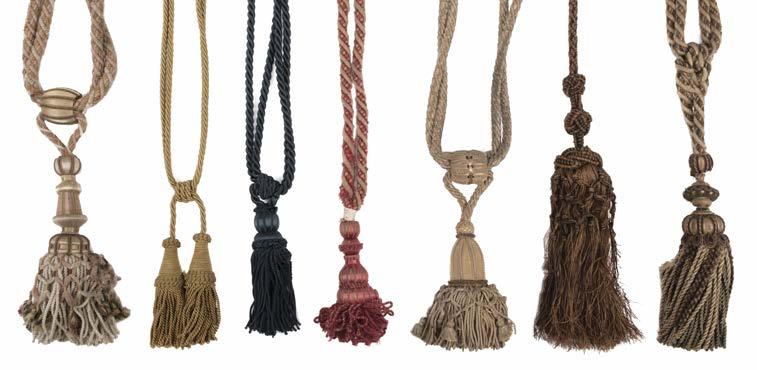


344* Embroidered Panel. Scenes from the Life of Christ, probably Swiss or South German, early 17th century, needlework panel finely worked in silk and wool threads, in shades of pink, blue, green, brown, and yellow, using tent stitch and cross-stitch, on a canvas ground, comprising 6 interior and exterior scenes each within a yellow line border: the Samaritan woman at the well; Jesus at the home of Mary and Martha; two blind men receiving sight; Peter walking on the water with Jesus; the faith of the Canaanite woman; and the feeding of the 5000, each scene approximately 20.5 x 25.5 cm (8 x 10 ins) and set within a border comprising a large stylised flowering stem rising up from an urn between each scene, and meandering stems of fruit and flowers above and below, incorporating animals and birds, including hounds and deer, the whole enclosed in an outer line border of predominantly yellow thread, scattered small holes and threadbare areas (some later infills and repairs), 20th century linen backing (with neatly-sewn patch to left-hand edge), overall size 36.5 x 216 cm (14.25 x 85 ins)
An impressive early needlework panel, well-preserved with the colours still bright. For similar pieces see The Met: Border with Scenes from the Life of Christ, Southern German, 1627, accession number 06.1199.1; and Noli Me Tangere, Swiss, St. Gallen, 1569, accession number 64.101.1402. (1)
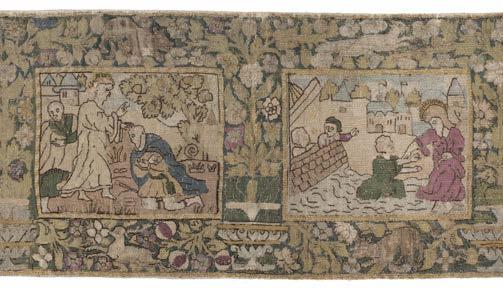
£4,000 - £6,000
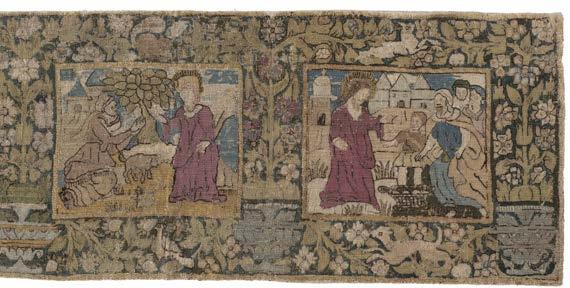


345* Embroidered Picture. A miniature oval picture of a beggar, circa 1790, his arm outstretched begging to a family by a cottage, the background with trees and a country house, hand-worked in coloured silks on a cream silk ground, using long and short stitch, and stumpwork, the faces and limbs finely delineated in ink, 8 x 9.5 cm (3 x 3.75 ins), period glazed gilt oval frame with hanging loop (11 x 13.5 cm)
(1)
£100 - £150
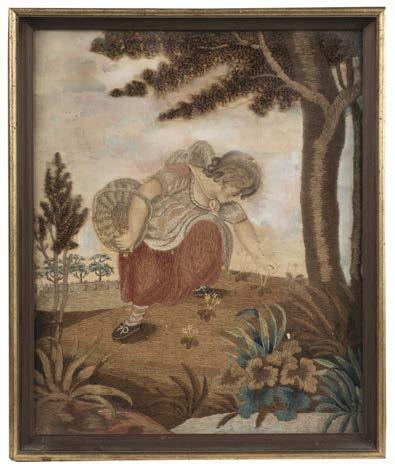
346* Embroidered Picture. A woolwork embroidery of a child picking flowers, circa 1810, worked in coloured wools on silk, in shades of blue, brown, green, and red, using long and short stitch, seed stitch, and stumpwork, depicting a small girl with a basket on her arm, picking flowers on a bank beneath a tree, her face and hair carefully delineated in sepia pen, ink, and watercolour, sky (with losses to silk ground) painted with watercolour, split in silk to face and arm, 37 x 30 cm (14.5 x 11.75 ins), framed and glazed (41 x 34 cm), together with 2 other framed and glazed textiles: a portion of pieced handembroidered linen, late 18th/early 19th century, worked with flower sprigs enclosed in lattice fronds, browned, 46 x 57.5 cm (18 x 22.5 ins); and a linen napkin with elaborate drawn threadwork pattern of a large quatrefoil enclosing hearts, 36 x 35 cm (14.25 x 14 ins) (3) £100 - £200

347* Embroidered Picture. Princess Iseult with the shield of Sir Tristram of Lyonesse, after Harry Theaker (1873-1954), circa 1925, appliqué and embroidered picture, worked in coloured silk threads, using stem stitch, latticework, satin stitch, and long and short stitch, incorporating couched gold metallic threads, depicting an Arthurian maiden with long hair and flowing robes, standing on the steps of a castle, holding a shield on which are 3 rampant lions, 2 birds in flight to her right, some scattered light foxing and marks, 80 x 57.5 cm (31.5 x 22.5 ins), glazed period oak frame (92 x 67 cm)
A well-executed needlework picture after Harry George Theaker’s illustration ‘The Princess Iseult with the shield of Sir Tristram of Lyonesse’, which appeared in Stories of King Arthur, retold by Blanche Winder, published by Ward, Lock & Co. in 1925. (1)
£150 - £200
348 Fabric. A small collection of early fragments, 16th-17th century & later, 13 pieces of voided velvet, brocade, and damask, variously patterned, in a variety of colours and shapes, some incorporating metallic threads, some pieces matching, including a 16th or early 17th century sleeve of pieced voided velvet (dark red on a gold ground) from a doublet or jacket, worn, a few pieces with labels attached (one stating ‘from John Fowler’s Collection’), various condition, smallest 14 x 10 cm (5.5 x 4 ins), largest 102 x 63.5 cm (40 x 25 ins), together with a length of early metallised tassel trim, 4.5 x 105 cm (1.75 x 41.25 ins) (15)
£300 - £500
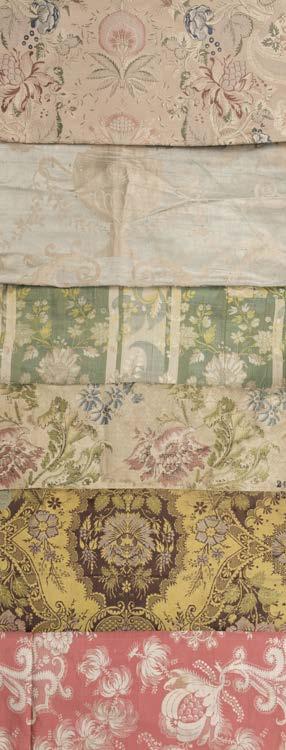

349 Fabric. A small collection of early fragments, 18th-19th century, 13 pieces of brocade or damask, with various floral patterns, in a variety of colours and shapes, the smallest incorporating gold metallic threads, 2 pieces matching (one stitch-mounted to a linen backing), most with old paper labels attached (mainly in French) and with old numeral ink stamps at edge, largest (a piece of pale blue and cream damask with flower urns) faded, and a couple of other pieces with splits (one with a few marks), but mostly in good condition, smallest 69 x 8 cm (27.25 x 3.25 ins), largest 50 x 53.5 cm (27 x 21 ins) (13)
£300 - £500
350* Figurine. A clothed articulated male mannequin, probably Continental, late 18th century, carved wooden figure with limbs articulated at shoulders, elbows, and knees, head with carved hair and sculpted features fixed half-profile to right, mounted on a painted wooden plinth, right arm detached, 2 fingers on left hand truncated, surface losses to paintwork on face, a few worm holes in feet, the figure dressed in contemporary attire consisting of a linen shirt with ruffle of hand-made lace, brown velvet knee breeches and cream velvet chaps, a yellow silk waistcoat with pocket flaps and 4 buttons, edged with purple silk, and a black damask double-breasted frock coat with 4 buttons to each side, lined with striped floral brocade, and edged with cerise thread, clothing somewhat dusty and worn, height 40 cm (15.75 ins)
Provenance: Private Collection, Derbyshire.
A most unusual survival, the purpose of which we have been unable to establish. It could have been used in a shop display, or as a travelling salesman’s prop, although perhaps more likely, given the stance and gesture of the figure, it could have been one of a number of figures in a tableau telling a story or portraying a scene. The National Trust property of Snowshill Manor in Gloucestershire has a mannequin not dissimilar (NT 1339162).
(1) £200 - £400
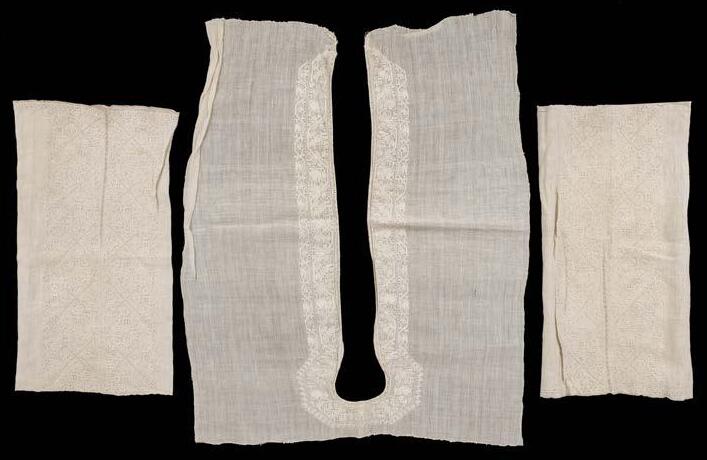
351 Greece. A collection of Greek island embroidered items, 18th-19th century, comprising: a blouse-front and pair of sleeves similar, both of fine self embroidery on handspun cream cloth, Mitylene, late 18th/early 19th century, one sleeve with pencilled label attached ‘Ex Walford Collection’, 1 x 1 cm area of slight fraying to left-hand side of blousefront, blouse 47 x 39.5 cm (18.5 x 15.5 ins), sleeves 33 x 18 cm (13 x 7 ins); a chasuble of Cretan embroidery, with all-over geometric pattern, hand-worked in blue, green, orange, red, and beige silk threads, and metallised thread, incorporating borders of metallised gold ribbon (that to outer edges removed and seams partially unpicked), on a beige linen ground, some losses, lined with pale pink linen stamped in ink ‘50’ (faded, a few holes and marks), 95 x 63 cm (37.5 x 24.75 ins); and other items related: a white cotton underdress with fine selfembroidery, Mitylene, some stains and historic pest damage; a wide-sleeved wedding blouse from Piestany, Slovakia, ornately stitched with orange eyelet and metalwork embroidery, woven label stitched inside neck ‘Salter Collection’, some small brown marks, underarms stained; a panel composed of two joined sleeve ends richly embroidered with camels; and some Turkish towels, borders, and other fragments, various condition and sizes (26)
£200 - £300
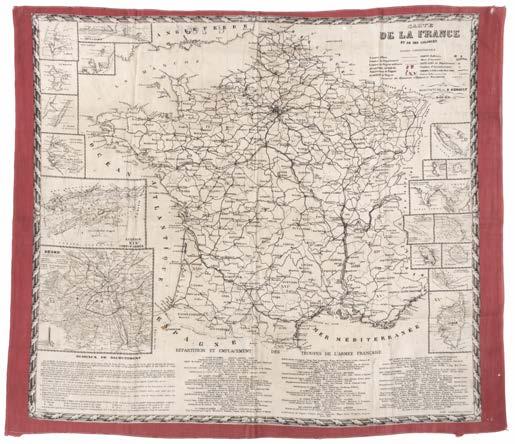
352 Handkerchief. Carte de la France et de ses Colonies, Rouen: Manufacture de E. Renault (fl. 1860-1890), printed in red and black on fine cream linen, with a large map of France, flanked by a number of smaller maps, titled upper right corner, and with text to lower margin: ‘Bureaux de Recruitement’; ‘Répartition et Emplacement’; and ‘Troupes de L’Armée Français’, foliate border, selvedges to sides, top and bottom edges machine-stitched, lightly toned, a few small holes (towards edge) and fox spots, 68 x 81 cm (26.75 x 32 ins), together with: Draughts, the Favourite Game of Our Soldiers in the Trenches and Our Sailors on the Sea, circa 1914, printed in brown and blue on cream twilled cotton, depicting a chequerboard against a background of army and navy scenes, within a border of draught pieces incorporating a vignette of a soldier on one side and a sailor on the other, a few fox spots, very small hole in lower left corner, 49 x 62.5 cm (19.25 x 24.5 ins), plus The Military Map of Aldershot and Surrounding Country, London & Aldershot: Gale & Polden, 1895, printed in black on fine linen, partially toned, and 4 British wartime escape maps printed on silk
For a similar handkerchief by E. Renault see: The Met, accession number: 1989.246.15.
This unusual handkerchief is in the same format as a series of thirteen ‘Mouchoirs Militaire D’Instructions’ patented by the commandant of the Rouen garrison, Pierre Perrinon, in 1875, and produced by E. Renault. Presumably the handkerchiefs were a useful tool for instruction in the period following France’s defeat in the Franco-Prussian War, when widespread conscription was re-introduced, providing as they did information about drill, kit, weapons handling, first aid for the wounded and other essential military topics in a durable and convenient format. Our map does not seem to be part of the numbered series, but also bears the name of manufacturer E. Renault, and details the structure of the French army beneath the map.
For the second item see: Imperial War Museum, catalogue number EPH 2594.
(7)
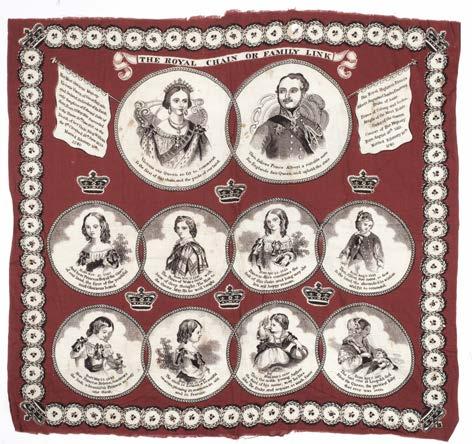
353* Handkerchief. The Royal Chain or Family Link, 1850s, cotton handkerchief printed in black on a red ground, with portrait medallions of Queen Victoria, Prince Albert, and 8 of their children, with explanatory text, crown motifs between, and a border of interlocking laurel wreaths encircling floral sprigs, selvedges to sides, top and bottom edges raw (and slightly frayed), some foxing, several small marginal holes, 69 x 76.5 cm (27.25 x 30.25 ins), together with 6 identical handkerchiefs commemorating Queen Victoria’s 60th Jubilee, printed with the Union Jack to upper left and an oval portrait of the Queen to lower right, some light marks, but generally in good condition, each approximately 53.5 x 63.5 cm (21 x 25 ins)
A rare commemorative handkerchief printed before Queen Victoria had her ninth and final child, Princess Beatrice, in 1857.
(7)
£200 - £400
£100 - £200

354* Hats. A collection of hats and bonnets, early 19th-20th century, 27 women’s and gentlemen’s hats, including: a ‘two hellos’ straw bonnet from Auvergne, France, with brim shaped under at the sides, and curled up at both front and back, trimmed with black velvet ribbon and blue cotton, and embellished with woven straw appliqués (broken in a few places, with some small losses), lined with blue cotton, 15 x 29.5 cm (6 x 11.5 ins); a straw coal scuttle bonnet, 21.5 x 25.5 cm (8.5 x 10 ins); and 3 gentlemen’s hats made by: Renaud, 2, Place de Marché; Robert Heath, 25, St. George’s Place, Hyde Park Corner; and J. Wippell and Co. Ltd., Exeter, various condition and sizes
Provenance: Private Collection, Derbyshire. (27)
£200 - £300

355* Huari. Pre-Columbian textile fragment, Peru, embroidered in polychrome threads on a canvas ground, depicting geometrical symbols, slightly faded and worn in places (losses consolidated with fabric), dimensions of largest extremities 43 x 33 cm (17 x 13 ins), carefully stitch-mounted onto cream cotton stapled to a wooden stretcher (53 x 44 cm), together with an Ikat, woven in pink and yellow, some light marks and stitched repairs where slightly frayed, 105.5 x 90.5 cm (41.5 x 35.75 ins), mounted on yellow fabric backed with cream fleece (127 x 113 cm) (2)
£200 - £300
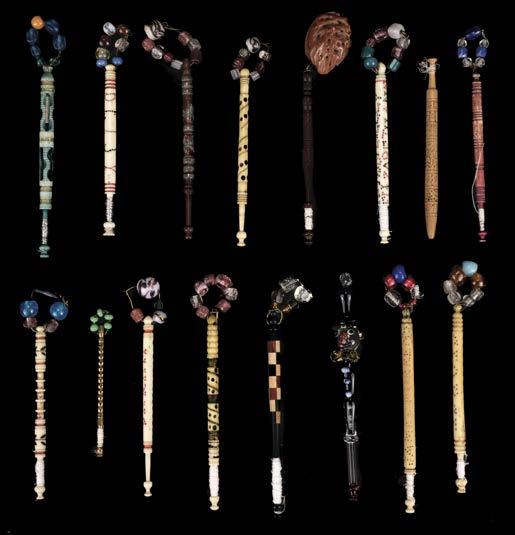
356* Lace bobbins. A large collection of lace-making bobbins, 19th-20th century, together 300+ hand-carved or turned bobbins, comprising approximately 66 bone, 30 brass, 13 blown glass, and 228 wood, including red or green stained, wire-wrapped, handpainted, pierced, coloured dots and bands, incised and applied ornamentation (including Bedfordshire tigers, leopards, and butterflies), many with spangles, one with a peach stone, others with buttons and large beads, a number of beads detached, some inscribed with lettering, including: Sarah, Betsy, Anna Lane and James [Purrens?], Susan, George, Elizabeth Ann Arnsby Lilley, R E 1838, length 11.5 cm (4.5 ins) and shorter (300+)
£200 - £300
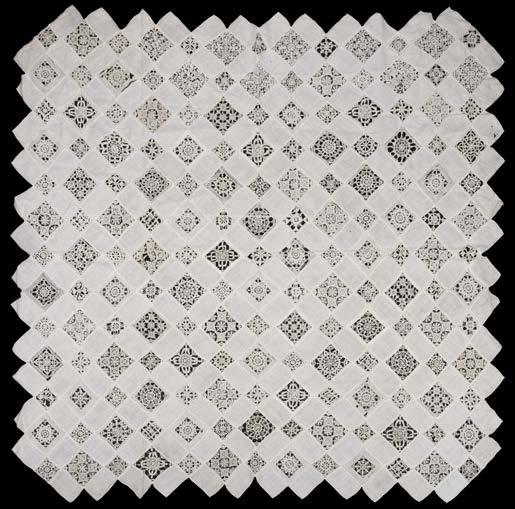
357* Lace. A cloth of needlepoint lace, Italy, circa 1700, chequerboard cloth of linen needle lace, composed of large and smaller squares alternating between plain linen rectangles, scattered small holes (a few areas with period darns), breaks in lace (with occasional small losses), and faint marks, neatly handstitched chevron edge, 137 x 135 cm (54 x 52.75 ins), together with a sepia photograph, circa 1920s, showing the cloth being used as a curtain, and a single sheet of typed provenance, signed by D.B. Grether and dated November 1979
Provenance: Purchased by Bendicht Hofstetter (died 1816); given to his son, Johannes Hofstetter (1794-1864); then to his son, Hans Hofstetter (18311903); then to his son, Ernst Wilhelm August Hofstetter (1876-1962); then to his daughter, Dory Grether-Hofstetter (born 1910); purchased by Peter J. Meyer; Private Collection, Derbyshire.
A rare survival, thought to have been originally intended for use on a dressing table, but later used as a curtain, as can be seen from the accompanying photograph. (1)
£400 - £600
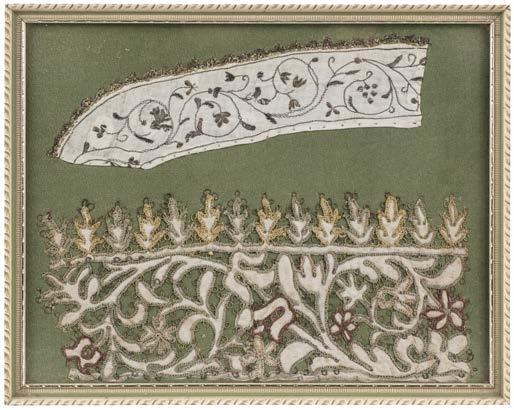
358* Lace. A polychrome embroidered cutwork border, probably Italian, 17th century, white linen, with arabesque decoration incorporating flowers and leaves, the cut edges embroidered in buttonhole stitch with green, pink, yellow, and cream silk threads, over gold metallised thread forming picots, 12 x 27.5 cm (4.75 x 10.75 ins), together with a portion of early metalwork embroidery on fine linen edged with metallic lace, probably part of a collar, 6 x 25 cm (2.25 x 9.75 ins), plus a small quantity of assorted lace, machine and hand-made, including lengths, collars, modesty panels, appliqués, etc.
(a small carton)
£100 - £150

359* Lace. A substantial collection of British and Continental lace, 18th-early 20th century, a large and varied collection of lace, both hand and machine-made, mostly white and cream, but also some black lace and one or two pieces of coloured lace, including handkerchiefs, collars, veils, modesty panels, sleeves and cuffs, lengths and wide flounces, shawls and tippets, mats and doilies, etc., e.g. a fine cotton lawn collar edged with Mechlin lace, a short train and matching pair of sleeves embellished all over with faux pearls, 6 lengths of wide canvas lace with blue or green fabric appliqués, a scalloped pelmet of net needlelace and embroidered cream satin appliqués, and a silk-lined reticule, many pieces pinned to tissue paper, together with some embroidered fragments, mostly whitework, including a tambourwork muslin apron, with scattered small sprigs and larger baskets of catkins, labelled ‘Apron worked by Margaret Manning at School. Mother of Harriet Jermyn’, various condition and sizes
Provenance: The collection of a lady who collected in the 1950s and 1960s. (3 cartons)
£700 - £1,000
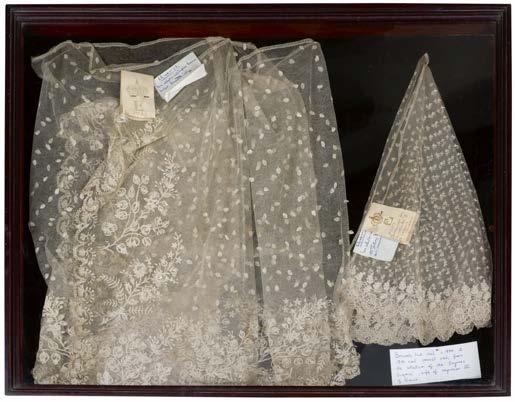
360* Lace. Brussels lace veil, and bonnet veil, belonging to Eugénie de Montijo (1826-1920, Empress of the French), cream lace veil of Brussels needle lace, with overall pattern of small leaves, and wide border of large floral sprigs, with scalloped edges, together with a bonnet veil of appliqué and needle lace, both hand-worked on machine net, each bearing a label ink stamped in gilt with the Empress’s cypher ‘E’ surmounted by a crown, mounted together in a wooden glass case (53 x 68 cm/20.75 x 26.75 ins), unexamined out of the case
Provenance: Private Collection, Derbyshire.
Eugénie de Montijo married Napoleon III on 30th January 1853, and was Empress until her husband was overthrown on 4th September 1870. From 28th July to 4th September 1870, she was the de facto head of state of France. This item would have been among the Empress’s vast collection of lace which was sold at auction when she died.
(1)
£200 - £300
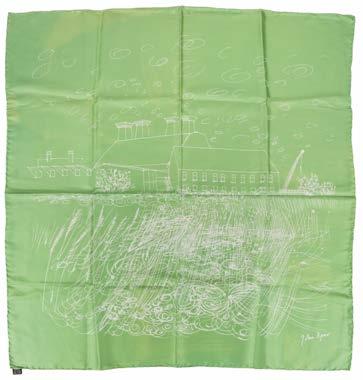
361* Piper (John, 1903-1992). Aldeburgh Scarf, screen-printed silk scarf, depicting Snape Maltings Concert Hall in white on an apple green ground, hand-stitched rolled hem, a few tiny marks to edge, 76 x 73 cm (30 x 28.75 ins), together with 4 other scarfs, including a Jacqmar green and white patterned scarf, and a V&A scarf ‘Vulcan Forging The Armour of Achilles’, and 2 handkerchiefs, one depicting printing processes, printed by W.A. Scholten, all in good condition, various sizes
Produced to celebrate the reopening of Snape Maltings Concert Hall following a devastating fire in 1969. Completed in 1970, the scarf was on sale from 1974 until 1981. Produced in several different colourways, this version is particularly striking.
(7)
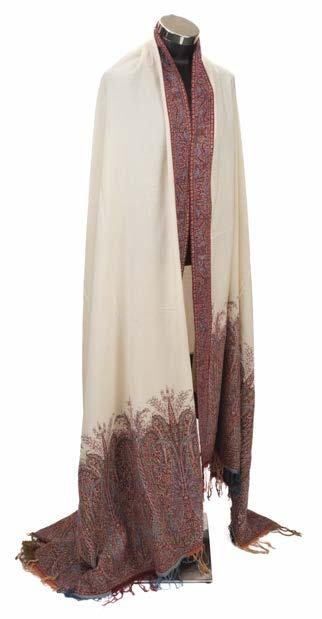
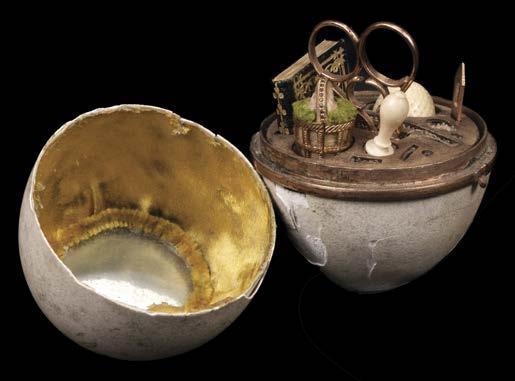
362* Sewing. A duck egg sewing etui, French, circa 1818, the real duck eggshell case with yellow metal hinged mount, opening to reveal miniature sewing accoutrements held in yellow metal compartments (some missing), comprising scissors, bone thimble, bodkin, stiletto, basket pin cushion, and a miniature book entitled L’Amour et les Belles, Pour L’Année 1818 A Paris (several full-page illustrations, original gilt decorated green morocco, slightly rubbed, 27 x 20 mm), lid lined with yellow silk and with inset circular mirror, egg cracked and fragile, with surface losses, and some small holes, lacking the metal stand, length 6.5 cm (2.5 ins) Sewing etuis made from real eggshells are rare for the obvious reason of their inherent fragility.
£150 - £200
(1)

£100 - £150

363* Shawl. A large Kashmir shawl, early 19th century, rectangular cream fine wool shawl, short ends woven with wide border of botehs and fleurons, in red, blue, green, and yellow, some minor colour run, narrow woven border to sides, fringed to short ends in red, green, orange, and blue (some losses), some scattered small threadbare areas and tiny holes, 142 x 305 cm (56 x 120 ins) excluding fringing
Provenance: Private Collection, Derbyshire.
(1)
£400 - £600
364* Shawl. A large woven crinoline shawl, circa 1860s, woven shawl with wide border of interlocking botehs and ogee niches, palmettes, and other motifs, in shades of red, olive green, turquoise, yellow, and white, on a central turquoise ground (latter with some scattered tiny holes and small marks), fringed border to short sides, occasional loss to fringing, and 2 small holes to one end (largest 2 x 2.5 cm), 152 x 339 cm (60 x 133.5 ins)
The turquoise ground of this large crinoline shawl is unusual and provides a striking contrast to the border.
(1)
£150 - £200
365* Shawl. A large woven crinoline shawl, circa 1860s, woven shawl patterned with botehs, arabesques, palmettes, and other motifs, in predominantly red and orange tones with black centre field, harlequin fringe gates to short sides, some losses to fringe but otherwise in very good condition, 164 x 330 cm (64.5 x 130 ins)
(1)
£100 - £150
366* Shawls. A large crinoline shawl, mid 19th century, woven soft wool shawl, with all-over pattern of botehs, palmettes, and other motifs, in muted shades of red, brown, and blue, polychrome fringing to short ends (with losses), a few very small holes and marks, 151 x 273 cm (59.5 x 109.5 ins), together with 2 other large crinoline shawls similar, one predominantly red tones, a few small inconspicuous marks, 162.5 x 343 cm (64 x 135 ins), the other red, green, and blue, with central ground of crimson one side and cream the other, scattered holes, 160.5 x 330 ins (63.25 x 130 ins), and a printed Paisley shawl, a few holes, 160 x 325 cm (63 x 128 ins)
Provenance: Private Collection, Derbyshire. (4)
£300 - £500
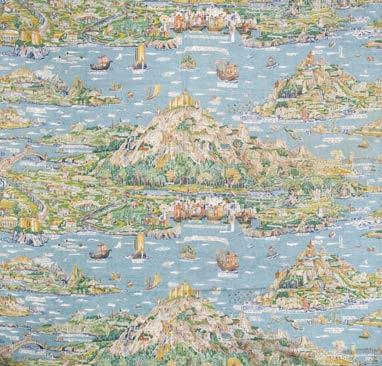
367* Sleigh (Bernard). A Map of Fairyland, Rosebank Fabrics, 1930s, a pair of nursery curtains and a portion of matching fabric, printed in polycrome on a white cotton ground, with a fantastical landscape, incorporating classical and Arthurian themes, nursery rhymes, and fairy tales, name of designer, title, and manufacturer printed in the selvedge, curtains gathered with rings sewn to rufflette tape, and hemmed by machine all round, lightly faded, leading edge of left curtain with several vertical tears extending 4 cm in from edge, leading edge of right curtain with horizontal tear extending 18.5 cm in from edge, fabric portion machine hemmed to sides, and with top and bottom edges raw, each curtain drop 113 cm (44.5 ins), width of lower hem 59 cm (23.25 ins), fabric portion 116 x 124.5 cm (45.5 x 49 ins) (3)
£150 - £200
368* Tapestry. A verdure tapestry of a country house, probably French, circa 1680-1720, woven in polychrome wools (faded), depicting a vista through trees of a large house with turret, and a church behind, a lake with waterfowl in the foreground, border of beribboned floral swags, with coronets at the corners, 4.5 cm vertical split in centre, verso of top and bottom edges hemmed with old green ribbon (worn), some old curtain rings to verso of top edge, verso of side edges hemmed with later cloth tape, 189 x 126 cm (74.5 x 49.5 ins), together with a small panel composed of verdure tapestry fragments, lightly faded, later hessian backing, brass curtain rings sewn along verso of top edge, 78 x 59 cm (30.75 x 23.25 ins)
Provenance: Private Collection, Derbyshire. (2)
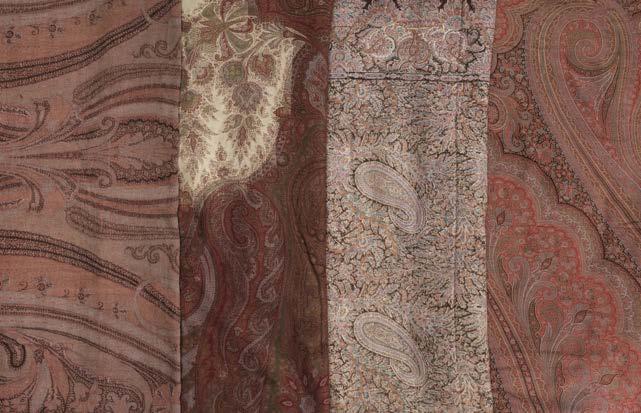
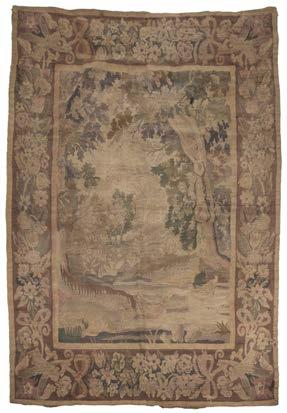
£300 - £500
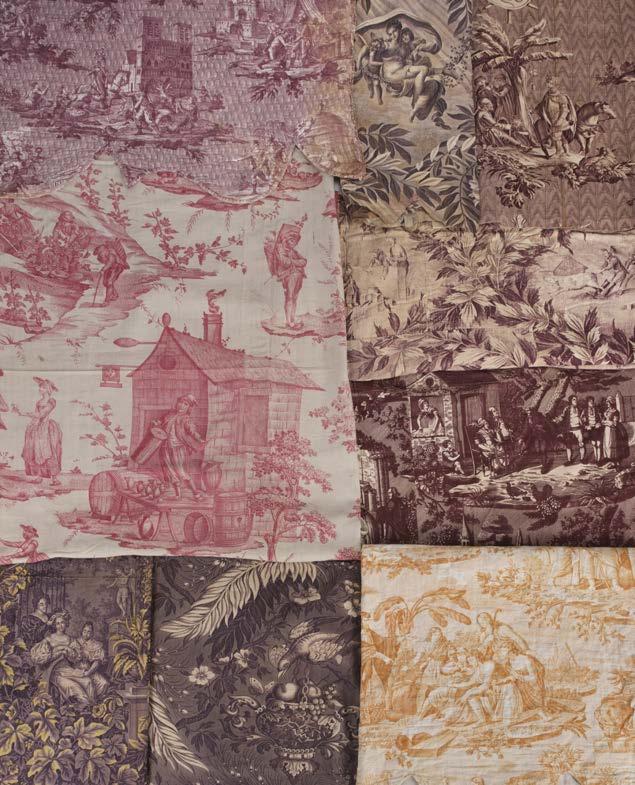
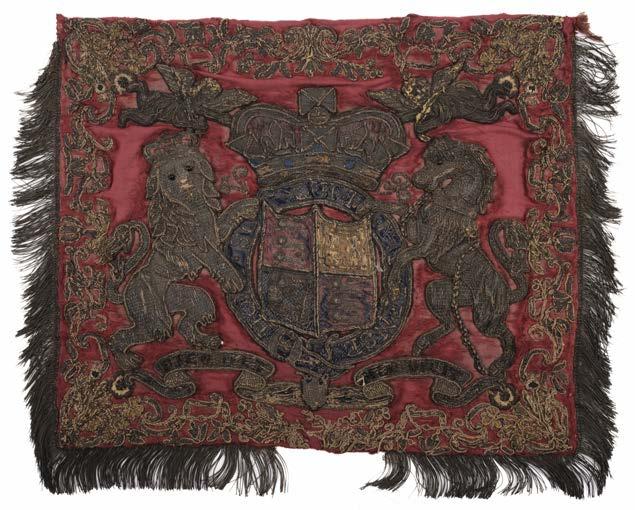
369* Toile de Jouy. A large and impressive collection, French, 18th-mid 19th century, 25 items of Toile de Jouy fabric, comprising large and small pieces, including a number of curtain pelmets and bed valances, some hand-quilted, pieced, and/or linen-backed, in a variety of colours (raspberry, purple, scarlet, yellow, brown), depicting various figures and scenes, buildings, and animals, such as genre, Biblical, historical, classical, etc., e.g. Joseph and His Brothers, French Revolution soldiers chasing a pig, children at play, marriage scenes, musicians, armoured knights, sailing ships, some pieces matching, various condition, largest (a linenbacked and quilted bedcover) 195.5 x 222 cm (77 x 87.5 ins), smallest (a deconstructed pelmet) 28 x 198 cm (11 x 78 ins) at largest points, together with 2 pieces of cotton, probably French, 18th century, printed in purple and cream (smallest piece partially faded), with large repeated pattern of an exotic bird and suspended basket of fruit amongst large stems and fronds, short ends gathered, some tears, 227 x 72.5 cm (89.5 x 28.5 ins) and 237.5 x 124.5 cm (93.5 x 49 ins), and 3 lengths of a wide printed floral border (28)
£1,000 - £1,500
370* Trumpet Banner. An heraldic ceremonial banner for the reign of Queen Victoria, 19th century, hand-embroidered in high relief using gold and silver metallised threads, and coloured threads, with the Royal coat-of-arms within the garter, supported by a lion and a unicorn with the Royal motto below, a crown above flanked by winged putti and Queen Victoria’s cypher ‘V R’, scrolling border with cornerpieces of shamrocks, thistles, and roses, on a crimson silk ground, somewhat dusty and worn, with some loose and lost threads, and ground perishing (some old repairs), dark blue grosgrain backing (soiled), 5 metal hooks along top edge, side and lower edges bordered with gold fringing (approximately 10.5 cm section lacking from lower edge), lacking tassels to top corners, dimensions excluding fringe 50.5 x 42 cm (20 x 16.5 ins)
Provenance: Private Collection, Derbyshire. Trumpet banners such as these, which are attached to the instruments that state trumpeters use to sound fanfares at ceremonial events, rarely come onto the market.
(1)
£500 - £800
371* Wallpaper. A collection of 18 samples, The Wallpaper Manufacturers Ltd, circa 1930-1940, woodblock colour print, various patterns, e.g. Roman artefacts, moulded ceilings (titled ‘Medici’ on verso), birds amongst flowering trees, Chinese influence, floral (titled ‘Gloxinia’ on verso), geometric patterns, including some repeated patterns in different colourways, some with ‘Lancastria line’ printed along edge, all with numbers ink stamped to verso and with stab holes along one side where previously sewn into a portfolio, some slightly frayed or chipped to edge, 51 x 51 cm (20 x 20 ins) and slightly smaller
The Wallpaper Manufacturers Limited, or WPM, established in 1899, was an amalgamation of a number of businesses which came to control 98% of the UK wallpaper production and distribution.
(18)
£100 - £200
372* Fan. The Mutiny of Aranjuez, London: Behrmann & Collman, November 1st, 1813, etching and aquatint in sepia on paper, depicting a tumult of soldiers and citizens in the square at Aranjuez, Spain, lettered beneath ‘Dia 19. de Marzo de 1808. En Aranjuez. Caida Y Prision del Principe de la Paz’, sheet size 27 x 52 cm (10.75 x 20.5 ins), laid down on paper (overall size 28 x 53 cm)
Schreiber Collection, p.72, 39 (unmounted).
An extremely rare fan leaf based on an engraving by Francisco de Paula Martí after Zacarías Velázquez entitled ‘Fall and Imprisonment of the Prince of Peace’, published in 1814. It depicts the Mutiny of Aranjuez, an uprising against King Carlos IV and his prime minister Manuel de Godoy, which took place in the town of Aranjuez, Spain, 17th-19th March 1808. The event, which is still celebrated annually in Spain, saw the fall of the monarch and the subsequent accession of his son Ferdinand VII. In the time leading up to the Mutiny Spain had been suffering from an economic crisis which was heightened after the country lost its navy at the Battle of Trafalgar in 1805. Furthermore, under the terms of the Treaty of Fontainebleau, the King and Godoy had allowed Napoleon’s troops to cross Spain to attack Portugal, an ally of England at the time, a move which was extremely unpopular with the Spanish people, threatening as it did the continuity of the Spanish monarchy, as French troops rapidly occupied important cities in Spain. England played a critical role in liberating Spain from Napoleon and removing Godoy from power, and this fan leaf was made in London for export to Spain.
(1)
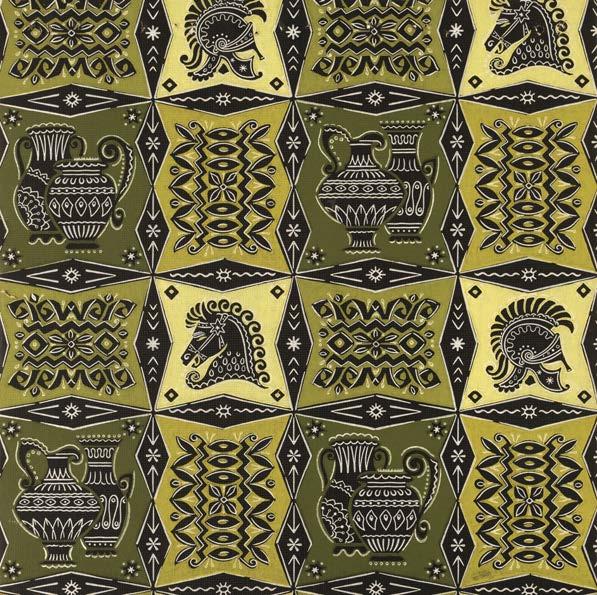
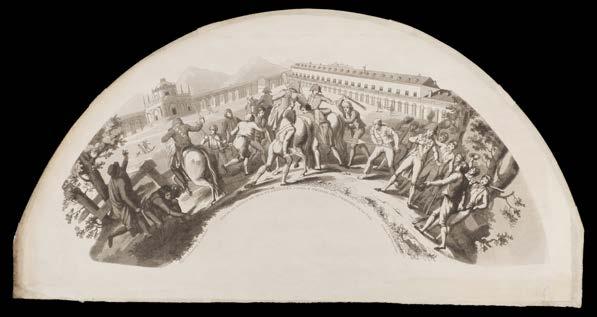
£200 - £300
373* Fans. A boxed ostrich feather court fan, early 20th century, folding fan of white curled ostrich feathers mounted on celluloid sticks, upper guard stick with applied gilt monogram ‘E.C.’, part of shaft of first feather missing, 49.5 cm (19.5 ins), housed in original ivory satincovered box (marked), together with 3 other boxed ostrich feather court fans similar (all with condition issues): a fan of cream feathers mounted on filigree mother of pearl sticks by J. Duvelleroy; a fan of peach feathers mounted on mother of pearl sticks, housed in a box covered with willow pattern fabric; and a fan of cream feathers mounted on celluloid sticks by J.C. Vickery, plus 2 Victorian corsets, one boxed Provenance: Private Collection, Derbyshire.
(6)
£100 - £200


374AR* Batterham (Richard, 1936-2021). A stoneware jug, covered in a green ash glaze, unsigned, incised clay body code to base, height 23.5 cm
(1)
£150 - £200

375AR* Bayer (Svend, 1946-). A large wood fired stoneware jar and cover, with green ash glaze to interior and cover, unsigned, height 25 cm
Provenance: Private Collection. (1)

376AR* Bayer (Svend, 1946-). A wood fired shallow stoneware dish, covered in shino and ash glaze, remnants of scallop shells to the well, diameter 26 cm, and a smaller wood fired stoneware bowl attributed to Bayer, shino and ash glaze, diameter 14 cm, both unsigned
Provenance: Private Collection. (2)
£150 - £200
£100 - £150
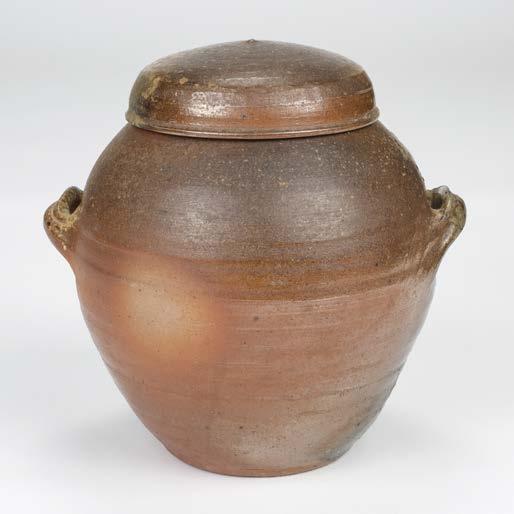
377AR* Bayer (Svend, 1946-). A wood fired stoneware twin-handled storage jar and cover, the interior with an ash glaze, unsigned, height 24 cm
Provenance: Private Collection. (1)
£100 - £150

378* Batterham (Richard, 1936-2021). A very tall two-piece stoneware bottle, 1980s, covered in an ash glaze, with chatter bands, unsigned, height 74 cm

379* Collins (Nic, 1958-). A tall wood fired stoneware tankard, covered in a shino and ash glaze, decorated with three incised birds, incised signature to base, height 16.5 cm, and a small stoneware bowl attributed to the same potter, shino and ash glazes, 15 cm diameter, unsigned, plus a similar sized stoneware bowl by Chuck Schwartz, incised initials
Provenance: Private Collection.
(3)
£80 - £120
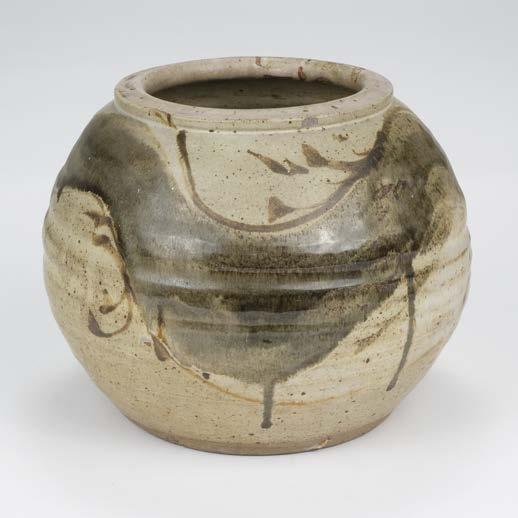
380* Collins (Russell, 1942-). A large globular stoneware vase, abstract decoration over a speckled grey glaze, impressed mark, height 24 cm (1)
£150 - £200
Provenance: From the Estate of Richard Batterham; purchased by the current owner from Woolley & Wallis, Studio Pottery from the Estate of Richard Batterham, 23 March 2023, lot 487. (1)
£1,500 - £2,000

381* Corser (Trevor, 1938-2015). A footed stoneware bottle vase with lugs, covered in a tenmoku glaze, impressed TC mark to base, height 27 cm
Purchased directly from the potter. (1)
£150 - £200
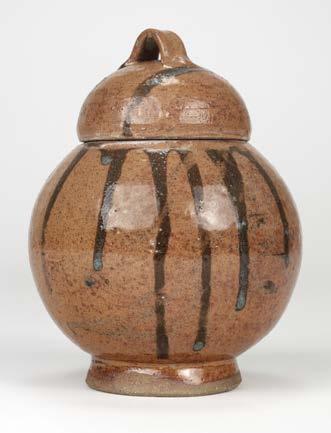
382* Corser (Trevor, 1938-2015). A footed stoneware jar and cover, covered in a light russet glaze, running cobalt to the lid and sides, impressed TC mark to the inside of the foot, height 22 cm
Purchased directly from the potter. (1)
£120 - £180
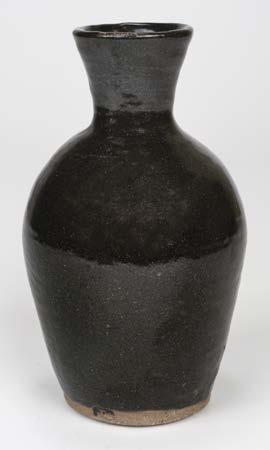
383* Corser (Trevor, 1938-2015). A stoneware bottle vase, covered in grey and cobalt glazes, impressed TC mark to base, height 27 cm
Purchased directly from the potter. (1)
£100 - £150
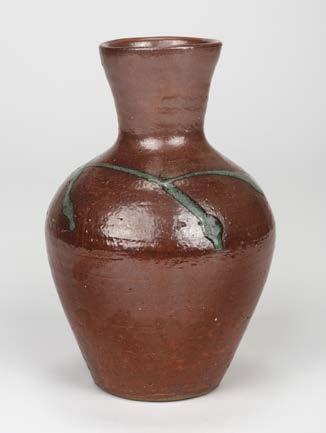
384* Corser (Trevor, 1938-2015). A stoneware bottle vase, covered in a kaki glaze with trailed oxide slip decoration, impressed TC mark to base, height 25 cm
Purchased directly from the potter. (1)
£150 - £200
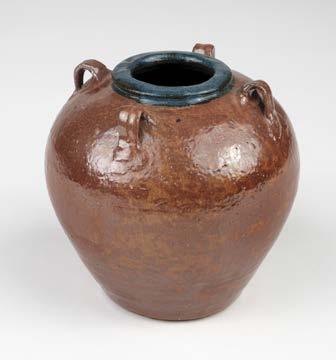
385* Corser (Trevor, 1938-2015). A stoneware jar with lugs, covered in a russet glaze, cobalt to the rim, impressed TC mark to base, height 16 cm
Purchased directly from the potter. (1)
£100 - £150
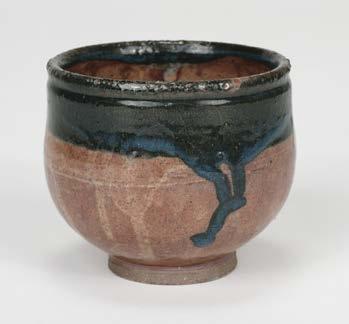
386* Corser (Trevor, 1938-2015). A stoneware tea bowl, covered in a russet glaze, running cobalt to the rim, impressed TC mark to base, height 9 cm
Purchased directly from the potter. (1)
£80 - £120
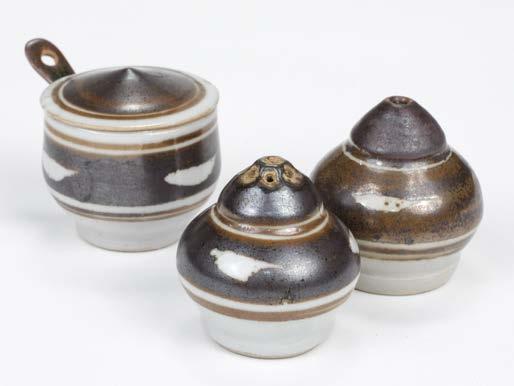
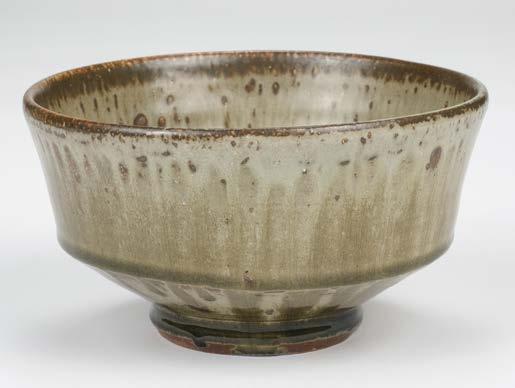
387* Davis (Harry, 1910-1986) and Davis (May, 1914-1998). A cruet set for Crowan Pottery, comprising a salt pot, pepper pot and lidded mustard pot with spoon, grey ground with iron and wax resist decoration, impressed CP mark (flooded in the mustard and salt pots), in very good condition, the tallest 4.5 cm
Provenance: Private Collection.
(3)
£50 - £80

388AR* Dodd (Mike, 1943-). A set of four early earthenware bowls, each with a similar design in oatmeal slip to the well, the rims also with the same glaze, incised mark to each base, small chips and nibbles to each rim, each approximately 16 cm diameter
Provenance: Private Collection.
These are Dodd’s earliest pots and were made when he was a pupil at Bryanston School. This has been confirmed by the potter. (4)
£100 - £150
389AR* Dodd (Mike, 1943-). A stoneware footed bowl, covered in a green ash glaze, impressed MJD mark (partially flooded) to base, height 11 cm, diameter 20 cm (1)
£100 - £150
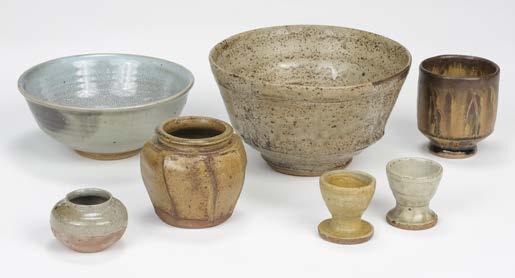
390AR* Dodd (Mike, 1943-). A stoneware yunomi, covered in an ash glaze, incised foliate decoration, impressed personal mark to base, height 9 cm, together with six early pieces by the same potter, including a deep bowl, green ash glaze with incised vertical and horizontal decoration, incised mark to base (before use of MJD mark), diameter 19.5 cm, a small faceted stoneware vase, height 8.5 cm, a stoneware bowl made at Jacob’s Cottage, celadon glaze, diameter 18 cm, plus a small bud vase and two egg cups
Provenance: Private Collection.
The potter has confirmed that the six early works are by him. (7)
£150 - £200
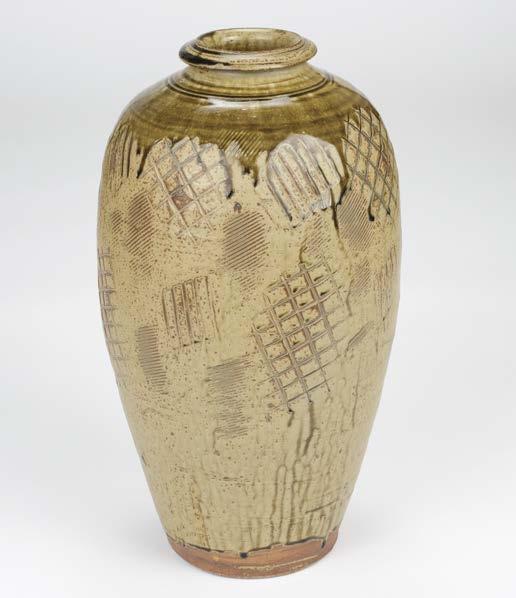
391AR* Dodd (Mike, 1943-). A large stoneware bottle vase, covered in a green ash glaze, running over the shoulders, impressed decoration, impressed mark to base, height 45.5 cm
Provenance: Private Collection.
(1)
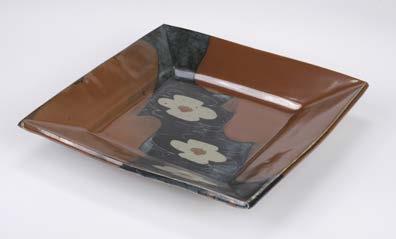
£300 - £500
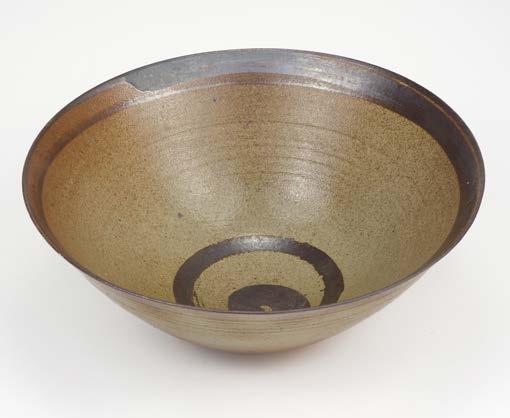
392* Hanssen Pigott (Gwyn, 1935-2013). A large salt glazed earthenware flaring bowl, covered in an ash glaze, with an iron oxide band to the rim and swirl to the well, impressed mark, diameter 42.5 cm (1)
£200 - £300
393* Frith (David, 1943-). A large square stoneware footed dish for Brookhouse Pottery, covered in a kaki and mottled blue and grey glaze with wax resist decoration, impressed marks to base (one flooded), diameter 34.5 cm (1)
£100 - £200
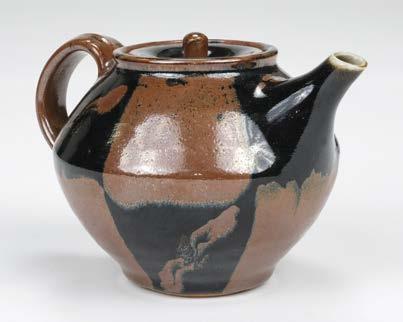
394* Frith (David, 1943-). Stoneware teapot for Brookhouse Pottery, kaki and tenmoku glazes with wax resist decoration, impressed personal mark below handle, height 12 cm
Provenance: Private Collection. (1)
£70 - £100
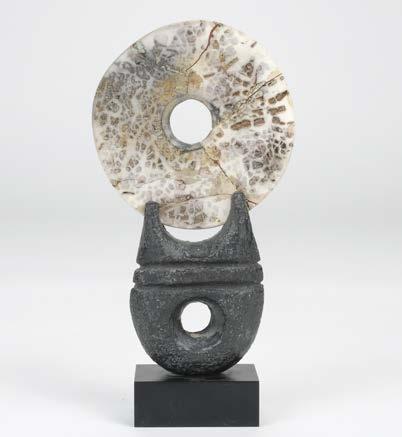
395AR* Hayes (Peter, 1946-). A fractured raku disc, 2011, mounted on a canal clay and slate base, etched signature and date, height 25.5 cm
Provenance: Private Collection. (1)
£150 - £200
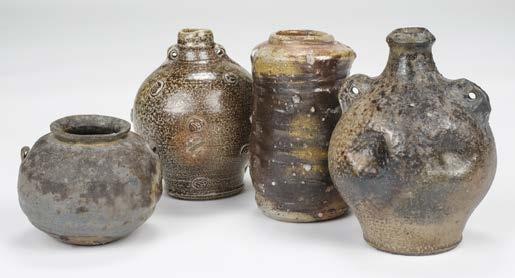
396* Hurn (Tim, 1964-). A wood fired salt glazed costrel, side fired on shells, repeated decoration, impressed mark to base, height 16 cm, with another similar lugged costrel by the same potter, impressed mark to base, height 17.5 cm, together with a squat lugged vase by Malcolm Jepson, impressed mark to base, and a cylindrical wood fired stoneware vessel by an unknown maker, partially covered in an ash glaze with feldspar inclusions, impressed K mark to base, height 16 cm
Provenance: Private Collection.
(4)
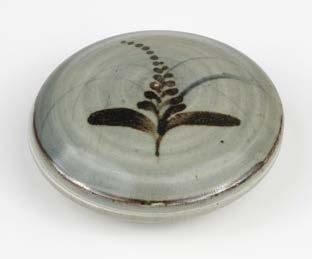
£80 - £120


397AR* Leach (Bernard Howell, 1887-1979). An early stoneware dish, mid to late 1930s, covered in a celadon glaze, impressed early BL and Leach Pottery marks, professional restoration to rim, diameter 15.5 cm (1)
£150 - £200
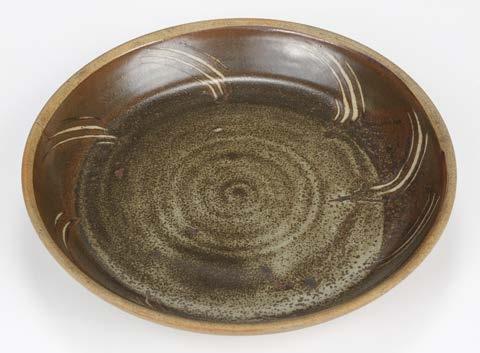
398AR* Leach (David, 1911-2005). A large shallow stoneware bowl for Leach Pottery, tenmoku with wax resist combed motifs, impressed personal mark and Leach Pottery mark, diameter 32 cm (1) £100 - £150
399AR* Leach (David, 1911-2005). A porcelain lidded box, light blue celadon glaze with painted foxglove motif, impressed DL mark to base, diameter 10.5 cm, height 4.5 cm (1)
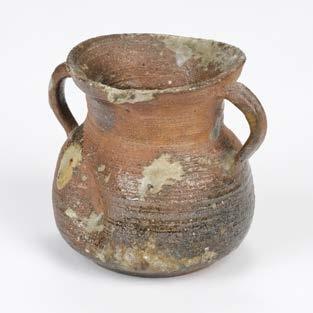
£150 - £200
400* Leach (Janet, 1918-1997). A small twin handled stoneware vase, with indented sides, abstract glaze decoration, impressed personal and Leach Pottery marks, height 8.5cm
Provenance: Private Collection.
(1)
£80 - £120
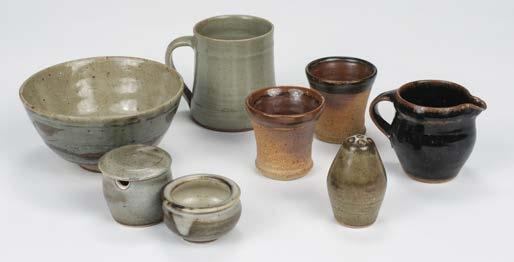
401* Leach Pottery. A porcelain cruet set, circa 1950s, comprising of an open salt pot, pepper pot and lidded mustard pot, mottled grey and brown glaze (possibly ‘B’ glaze), each with impressed pottery mark and England stamp (marks partially flooded in pepper and salt pots), the tallest 7.5 cm, a few small chips to base of mustard pot otherwise excellent, together with three further Leach Pottery items, a stoneware Z bowl, covered in speckled grey glaze with a band of pale blue and iron decoration, impressed pottery mark, 14 cm diameter, a small stoneware cream jug, tenmoku glaze, height 7.5 cm, impressed mark (flooded), a stoneware half pint beer tankard, covered in a celadon glaze, impressed mark below handle, plus two Muchelney Pottery beakers, each 7 cm in height
Provenance: Private Collection.
(8)
£80 - £120
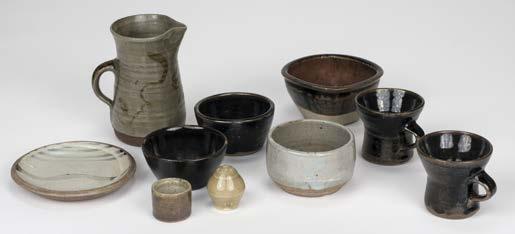
402* Leach Pottery. A small stoneware decorated cake dish, with wave design, impressed mark to base, diameter 15 cm, together with two coffee mugs, each covered in tenmoku glaze, impressed marks to base, both 8 cm high, and seven further items, four bowls (one made by Ian Steele), an egg cup, a lemonade jug (repaired) and a Crowan Pottery porcelain pepper pot (10)
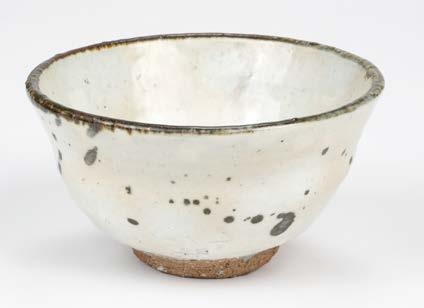
405* Lee Kang-Hyo (1961-). A punch’ong stoneware bowl, with iron oxide decoration, incised mark, 15 cm diameter
£100 - £150
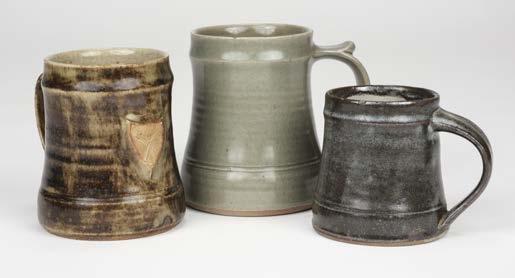
Provenance: Private Collection. (1)
£100 - £150
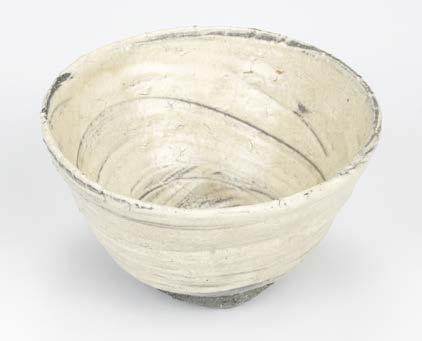
£80 - £120
403* Leach Pottery. A stoneware beer tankard, with applied coat of arms depicting a gun and fishing rod, indistinct incised mark to base, impressed Leach pottery mark, height 12 cm, together with two further Leach standard ware tankards, impressed marks (3)

404* Lee Kang-Hyo (1961-). A deep punch’ong stoneware bowl, incised marks to base, diameter 27.5 cm
Provenance: Private Collection. (1)
£150 - £200
406* Lee Kang-Hyo (1961-). A deep punch’ong stoneware bowl, incised mark, 16 cm diameter
Provenance: Private Collection. (1)
£100 - £150

407AR* Malone (Jim, 1946-). A large cut-sided stoneware bowl, covered in a tenmoku glaze, the interior ash, impressed JM and A (for Ainstable) marks, height 15.5 cm, diameter 30.5 cm (1)
£150 - £200
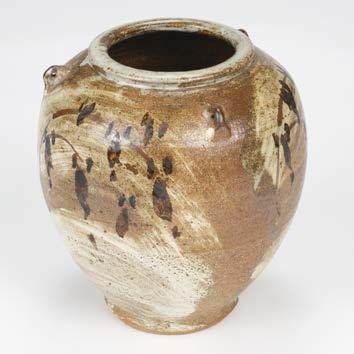
408AR* Malone (Jim, 1946-). A large lugged stoneware jar, with hakeme slip and iron decoration, impressed JM and A (for Ainstable) marks, height 25 cm
Provenance: Private Collection.
(1)
£200 - £300
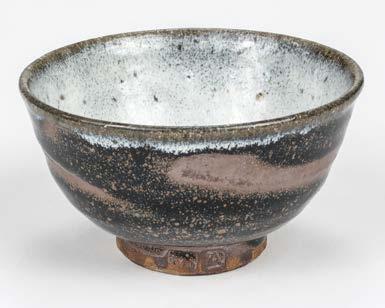
409AR* Malone (Jim, 1946-). A stoneware bowl, tenmoku with wax resist decoration, nuka glaze to the interior, impressed JM and A (for Ainstable) marks, diameter 14 cm
Provenance: Private Collection.
(1)
£70 - £100

410AR* Malone (Jim, 1946-). A stoneware Korean bottle, covered in tenmoku with wax resist decoration, running nuka to neck, impressed JM and A (for Ainstable) marks, repair to rim, height 26 cm
Provenance: Private Collection.
(1)
£150 - £200

411AR* Malone (Kate, 1959-). Seed Pod, circa 1994, double-walled stoneware vessel in the form of a seed pod with three wells, glassy green, yellow and ochre crystalline glazes, pooling in each well, length 36.1 cm
Maak, Pioneer Potters | Modern + Contemporary Ceramics, 14 to 17 November 2022, lot 279 (1)
£200 - £300

412* Maroger (Daphné, 1962-). A large black stoneware rectangular platter, enamel and oxide abstract decorations against a white crawling glaze, number five from the series ‘L’eau, le vent, la terre’, impressed mark to base, approx. 49.5 cm x 32. 7 cm, with an exhibition catalogue ‘Objects of Intention / Daphné Maroger’ “The series Water, Wind, Earth is inspired by English rectangular dishes decorated with slips (17th-18th centuries), crossed horizontally by a very fluid decoration. I took up the theme of fluidity: waves, currents, or even dune reliefs produced by the wind, cross my dishes in the same way. The raw materials have something archaic, coming from the depths of time” from the website of Daphné Maroger (translated from the original French) (1)
£100 - £150
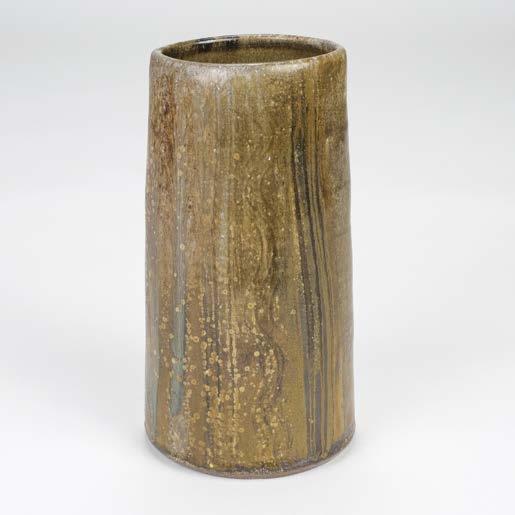
413* Melbourne (Mark, 1964-). A tall stoneware vessel, covered in ash and running iron glazes with subtle finger wipe decoration, unsigned, height 28 cm
Provenance: Private Collection.
(1)
£70 - £100
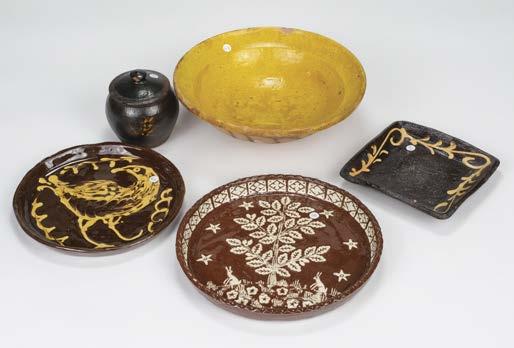
414* Earthenware. A collection of nine vessels, including a dish by Clive Bowen, yellow slip decoration on a brown ground, unsigned, 18 cm diameter, together with a small earthenware jar and cover attributed to the same potter, slip decorated, repair to the rim of the lid, and a chip to the handle, unsigned, height 12 cm, together with seven further pots by or attributed to Deborah Mitchell, Scott Garrett, and Josie Walker, painted or incised marks, forms include dishes, lidded jars and a jug
Provenance: Private Collection. (9)
£100 - £150
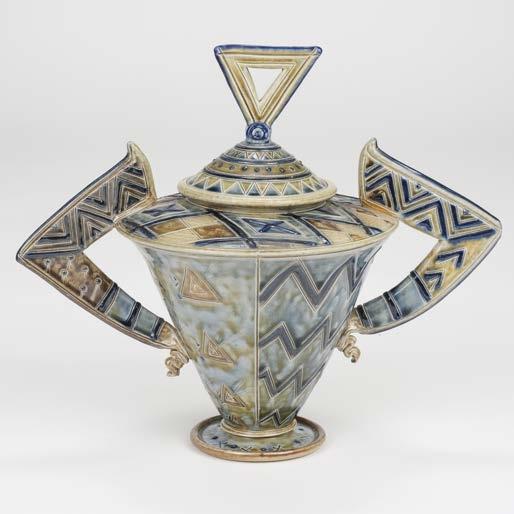
415* Osborne (Andrew, 1956-). A large salt glazed conical jar and cover, mid 1980s, intricately decorated with numerous incised patterns, including zig-zag, chevrons and crosses, incised AO to base of one handle, repair to cover, height 33 cm
Purchased from Bristol Guild of Applied Art Ltd., Park Street, Bristol. (1) £80 - £120
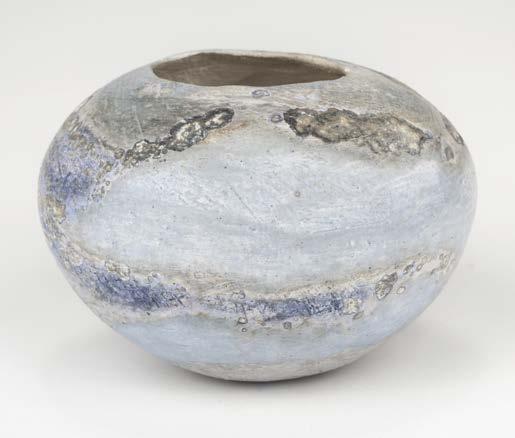
416AR* Owen (Elspeth, 1938-). A mottled earthenware round vase, smoke fired, heavily textured with a rounded base, layered slips in cream, grey and blues, height 9 cm, diameter 13 cm, together with a mottled earthenware sphere with rattle, smoke fired, layered slips in cream, grey and blues, height 6.5 cm, diameter 7 cm, with two Oxford Ceramics Gallery Elspeth Owen exhibition catalogues (2) £200 - £300
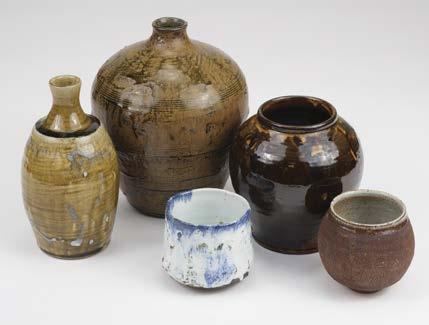
417AR* Ford (Kim). A wood fired stoneware bottle, covered in an ash glaze with incised decoration, impressed KF mark, height 25 cm, together with another stoneware bottle by the same potter, ash glaze with inclusions, impressed mark, height 21 cm, and three other pots by Douglas Fitch, Tom Kowles Jackson and Steve Booton, impressed marks (5)
£80 - £120
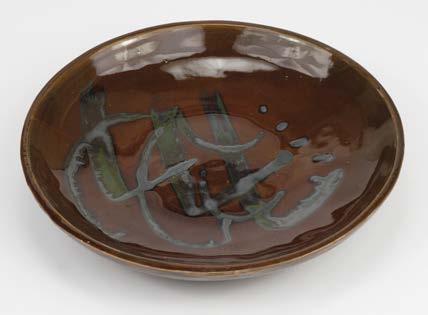
418* Owen-Jones (George, 1916-1997). A shallow stoneware charger, covered in a kaki glaze, with trailed iron oxide decoration to the well, incised signature to base, diameter 31 cm (1)
£80 - £120
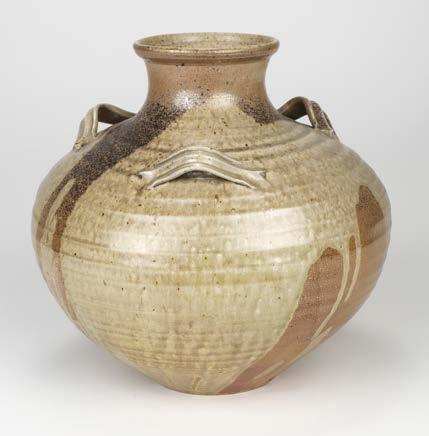
419* Prindl (Chris, 1968-). A large wood fired globular stoneware jar with handles, salt glazed, with additional running green ash glaze, impressed CAP mark, height 32 cm (1)
£200 - £300
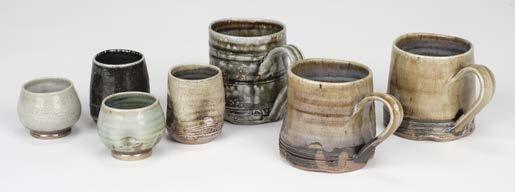
420* Prindl (Chris, 1968-). A selection of salt glazed drinking vessels, including three dimpled stoneware mugs, each covered in an ash glaze, incised decoration, impressed marks, the tallest 9.5 cm high, together with two dimpled cups and two dimpled guinomi by the same potter, each with impressed or incised marks (7)
£80 - £120
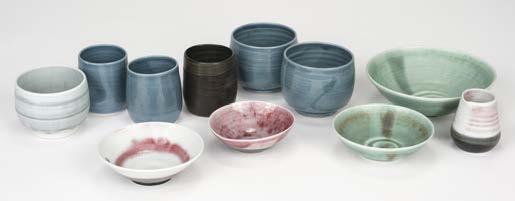
421* Prindl (Chris, 1968-). Various stoneware and porcelain vessels, including two stoneware yunomi, covered in blue glaze, incised marks, height 7.5 cm, and another example in porcelain, three ‘thumbcups’, four porcelain bowls in celedon and oxblush glazes, the largest 16 cm in diameter, and a porcelain pourer, each with incised marks (11)
£100 - £150
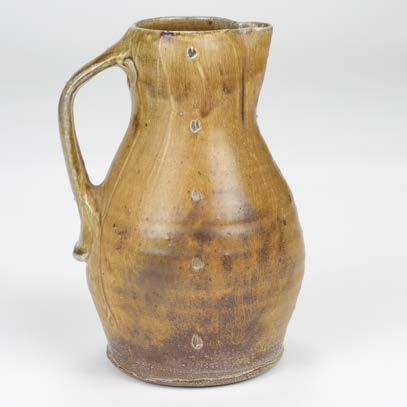
422AR* Rogers (Phil, 1951-2020). A salt glazed bellied jug, covered almost entirely in brushed slip, with incised decoration, impressed PR and MP (for Marston Pottery) marks, height 24.5 cm
Provenance: Private Collection. (1)
£100 - £150
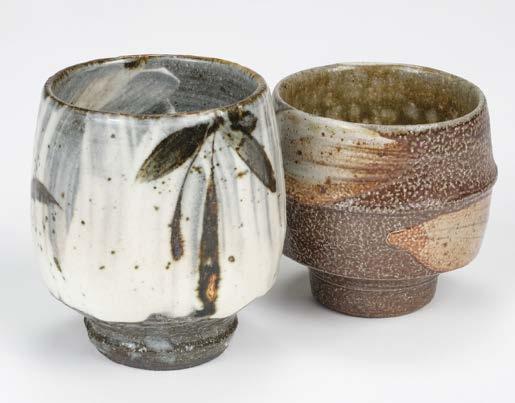
423* Rogers (Phil, 1951-2020). A stoneware yunomi, covered in brushed slip with iron decoration, impressed PR mark, height 10 cm, and a slightly smaller example, salt glazed with brushed slip decoration breaking to green ash glaze, impressed PR mark, height 8.5 cm
Provenance: Private Collection.
(2)
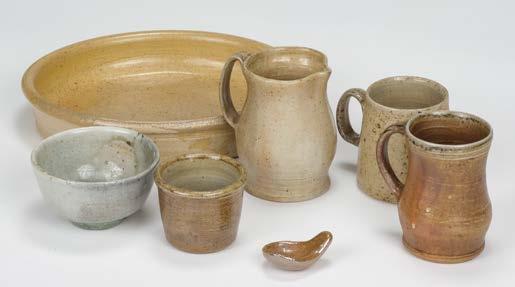
425* Schloessingk (Micki, 1949-). A salt glazed oval stoneware dish, yellow slip to the interior, impressed mark, 27.5 cm diameter, and a wood fired salt glazed mug, impressed mark, height 11.5 cm, together with two further salt glazed pots by Sarah Walton, a small jug and mug, both with impressed marks, the tallest 12 cm, plus a small soda glazed bowl attributed to Lisa Hammond, unsigned, 11 cm diameter, and a small salt cellar and spoon by an unknown maker
Provenance: Private Collection.
(6)
£80 - £120

424* Ruggles (Will, 1956-) and Rankin (Douglass, 1948-). A wood fired stoneware pitcher for Rock Creek Pottery, covered in a yellow slip breaking to ash, with repeated dot and drip pattern, impressed mark, height 20 cm, and a footed bowl with lid, repeated dot pattern to the bowl, impressed mark, 15.5 cm diameter, plus a smaller footed bowl, shino glaze breaking to ash, impressed mark, 9.5 cm diameter
Provenance: Private Collection.
(3)
£70 - £100
£80 - £120
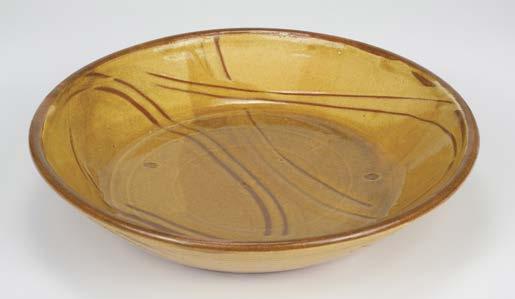
426* Slipware. A very large earthenware dish, covered in dark brown and mustard glazes, with fish and foliate decoration, unsigned, diameter 42 cm (1)
£150 - £200
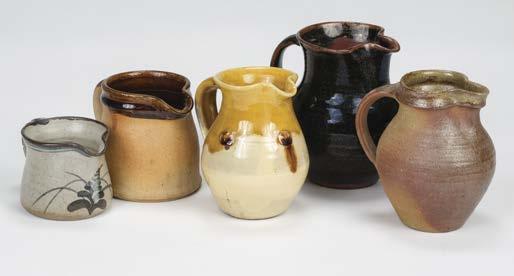
427* Studio Pottery. A collection of jugs, including a Lowerdown Pottery stoneware jug, decorated with foxglove motif on grey ground, impressed mark, height 7 cm, and others by or attributed to Scott Marshall, Winchcombe Pottery, Russell Gibbs, impressed marks, various sizes
Provenance: Private Collection.
(5)
£50 - £80
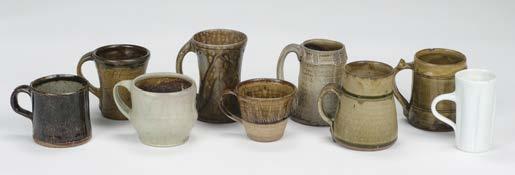
428* Studio Pottery. A collection of nine mugs, various makers including Wenford Bridge, Mark Hewitt, Charlie Collier, Joanna Howells, Josh Copus, impressed marks, various sizes and conditions
Provenance: Private Collection.
(9)
£70 - £100

429* Studio Pottery. A collection of stoneware yunomi and beakers, eight in total, impressed, painted or incised marks, all in good condition, various sizes
Provenance: Private Collection.
(8)
£80 - £120
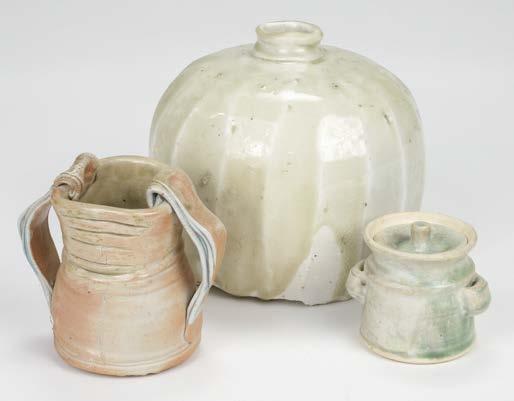
430* Studio Pottery. A collection of various ceramics, including two stoneware vessels by Gary Wood, the tallest 13 cm, a stoneware pestle and mortar by Jano Clarke, a stoneware mug by Richard Andrews, a porcelain beaker by Debbie Prosser, and other forms by various makers, impressed or incised marks
Provenance: Private Collection.
(approx. 24)
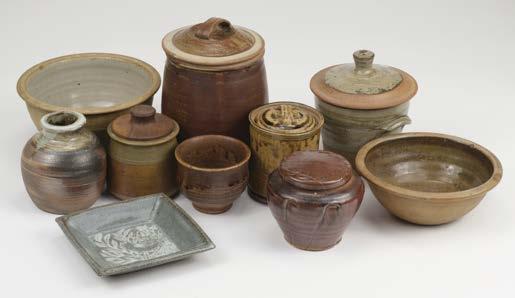
431* Studio Pottery. A collection of various stoneware ceramics, including a small stoneware dish by Hajeong Lee Rogers, wood fired with inlaid white slip, impressed mark, 17 cm diameter, a stoneware store jar and cover by John Davies at Crochendy Gwynedd Pwllheli, green ash glaze, incised decoration, height 18 cm, and a smaller ginger jar by the same potter, lid repaired, height 12 cm, and other forms by various makers
Provenance: Private Collection.
(10)
£100 - £150
£80 - £120
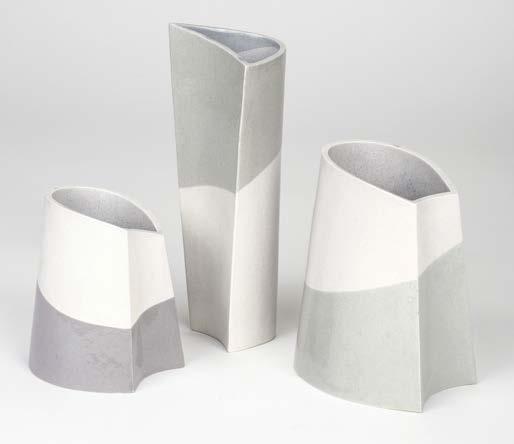
432* Studio Pottery. Three slab vases, each covered in a mottled grey glaze with an additional band of blue celadon or lavender glaze, incised or pained RS mark, the tallest 23 cm (3)
£70 - £100
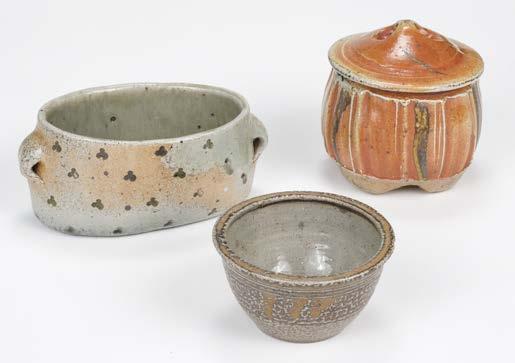
433* Tudball (Ruthanne, 1948-). A faceted stoneware jar and cover, covered in a soda glaze, impressed RAT mark, height 14 cm, together with two further soda glazed items, an oval stoneware vessel by Sabine Nemet, repeated stamp decoration, green ash glaze to the well, impressed SN to base, approx. 20 cm in length, and a small stoneware bowl by Peter Starkey, a few chips to rim, unsigned, 12.5 cm diameter
Provenance: Private Collection. (3)
£80 - £120
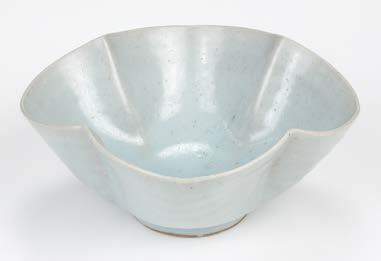
434AR* Walford (James, 1913-2003). A stoneware bowl, scalloped sides and rim, covered in a celadon glaze, impressed JW mark to base, 20.5 cm diameter
Provenance: Private Collection. (1)
£70 - £100
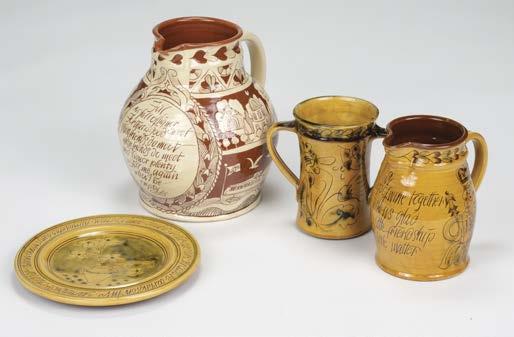
435* Wondrausch (Mary, 1923-2016). A large bellied earthenware jug, incised decoration with accompanying text ‘Fill me full of liquor for that is good...’, incised MW, Wharf Pottery label, chip to spout, height approx. 24 cm, with a smaller bellied jug, incised decorations on an ochre ground, with the text ‘a cup of wine together will make us glad...’, incised MW, remnants of a Wharf Pottery label to base, height 18 cm, and two further Wharf Pottery items, a twin-handled earthenware cup and a cheese plate (4)
£100 - £150

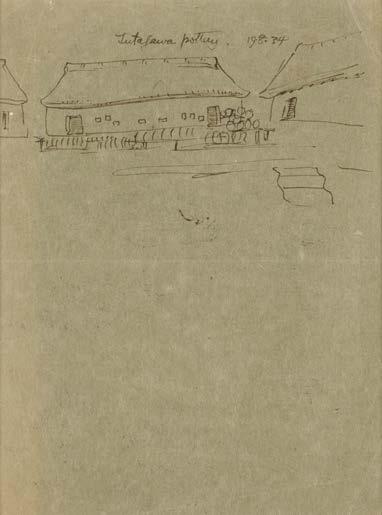
436AR* Leach (Bernard Howell, 1889-1979). Technical throwing instructions, 1934, pen and ink on blue paper, additional drawing in ink of a Japanese pottery to verso, and dated ‘19.8.34’, gallery label to frame verso, mount aperture recto and verso 20.5 x 15.5 cm (8 x 6 ins), framed and double glazed (34 x 30 cm) (1)
£200 - £300

437AR* Leach (Bernard Howell, 1889-1979). Kiln technical drawing, ink, pen and pencil on buff paper, gallery label to frame verso, mount aperture 22.5 x 18.5 cm (9 x 7 1/4 ins), framed and glazed (34 x 30 cm)
(1)
£200 - £300
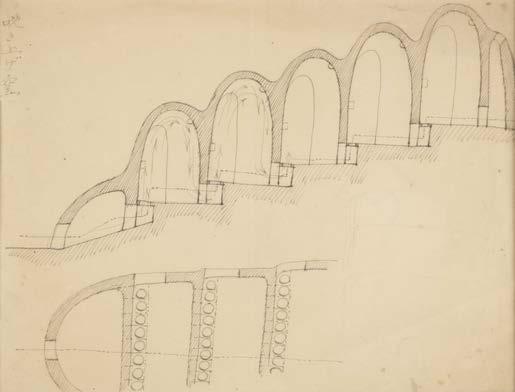
438AR* Leach (Bernard Howell, 1889-1979). Japanese Climbing Kiln, pen, ink and paper on buff paper, gallery label to frame verso, mount aperture 18 x 23.5 cm (7 x 9 1/4 ins), framed and glazed (32 x 37.5 cm)
A very similar version of this kiln design can be found in the ‘Kilns’ section of A Potter’s Book, Unicorn Publishing, page 239 (page 184 in the older Faber editions).
(1)
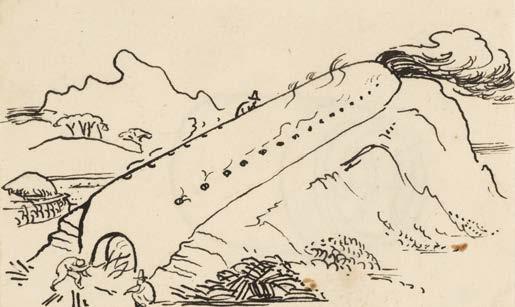
439AR* Leach (Bernard Howell, 1889-1979). Communal Korean Kiln, pen and ink on wove paper, with an additional ink drawing underdrawn in pencil to the sheet verso, possibly of a raku kiln, gallery label to frame verso, sheet size 6.8 x 11.5 cm (2 1/2 x 4 1/2 ins), framed and glazed (29.5 x 34 cm)
£200 - £300
An almost identical version of this kiln design can be found in the ‘Kilns’ section of A Potter’s Book, Unicorn Publishing, page 239 (page 184 in the older Faber editions). (1)
£200 - £300
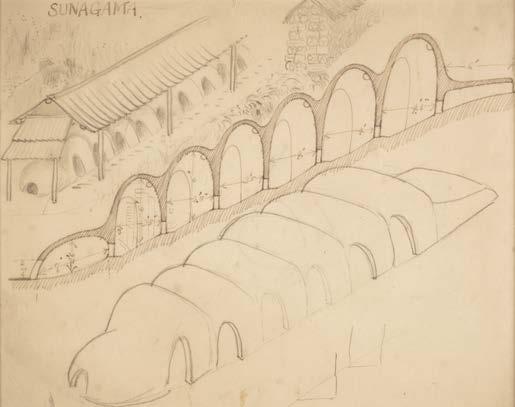
440AR* Leach (Bernard Howell, 1889-1979). Climbing Kiln ‘Sunagama’, pencil and ink on buff paper, gallery label to frame verso, mount aperture 19 x 24 cm (7 1/2 x 9 1/2 ins), framed and glazed (32 x 37.5 cm) (1)
£200 - £300
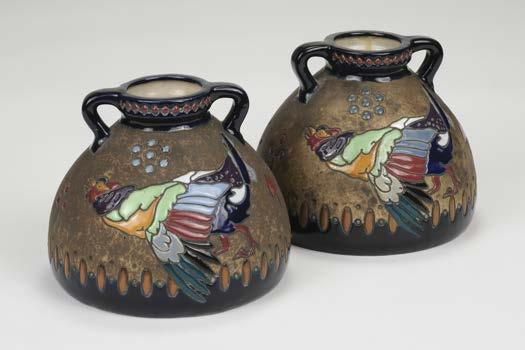
441* Amphora Pottery. A pair of twin handled ovoid Campina pattern vases, each decorated with a cockerel and flowers in raised enamel, impressed marks to base including Royal Crown, Amphora, Austria and serial number, 18 cm high, 22 cm diameter (2)
£100 - £150
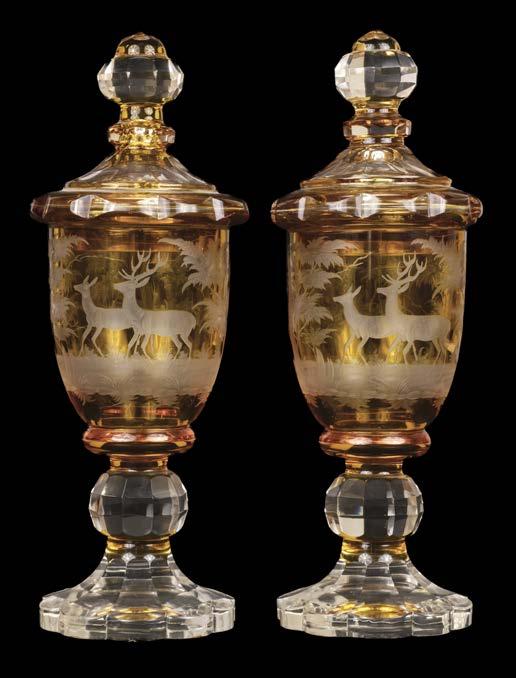
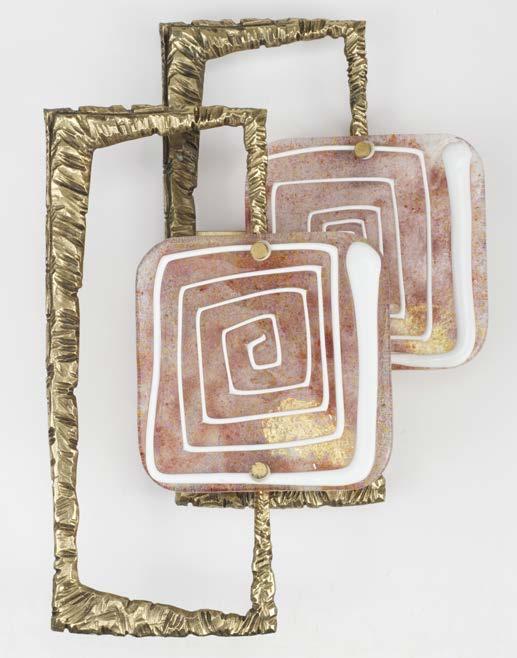
443* Brotto (Angelo, 1914-2002). Wall Light, circa 1960, bronze and Murano glass, designed for Esperia, produced by Vistosi, with original wall mount, 52.5 × 37 × 14 cm, requires rewiring
A pair of similar wall lights sold recently at Artcurial's Design Italien sale, Paris, 30 October 2023, lot 130 for €5,900. (1)
£300 - £500
444* De Morgan (William, 1839-1917). An early Fulham period Persian ovoid pottery vase decorated by Joe Juster, birds and foliage sprays in aubergine, green, turquoise and blue on a white ground, impressed mark, painted ‘JJ’ to base, 8.5 cm high, light crazing, very small areas of wear to rim
Provenance: M. D. E. Clayton-Stamm, thence by family descent.
This vase is illustrated in colour in William Gaunt and M. D. E. Stamm, William De Morgan, (London: Studio Vista, 1971), item 72, page 92. (1)
£2,000 - £3,000
442* Bohemian Glass. A pair of Bohemian cut glass pedestal vases and covers, 19th century, amber glass and engraved with stags and trees, minor chips to the inner rim of covers, 29 cm high (2)
£150 - £200
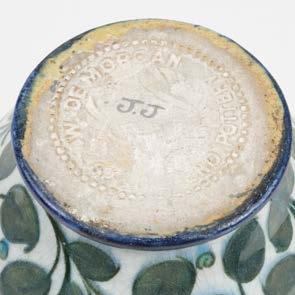
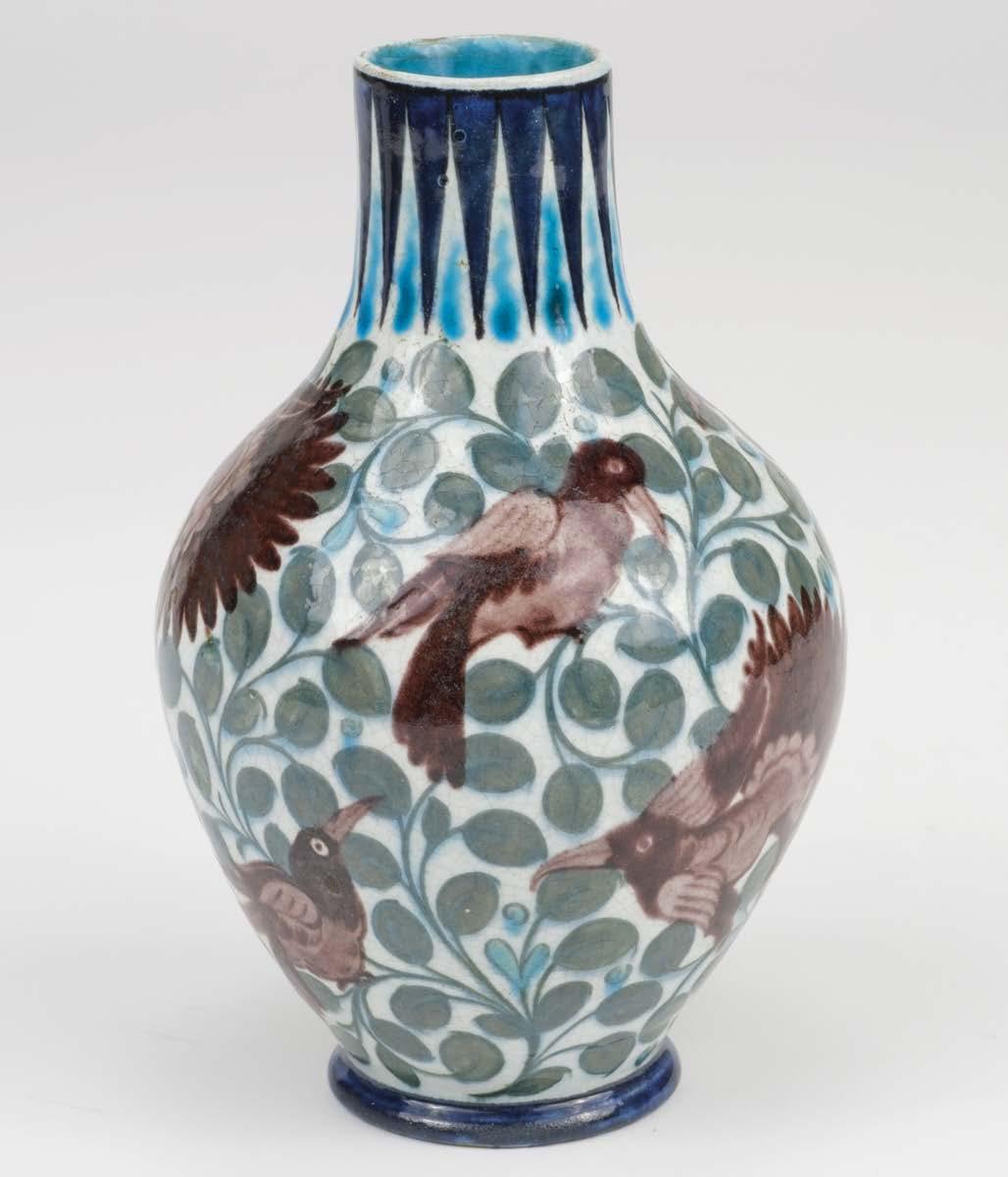

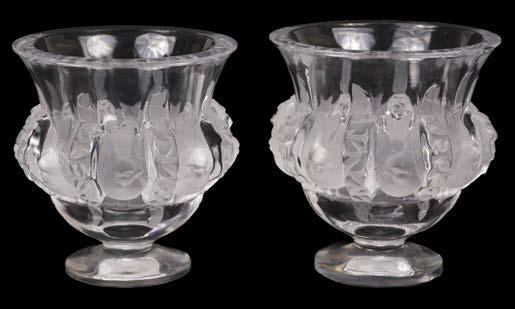
445* Lalique. A pair of Lalique ‘Dampierre’ frosted glass vases circa 1960s, each decorated with birds, the bases signed ‘Lalique France’, 12 cm high, in good condition
The ‘Dampierre’ pattern was originally designed by Marc Lalique in 1948 and more commonly made for production in the 1960s.
(2)
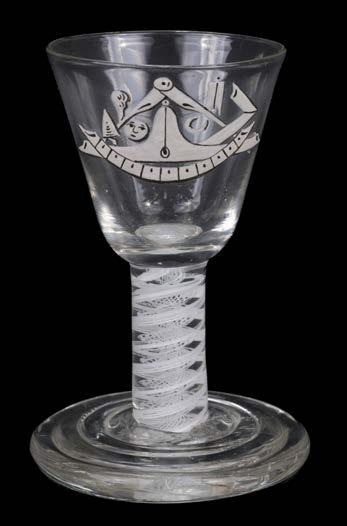
£200 - £300

446* Masonic Glass. A fine George III double series opaque twistfiring glass circa 1765, the ogee bowl with white enamelled masonic symbols raised on a double series opaque twist stem and thick terraced firing foot, 10cm high
The glass is very reminiscent of the work of Newcastle-upon-Tyne glass maker Anthony Taylor who was active circa 1765. Similar examples have been sold at Bonhams on 19 May 2010 (lot 28) and Woolley & Wallis on 16 June 2021 (lot 18).
For other examples of Taylor’s Masonic glass see Simon Cottle, ‘The Other Beilbys: British Enamelled Glass of the Eighteenth Century’, Apollo (October 1986), pp.315-327.
(1)
£500 - £800
447* Sevres. La Lecon De L’Amour (Lesson of Love), bisque porcelain figural group, late 19th century, modelled as Venis and Cupid kneeling on a naturalistic base impressed with title, the underside with the interlaced Sevres factory mark, 22 cm high (1)
£150 - £200
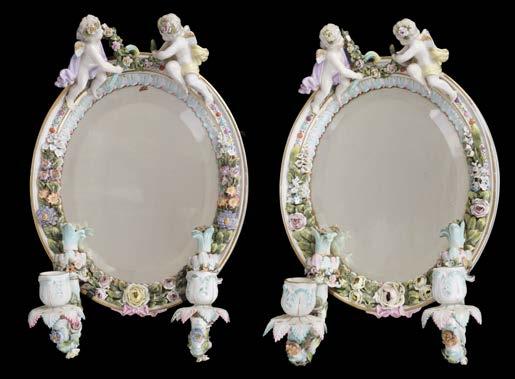
448* Wall Mirrors. A pair of Dresden porcelain wall mirrors, each with an oval frame surmounted with two cherubs united by a garland of flowers, the lower section with a pair of girandoles, each mirror profusely encrusted with flowers, 32 x 25.5 cm
Provenance: Dambuster, William “Bill” Townsend, 617 Squadron, Royal Air Force (1921-1991), thence by family descent.
(2)
£200 - £300
449* Boxes. A Victorian campaign mahogany brass bound writing box, the hinged lid enclosing fitted interior and green baize fall, 15.5 cm high x 45.5 cm wide x 25 cm deep, together with a Regency rosewood tea caddy, 19 cm high x 34.5 cm wide x 17 cm deep, plus two jewellery boxes
(4)
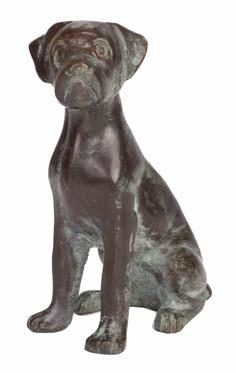
£100 - £150
450* Bronze. A bronze sculpture, late 20th century, modelled as a boxer dog, with an attractive verdigris, 15 cm high (1)
£70 - £100
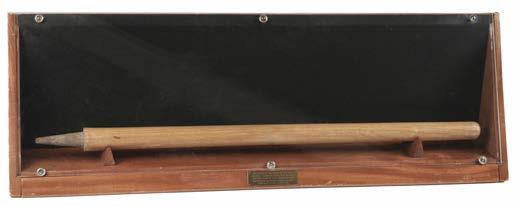
451* Cricket. A Cased Presentation Cricket Stump, with brass plaque inscribed ‘Presented by Rothman’s of Pall Mall, Freddie Trumans [sic] 150th Test Wicket, England South Africa Test Edgbaston 1960, Mayoress of Southport Charity Evening, Kingsway Club Southport’, length 88cm, presented in a teak case with plaque and Perspex cover
Frederick Sewards Trueman (1931-2006) was an English cricketer who played for Yorkshire County Cricket Club and the England cricket team, later becoming an author and legendary BBC Test Match Special broadcaster. (1)
£150 - £200
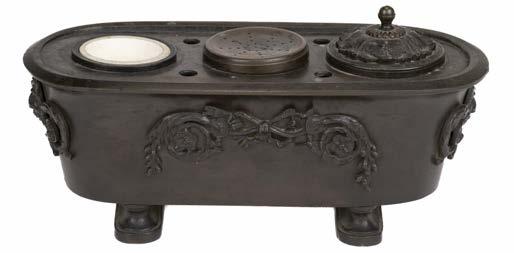
452* Desk Stand. A Regency bronze desk stand, of tapered oval form applied with mask heads and floral swags, encompassing a pounce pot and two inkwells, one with cover the other missing, raised on two supports, 8 cm high x 21 cm wide x 9.5 cm deep (1)
£100 - £150
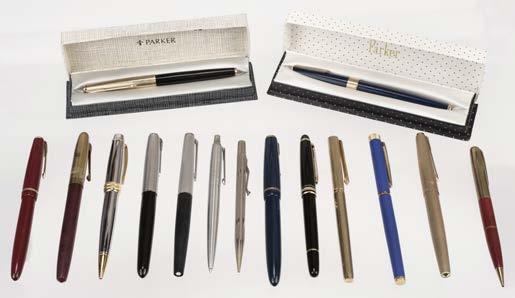
453* Fountain Pens. A Parker Victory fountain pen, maroon with 14K nib, 13.5 cm long, together with another Parker with 14K nib, plus a Parker “17” with original box and instructions, Mont Blanc biro and other pens (24)
£100 - £200
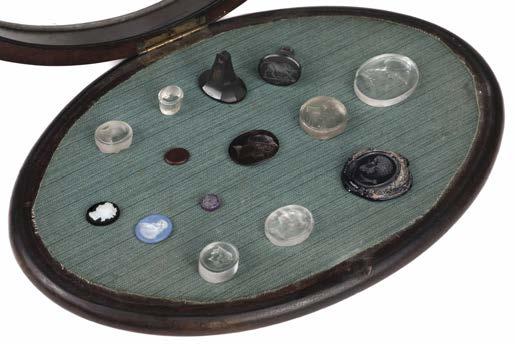
454* Grand Tour Intaglios. A group of fourteen late 18th/early 19th century intaglios, mixture of coloured glass and obsidian oval intaglios and cameo reliefs of classical and neo-classical subjects, male and female portraits, one signed with initials ‘’C. H. W’, another ‘W WVQN’(?), 2 depicting Minerva, two 8 faceted polished desk seals, possibly obsidian, one depicting a bull, the other a Bacchanalian procession, various sizes, the largest 4.5 x 3.5 cm, a few with small chips, contained in a Regency period oval mahogany glazed display case, with hooked clasp, 22.5 x 21.5 cm (14)
£700 - £1,000
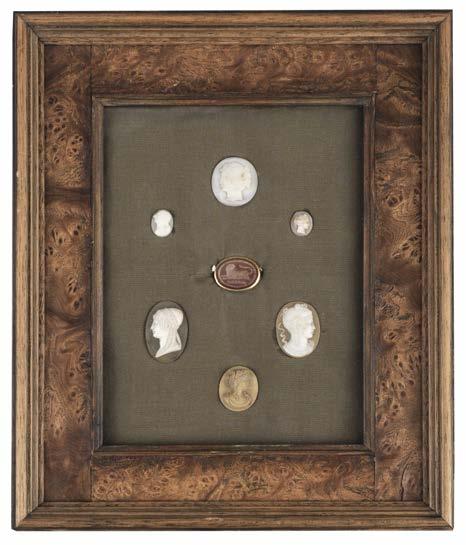
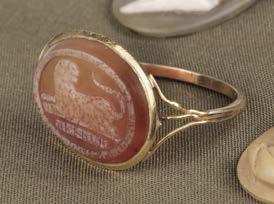
455* Grand Tour. A yellow metal ring, set with an oval carved carnelian stone, 18th century, the speckled stone depicting a recumbent lion, its head turned to the right, there is an indistinct motto beneath, set into a fine yellow metal mount, misshapen, the face of the stone 15 x 20 mm, together with a collection of cameos mostly carved on conch shell, depicting Greco-Roman female heads, largest 28 mm, smallest 7 mm, plus another cameo carved in lava, 25 mm, laid of green cloth and presented in wooden frame, glazed, frame size 24 x 20.5 cm (7)
£300 - £500
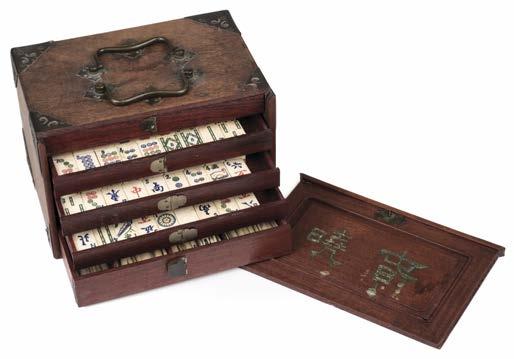
456* Mahjong. A Chinese mahjong set, early 20th century, the hardwood box with two carrying handles and fret-cut corners, the sliding cover engraved with two characters, enclosing five drawers (one handle missing) each with bone and bamboo tiles (148), the lower drawer with various bone sticks and printed instructions, the case 16 cm high x 24 cm wide x 15.5 cm deep (1)
£100 - £150
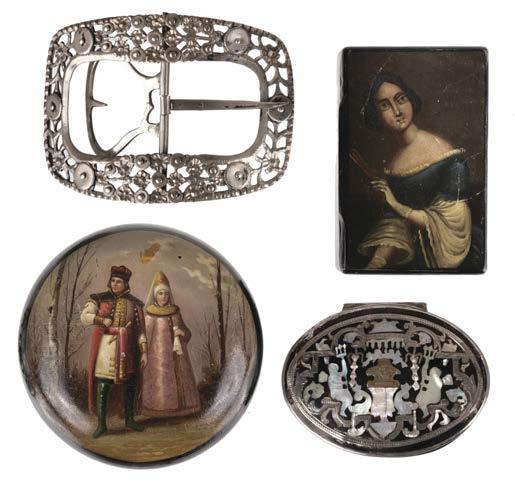
457* Snuff Box. An Italian tortoiseshell and white metal oval snuff box, late 18th century, the lid inlaid with white metal, mother of pearl and brass, depicting two putto each holding a trident representative of Neptune with dolphins flanking a fountain, 8.5 cm long, some damage to the tortoiseshell, together with a French silver buckle, early 19th century, 10 long, plus two papier mache snuff boxes, one painted with a female, 8 x 5 cm (4)
£100 - £200
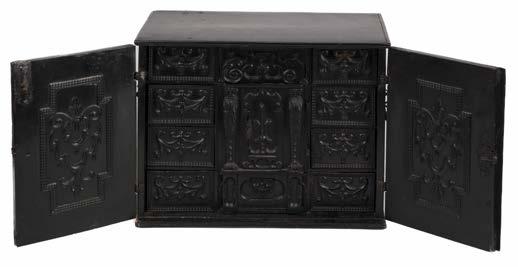
458* Table Cabinet. A Flemish ebonised table cabinet, 18th century, with two-panel doors with brass roundels and shaped key escutcheon and carrying handles, enclosing 8 drawers each carved in relief with scroll and swags, the central cabinet door flanked with pilasters, the hinges requiring minor attention, 33 cm high x 44.5 cm wide x 23.5 cm deep (1)
£400 - £600

459* Tea Caddy. A George III satinwood and silver tea caddy, circa 1800, of rectangular form with silver handle and white metal hinges and lion paw feet, the hinged lid enclosing velvet lined divisions for three canisters plus additional spoon holders, 19.5cm high x 32cm wide x 17cm deep (1)
£200 - £300
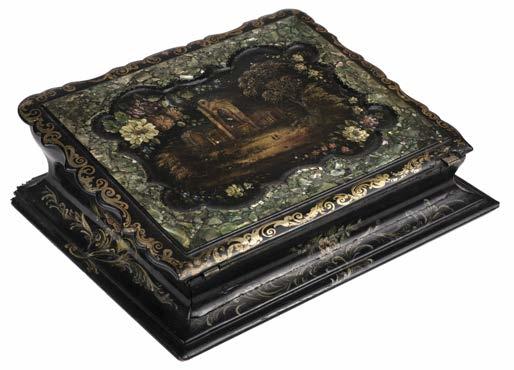
460* Writing Slope. A Victorian Papier Mache ladies’ writing slope, the sloping lid painted with abbey ruins within a landscape, inlaid with abalone and bordered in gold-painted scrolls, enclosing tooled velvet fall and compartments, some loss and damage, 29.5 x 36 cm (1)
£100 - £150
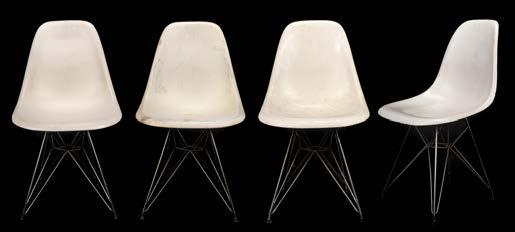
461* Eames (Charles, 1907-1978) and Eames (Bernice ‘Ray’, 19121988). DSR moulded plastic side chairs, late 1950s, a set of four beige polyester resin reinforced fibreglass seats with polished chrome ‘Effiel Tower’ wire bases, designed by Charles and Ray Eames for Herman Miller, Michigan, produced under license by Hille of London, each with original manufacturer’s label to underside of seat, all four chairs have the original rubber shock mounts between the seat base and legs, and each leg has the original self-levelling black plastic floor glide, height 80 cm, width 47 cm, depth 53 cm, seat height 44.5 cm, signs of use and wear, some rust patches to the chrome legs (4)
£200 - £400

462* Desk. An Edwardian Carlton House satinwood desk in the manner of Holland & Sons, the top with raised superstructure with an arrangement of drawers and cupboards, leather lined sliding writing panel, over three short drawers on four tapered supports each with brass castor, restored and lacking one handle, 97 cm high x 130 wide x 60 cm deep (1)
£400 - £600

463* Folio Stand. A William IV mahogany folio stand, the slatted divisions with ratcheted folio rests to each side on end standards with moulded C-scroll brackets and turned feet with inset antifriction castors, with baton carrying handles, 104 cm high x 69 cm wide x 71 cm deep (1)
£700 - £1,000
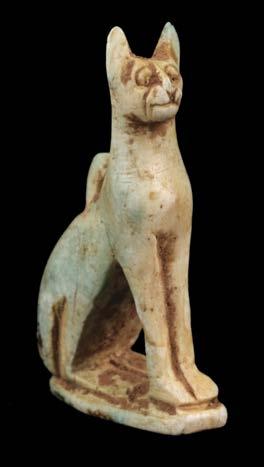
464* Ancient Egypt. An Egyptian faience turquoise amulet, modelled as a seated cat which was sacred to the goddess Bastet, 4 cm high
Provenance: Ex Donald Searle collection. (1)
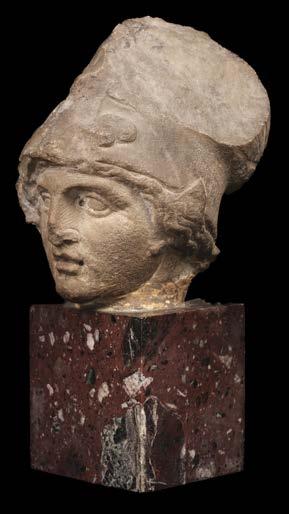
£300 - £500
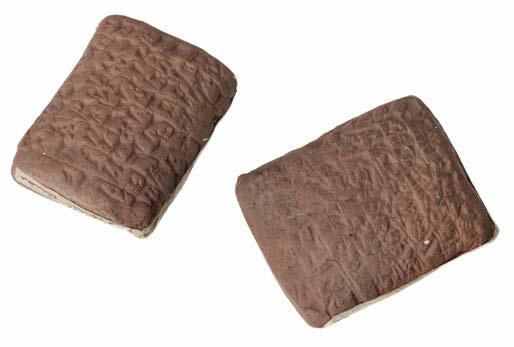
466* Babylonia. A Babylonian rectangular clay tablet, containing around 8 lines of cuneiform text on the front and back, another containing 9 lines on the front and back, approximately 32 mm long, each with an old manuscript label inscribed in Arabic
465* Ancient Rome. A Roman stone carving of the head of Pallas Athene, finely carved with the remains of a helmet resting on the top of her head, weathered, 11 cm high, mounted on a red marble base, overall height 16.5 cm
Provenance: Private collection, Berkshire.
Pallas Athene is the ancient Greek goddess of wisdom, warfare and handicraft she was depicted wearing a helmet and holding a spear and later associated with the Roman goddess Minerva. (1)
£200 - £300
Provenance: Ralph Ewart Ford (1897-1974), precision engineer and founder of Fords (Finsbury) Ltd. In Bedford. A member of the Bibliographical Society, he formed one of the largest collections of English Bibles in England. During the coronation of Queen Elizabeth II in 1953, a selection of the rarest and most important early English Bibles from Ralph Ford’s collection went on display in a touring exhibition across England, including the Chapter House at Westminster Abbey. (2)
£200 - £300

467* Ancient Egypt. An Ancient Egyptian cup, probably circa 2000 B.C., carved in lapis lazuli stone with plain foot, 40 mm high
Provenance: Private collection, Gloucestershire.
A simple but elegant piece carved from Lapis Lazuli, a stone found in Afghanistan and transported to Egypt for use in ornamental production. (1)
£300 - £500

468* Ammonites. An ammonite deathbed, Jurassic period found in Marston Magna, Somerset, a fine display piece, approximately 14.5 x 19 cm
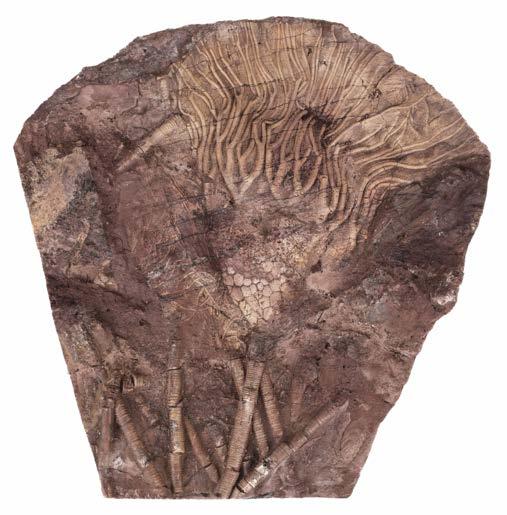
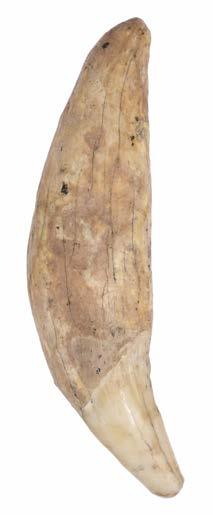
£300 - £500
This fossil display is a contemporary to the Lyme Regis ammonites and shows Xipheroceras and Promicroceras specimens. Many hours of work have gone into exposing them. (1)
469* Cave Bear Tooth. A fossilised cave bear tooth from the Pleistocene period, approximately 25,000 years old, found in the Carpathian mountains in Romania, this specimen comes from a large animal and a fully intact root and crown, 10 cm long (1)
£100 - £150
470* Fossil Crinoid. A fine example of a Scyphocrinite species from the Silurian period of Alnif in South Morocco, approximately 410 million years old, these fossils were dubbed sea lilies but are in fact animals, this specimen measures approximately 26 x 26 cm (1)
£100 - £150
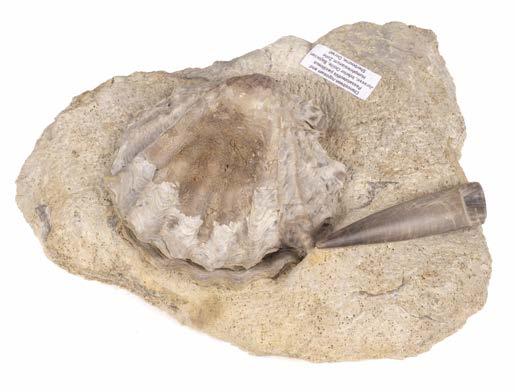
471* Fossil Display. A fossilised scallop and belemnite, from the mid-Jurrasic found in Yeovil, Somerset, many hours of preparation have gone into this piece to reveal a near-perfect Ctenostreum scallop and belemnite, the stone matrix measuring approximately 19 x 20 cm, presented on a metal stand for display (1)
£150 - £200
472* Fossil Reptile. A fossilised Barasaurus reptile preserved in a nodule, from the Permian period of Fianarantsoa, Madagascar, an excellent example with fine detail throughout the skull and the limbs, approximately 22 cm long (1) £300 - £500
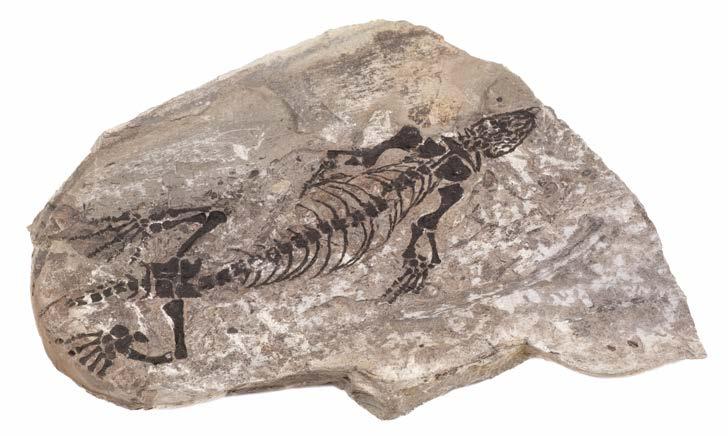
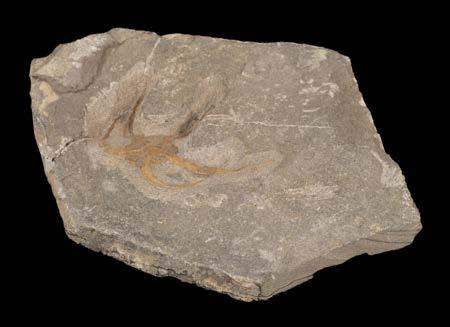
473* Fossilised Starfish. A Brittlestar, Ophiuroidea from the Middle Ordovician period of El Kaid, Morocco, a fine and well-detailed specimen which is preserved in a coating of limonite giving the fossil its orange colouration, the matrix measures approximately 24 cm long (1) £70 - £100
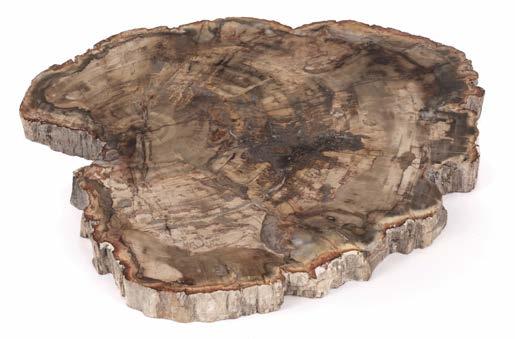
474* Fossilised Wood. A large fossilised agatized wood slice from the Triassic Period of Madagascar, approximately 220 million years old, a nice example with a deep buff of orange, 36 cm across (1) £100 - £150

475* Fossils & Minerals. A Hildoceras Ammonite, Jurrasic period, 9.5 cm across, together with two polished ammonite slices, 5 and 4 cm across, a fossilised fish, 8 cm long, fossilised sea urchin, polished agate slices, Cornish Serpentine egg and other items (12)
£70 - £100
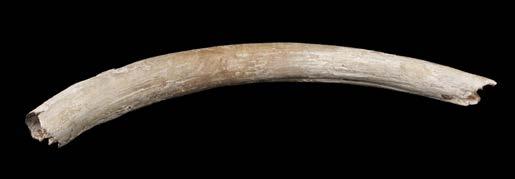
476* Mammoth Tusk. A British Woolley Mammoth tusk found in Oxfordshire in the 1990s, retaining its natural patina, approximately 60 cm long and scarce Tusks from inland locations such as Oxfordshire are rare in the United Kingdom. Most tusks are found in the permafrost of Russia. (1)
£500 - £800
477* Megalodon Tooth. A Megalodon tooth, from the Miocene period of Indonesia, an exceptional example of this popular fossil with every serration still intact, approximately 10 cm long
The condition of this fossil sets it apart from the majority of specimens found in this location.
(1)
£300 - £500
478* Megalodon Tooth. A Megalodon tooth, from the Miocene period of Indonesia, an exceptional example of this popular fossil with every serration still intact, approximately 13.5 cm long
The condition of this fossil sets it apart from the majority of specimens found in this location and it would have come from a huge animal.
(1)
£500 - £800
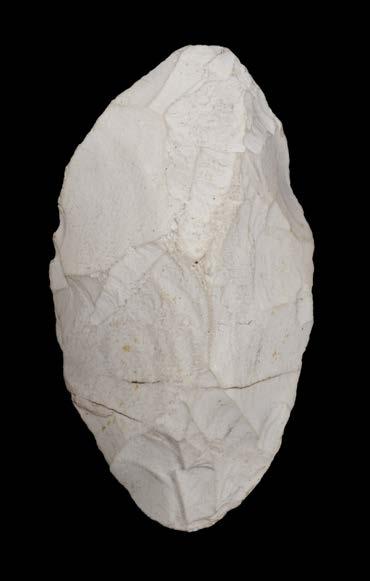
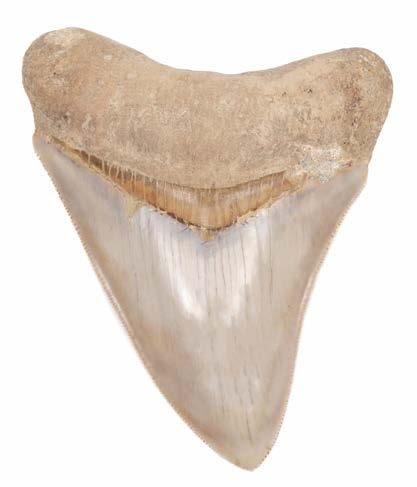
£70 - £100
479* Neolithic Axe. A Neolithic axe found in Katanga, Democratic Republic of the Congo, Africa, from an old collection this example has fine knapping to each side, approximately 8 cm long (1)
480* Theropod Tooth. A Therapod tooth, from the Cretaceous of Taous (Kem Kem), Morocco, approximately 110 million years old, this fossil is preserved with fine serrations, approximately 20 mm long
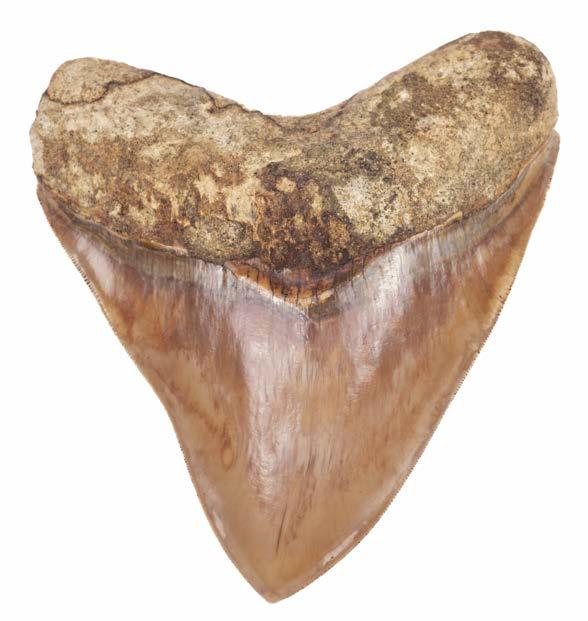
The Theropod dinosaur was a predatory dinosaur and was a close resemblance to the North American Tyrannosaurus Rex. The Theropod grew to lengths of 40 feet and weighed up to 15 tons. (1)
£70 - £100
481* Tooth. A fossilised Cave Hyena tooth from the Pleistocene period approximately 25,000 years old, found in Srbsko, Czech Republic, a complete tooth from a large animal and scarce, approximately 65 mm long (1)

£70 - £100


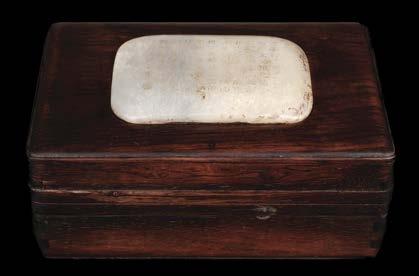
482* Charger. A Chinese famille rose porcelain charger, 18th century, polychrome decorated with pagodas, a fence and flowers, two hairline cracks to the rim and several small chips, 35.5 cm diameter, together with a smaller Chinese porcelain charger, decorated with a vase of flowers and foliate panels to the rim, the underside painted with three red flowers, hairline cracks, 31 cm diameter (2)
£100 - £150
483* Elephants. A fine pair of Japanese bronze elephants, Meiji period (1868-1912), the substantial and finely detailed bronze elephants modelled standing, heads slightly facing down with long tusks (one missing), unsigned, 23 cm high x 35 cm long (2)
£700 - £1,000
484* Jade. A Chinese hardwood box, the lid inset with a large jade panel with 11 rows of calligraphy, the panel measuring 7 x 10 cm, the box, 7.5 cm high x 18 cm wide x 12 cm deep (1)
£150 - £200
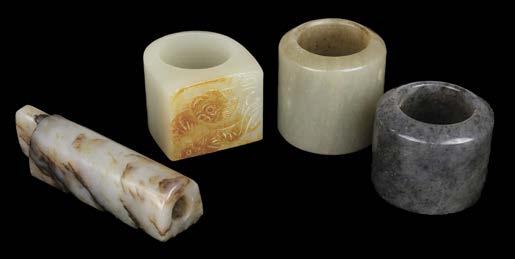
485* Jade. A Chinese jade archers ring, mottled black stone, 3.5 cm diameter, together with another celadon jade archers ring, 3.5 cm diameter, plus another ring with a flat top engraved with a warrior, 3.2 cm wide, plus a belt toggle grey black mottled stone, 3.5 cm long (4)
£200 - £300
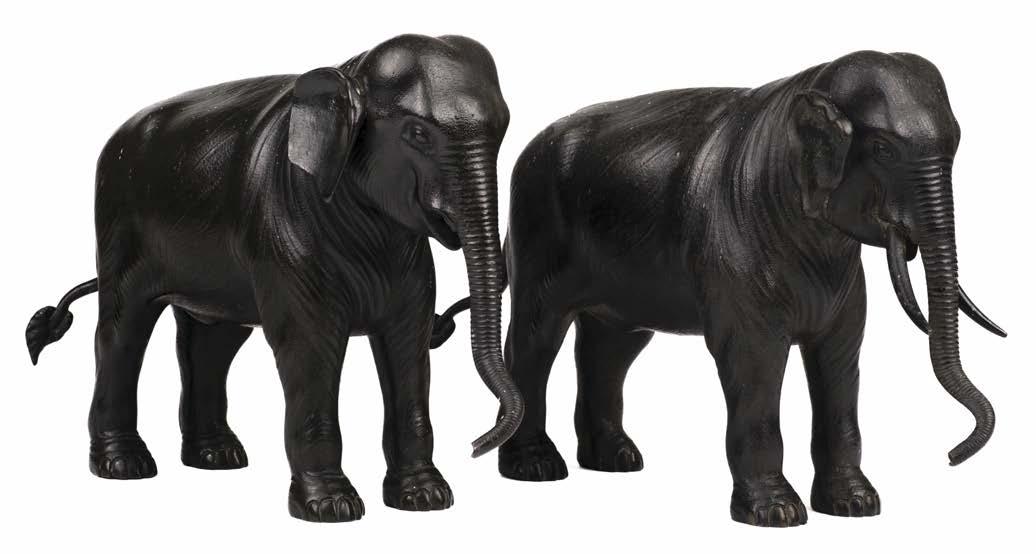
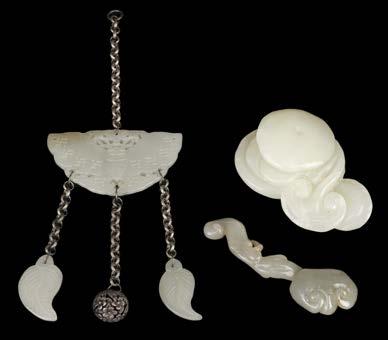

489* Jade. A Chinese jade pei, one side carved with a recumbent deer and bat, the other with a seal mark, pierced for suspension, 5 cm high, together with another jade pei, both sides with geometric carving, pierced for suspension, 5.5 cm long, plus a jade bi and a small kylin carving
£100 - £150
486* Jade. A Chinese jade boulder, carved as a lingzhi, natural flaw to the stone, 7 cm long, together with a jade ruyi sceptre, 7.5 cm long, plus a butterfly pendant, pierced and carved with swastika symbols, with central white metal drop flanked by two jade leaf drops, 6 cm long (3)
£100 - £150
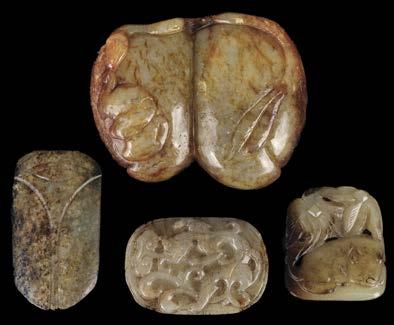
487* Jade. A Chinese jade boulder, carved as two fruit with a bat to the right, 8 cm long, together with three further jade carvings including a sleeping cub, 4.5 cm high, plus a kylin and lingzhi, 5 cm long
£150 - £200
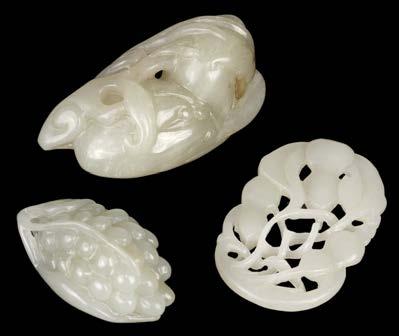
Jade. A Chinese jade fruit, carved as berries and vine, 5 cm long, together with a jade boulder carved as a cub with a paw resting on a ball, 6.5 cm long, plus another jade carving

490* Jade. A jade panel, carved as a carp catching a dragonfly, 9 cm long, together with a jade fish, 6 cm long, a jade carving of a cub, 6 cm long plus a foliate carved jade panel, 6 cm long (4)
£150 - £200
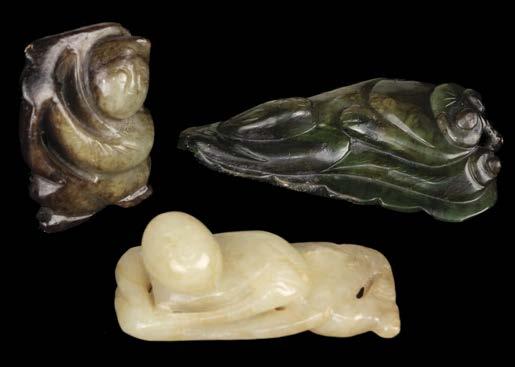
491* Jade. A spinach green jade boulder, carved a recumbent feline cub sleeping on a leaf, 8.5 cm long, together with a jade carving of a boy resting, 6 cm long, plus another jade carving
£100 - £150

492* Jade. A Chinese jade belt hook, carved with a monkey and a beast fighting over a fruit, with a horsehead terminal, 12.5 cm long, together with a near pair of dragon belt hooks, each 8.5 cm long (3)
£200 - £300
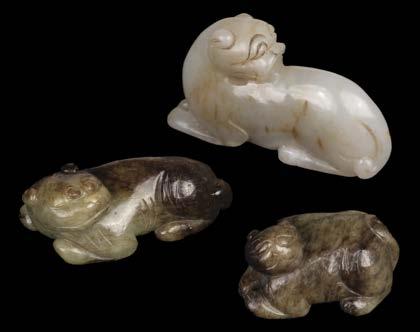
493* Jade. A Chinese jade feline cub, the recumbent cub with its head turned back, 8 cm long, together with two further jade cubs, each carved from a mottled stone, 7 and 5 cm (3) £150 - £200

494* Persian Metalwares. An Islamic circular brass tray, late 19th century, profusely inlaid with silver and copper, 69.5 cm diameter, together with a pair of Indian brass vases each with black lacquer decoration, 22 cm high, plus a pair of smaller Indian brass spill vases, 18 cm high (5) £150 - £200
Each lot is subject to a Buyer’s Premium of 20% (Lots marked * 24% inclusive of VAT @ 20%)
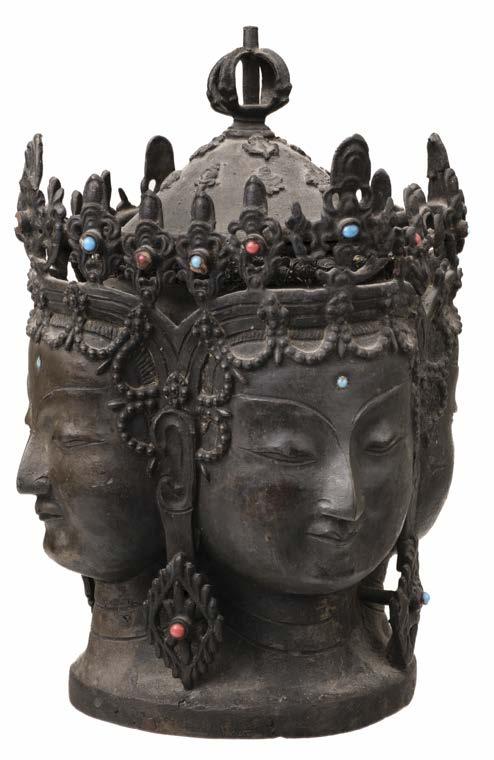
495* Tibet. A Tibetan bronze, 19th century, four co-joined female heads each wearing a headdress inset with semi-precious stones, the top with a vajra, 30 cm high, with associated Indian brass stand (1)
£300 - £500

496* Vases. A pair of Japanese bronze vases, Meiji period (18681912), of slight baluster form each cast in relief with exotic birds and pine trees, 19 cm high, one lacking base and both with one minor hole (2)
£150 - £200
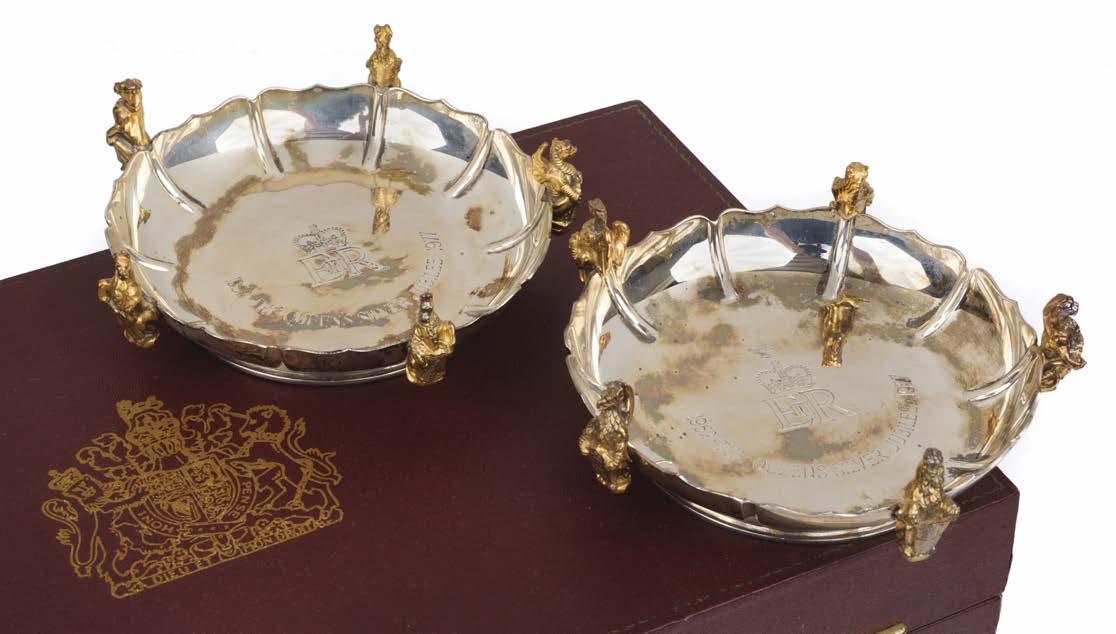
497* Bon Bon Dishes. “The Queen’s Beasts Silver Jubilee 1952-1977”, a pair of silver bon bon dishes by Garrard & Co Ltd, London, 1977, limited edition numbered 30/250, the bowl engraved and with scalloped edge, surrounded with the ten gilt beasts, with original fitted box, gross weight 549g
(2)
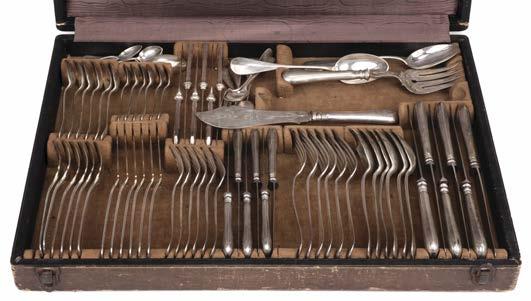
498* Canteen. An Austrian ‘800’ silver canteen of cutlery, circa 1920, comprising 6 dinner forks, 6 dinner knives, fish servers, 6 fish knives, 6 fish forks, 6 dessert forks, 12 dessert knives, 12 teaspoons, 12 coffee spoons, 8 serving spoons, contained in a fitted box, gross weight approximately 2300g
(1)
£600 - £800
£300 - £400
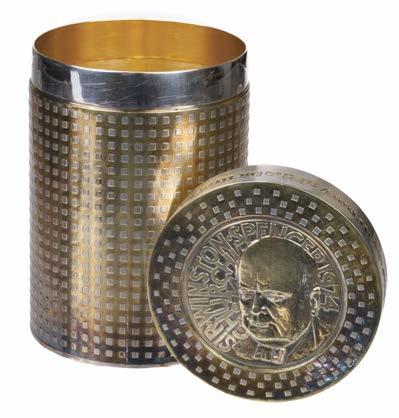
499* Cigar Case. “The Churchill Centenary” cylindrical cigar case by Garrard & Co Ltd, London 1973, the lid with a relief portrait titled ‘Sir Winston Churchill 1874-1974’, designed by John S Churchill & Alex Styles, limited edition numbered 36/100, the gilt slightly tarnished, 11cm high, 385g, in a Garrard & Co Ltd fitted case (1)
£300 - £400

500* Condiment Set. A three piece condiment set designed by Anthony Elson for Garrard & Co Ltd, London, 1975, comprising salt, pepper and a mustard pot, each piece with a diamond pattern gilt top, the mustard pot with hinged cover and blue glass liner with an accompanying spoon, 237g
Anthony Gordon Elson was born in Worthing, Sussex in 1935. He was a Liveryman of the Worshipful Company of Goldsmiths and trained under Dunstan Pruden at Brighton College of Art in 1956. (3)
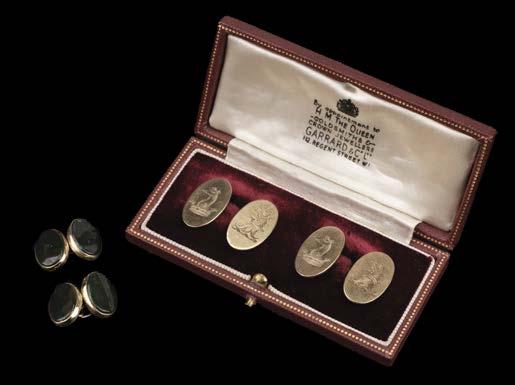
£150 - £200
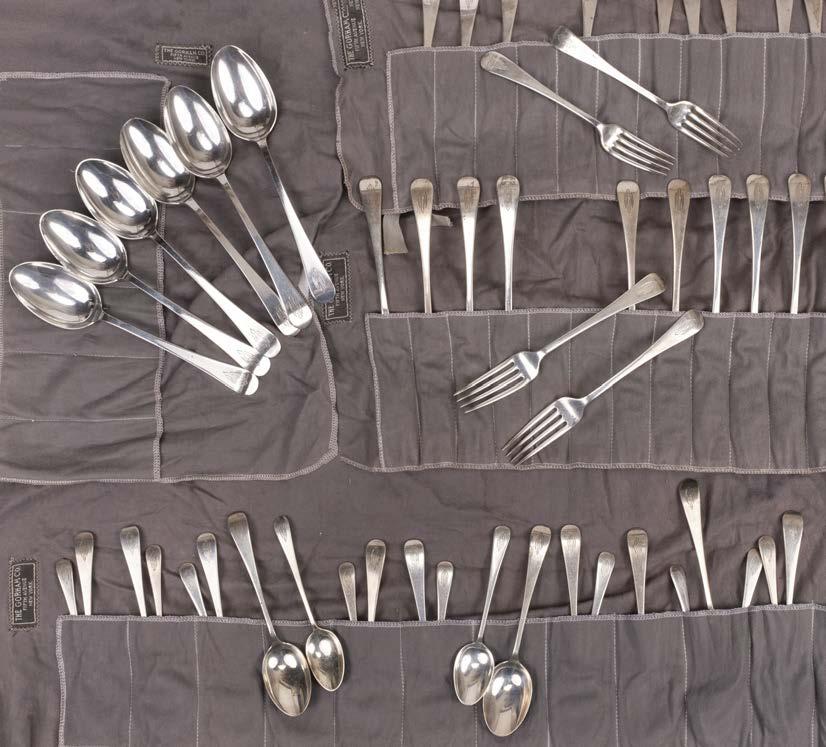
£150 - £200
501* Cufflinks. A pair of 9ct gold cufflinks, each engraved with a family crest showing a greyhound and griffin head, stamped ‘375’, gross weight 9.1g, together with another pair of 9ct gold cufflinks each inset with bloodstone panels, stamped ‘375’, gross weight 7.5g (2)
502* Cutlery. American Sterling silver cutlery, circa 1920s, comprising 12 dinner forks, 12 dinner knives, 12 dessert forks, 9 dessert knives, 12 dessert spoons, 11 teaspoons, 6 serving spoons, 12 tea knives, 6 grapefruit spoons, 6 coffee spoons plus 4 matching pepperet tes, gross weight approximately 3030g (a shoe box)
£1,000 - £1,500
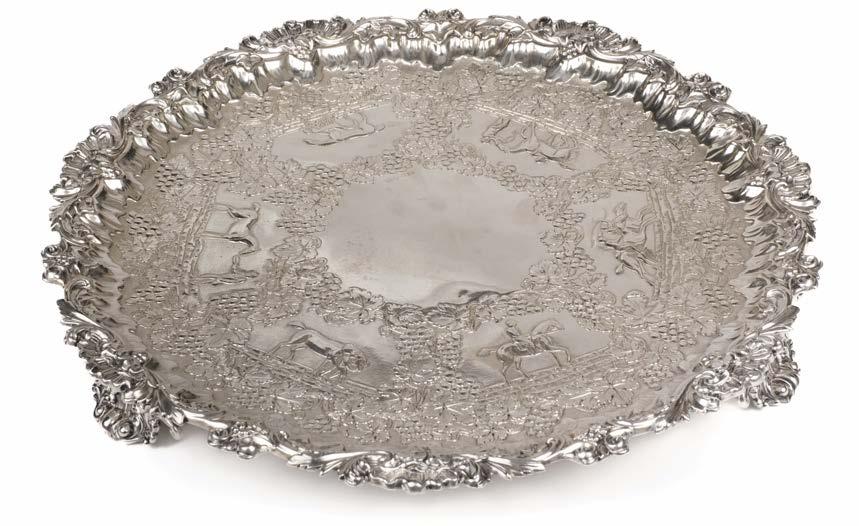
503* Equestrian Salver. A William IV silver salver, makers mark worn but probably Henry Wilkinson & Co, Sheffield 1833, the substantial circular salver embossed with horse racing panels amongst grape and vine decoration, with scroll and grape edge, raised on three curved shell and scroll supports, 45.5 cm diameter, approximately 2480g (1)

£1,000 - £1,500
504* Goblets. A set of 8 silver goblets designed by Anthony Elson for Garrard & Co Ltd, London, 1975,1977, each of traditional form with cast stem a geometric trellis pattern on a circular pedestal with circular domed foot, each with gilded interior, bases stamped with makers marks, 20 cm high, 1720g
Anthony Gordon Elson was born in Worthing, Sussex in 1935. He was a Liveryman of the Worshipful Company of Goldsmiths having trained under Dunstan Pruden at Brighton College of Art in 1956. (8)
£800 - £1,200
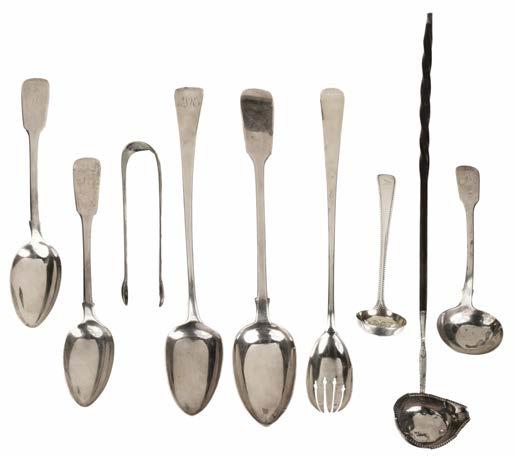
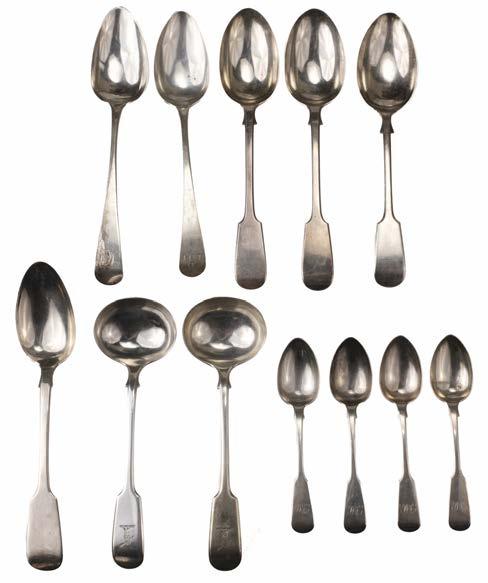

506* Mixed Silver. A large collection of mixed silver cutlery, including serving spoons, teaspoons, a toast rack and forks, gross weight approximately 803g, plus other continental silver items (a small box)
£300 - £500

507* Mixed Silver. A silver armada silver dish by Garrard & Co Ltd, London 1985, 17.5 cm diameter, 276g, together with four silver napkin rings, 6 silver teaspoons by Samuel Godbeheret and Edward Wigan, London 1792, each engraved with the initial ‘G’, 13 cm long, a set of 12 silver coffee spoons, and other items, weighable silver gross weight approximately 667g (a small box)
£250 - £350

505* Mixed Silver. A George IV silver serving spoon by Richard Crossley & George Smith IV, London, 1811, of plain form engraved with a monogram, 118g, 30 cm long, together with a pair of silver spoons by Samuel Hayne & Dudley Cater, London, 1850, of plain form engraved with a monogram, 142g, a sifter spoon by John, Edward, Walter & John Barnard (Barnard & Sons Ltd), London, 1868, 51g, plus other mixed silver items including sugar tongs, toddy ladle serving spoon, total weight approximately 624g (a shoe box)
£200 - £300
508* Mixed Silver. An art deco silver salver by F.C.Richards, Birmingham, 1938, the plain circular salver with shaped edge on three cabriole supports, 15.5cm diameter, 200g, together with a small silver bowl by Albert Edward Jones, Birmingham, 1966, with shaped edge and a relief portrait of Sir Winston Churchill, 141g, a small silver circular dish on raised foot, the hallmarks rubbed, 109g, plus a silver candle stick by D B, Birmingham 1977, 14.5 cm high, weighted (4)
£150 - £200
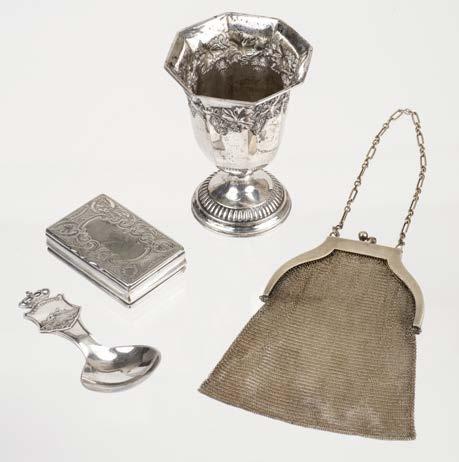
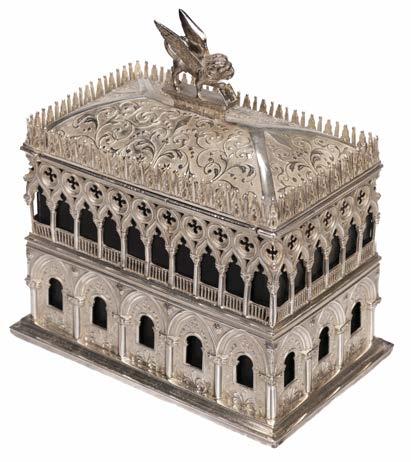

509* Mixed Silver. An art deco silver-gilt mesh purse, with engineturned cantle and chain, fine chain link bag, with import marks and the chain stamped ‘925’, 14 cm long, 101g, together with a white metal snuff box, engraved with foliate scrolls, gilded interior, 7 cm wide, a white metal pedestal cup embossed with grape and vine decoration, 11 cm plus a Danish silver caddy spoon decorated with fisherman, reverse engraved and dated 1963, 11 cm (4)
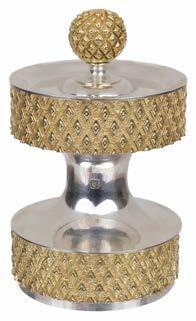
£150 - £200
510* Pepper Mill . A silver pepper mill by Anthony Elson for Garrard & Co Ltd, London, 1978, with cast gilt bands with a geometric trellis pattern and matching finial, the underside with the maker and designer mark, contained in the original card box, 11.5 cm high, weighted
Anthony Gordon Elson: born 1935 Worthing, Sussex. Liveryman of the Worshipful Company of Goldsmiths. 1956 trained under Dunstan Pruden at Brighton College of Art where he received a diploma. (1)
£200 - £300
511* Silver Casket. A Continental silver casket designed as a copy of Doges Palace, Venice, with winged lion finial, hinged lid, composite liner, 11.5 cm high, 178g (1)
£150 - £200
512* Soup Ladle. A Victorian silver soup ladle by Josiah Williams & Co, London, 1897, of plain form, 33.5 cm long, 298g (1)
£100 - £150
513* Spoons. A collection of silver spoons, including two Victorian serving spoons by Goldsmiths’ Alliance Ltd, London, 1887, four Victorian teaspoons by John, Henry & Charles Lias, London, 1827, each with a monogram, two ladles by Elkington & Co Ltd, Birmingham, 1900, engraved with a family crest plus four other serving spoons, total weight approximately 657g (12)
£300 - £500
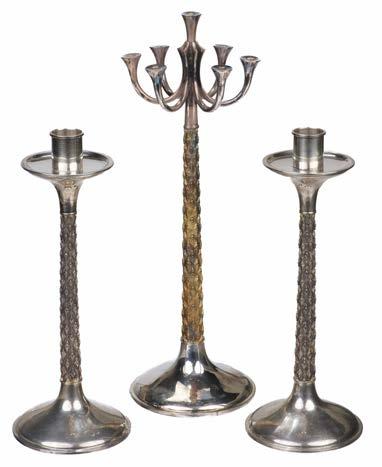
514* Table Suite. A silver candlestick converted to seven light candelabra designed by Anthony Elson for Garrard & Co Ltd, London, 1973, the cast gilt stem with geometric trellis pattern on a circular pedestal and domed foot, 32.3 cm high, together with a pair of candlesticks designed by Anthony Elson for Garrard & Co Ltd, 1973, each with matching geometric stems on circular pedestal and domed foot, 24.5 cm high, 953g
Anthony Gordon Elson: born 1935 Worthing, Sussex. Liveryman of the Worshipful Company of Goldsmiths. 1956 trained under Dunstan Pruden at Brighton College of Art where he received a diploma. (3)
£400 - £600
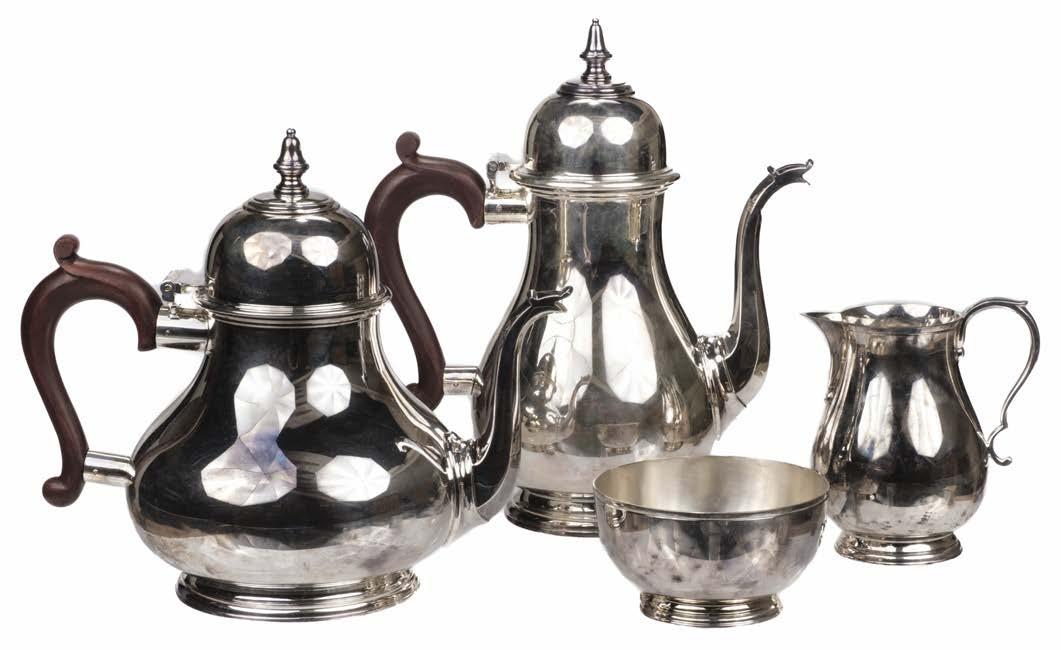
515* Tea Service. A four-piece Queen Anne style “Britannia Silver” tea service by Garrard & Co Ltd, London, 1977, comprising of coffee pot, teapot, cream jug, sugar bowl, of plain form, the tea and coffee pot of pear-shaped with domed hinged cover, wooden handles, the underside of each stamped with makers mark, the coffee pot 24 cm high, 2009g (4)
£800 - £1,200

516* Tray. A silver tray by Pinder Brothers, Sheffield, 1962, of oval form with two handles, classical style with gadrooned border, raised on four domed feet, 51.4 cm across,
£600 - £800


519* Gold. A gold charm bracelet, the hollow links with catch stamped but illegible, with various charms including a Chinese pendant which is pierced and displaying a character stamped 14K, a bowl and spoon stamped 14K and other charms, 15.5 cm long, gross weight 19g (1)
£300 - £500


£600 - £800
517* Charm Bracelet. A 9ct gold charm bracelet, with a heart shaped padlock and 12 charms including a typewriter, scooter, poodle, church, and clover, gross weight 37.6g (1)
518* Gold Pencils. A 9ct gold propelling pencil by E Baker and Son, Birmingham, circa 1950, together with another 9ct gold propelling pencil by the same maker, smallest 9.3 cm, largest 12 cm (2) £200 - £300
520* Jensen (Georg). A pair of 18ct gold earrings designed by Nanna Ditzel circa 1970s for Georg Jensen numbered 1131, plain abstract form with screw back clasps, 30 mm long, 14.3g (1)
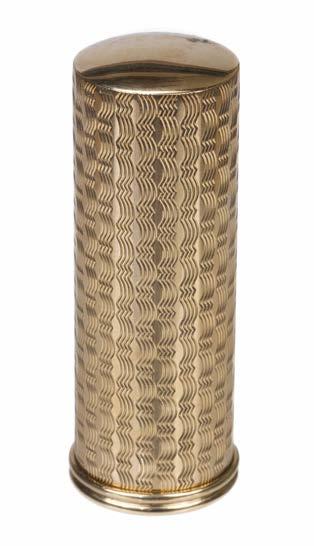
521* Lipstick
A 9ct
£500 - £800
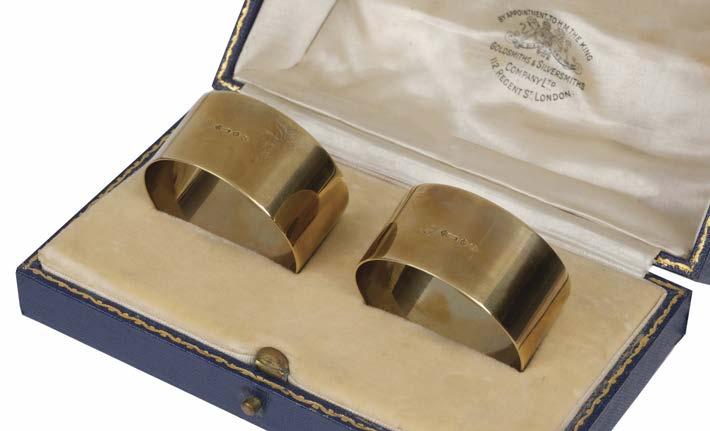
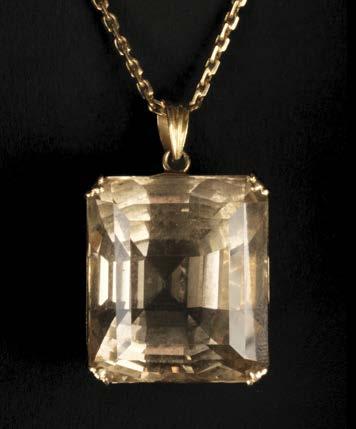


522* Mixed Jewellery. A 15ct gold ladies wristwatch, the white enamel dial signed ‘Waltham’, stamped ‘15’ on a 9ct gold strap, together with a yellow metal charm bracelet, unmarked but with a 9ct gold heart shape lock, an Edwardian 9ct gold pendant set with pink stone surrounded by pearls with a pearl drop, reverse stamped ‘W.B. Bros 9ct’ suspended on a fine 9ct gold chain, plus two Victorian gold plated guard chains plus various silver jewellery and propelling pencils including an Asprey example (12)
£300 - £500
523* Napkin Rings. A fine pair of art deco 9ct gold napkin rings by Goldsmiths & Silversmiths Co Ltd, London, 1929, each of plain form and cased, 4.5 cm diameter, 47g (2)
£800 - £1,200
524* Pendant. A 22k gold pendant set with a large facet cut smokey quartz, the openwork mount stamped ‘22k’, suspended on a yellow metal chain with Chinese hallmarks on the clasp, the stone measures 20 x 25 x 30 mm (1)
£300 - £500

525* Pendant. A modern 9ct gold open work pendant, set with a moonstone cabochon, 45 mm long, suspended on a 9ct gold chain, total length including pendant 30 mm, gross weight 11.7g (1)
£100 - £150
526* Powder Compact. A 9ct gold Kigu powder compact, by W H Manton Ltd [?], Birmingham, 1992, with a hexagonal textured gold body and ornate thumb piece, the interior fitted with mirror and powder mesh, 6.9cm diameter (1)
£700 - £1,000


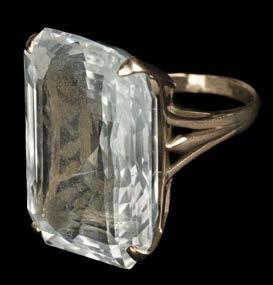
527* Ring. A 14ct gold ring, set with a large facet cut pale blue topaz, the stone measures approximately 18 x 20 x 30 mm, ring size L (1)
£300 - £500
528* Ring. A gent’s 18ct gold signet ring, engraved with initials, hallmarked ‘18’, size T, 7g (1)
£200 - £300
529* Rings. A 9ct gold ring, the openwork mount set with a large facet-cut citrine, stamped ‘ 9 375’, size O, period box, together with a 14K gold ring, set with a large facet cut purple stone (possibly an amethyst), stamped ‘I4K’, size P, period box, a 9ct gold eternity ring set with diamond chippings and garnets, size T/U, plus three dress rings (6)
£200 - £300
530* Rings. A 9ct gold seal ring, inset with a bloodstone intaglio, carved with a family crest, stamped ‘375’, size P/Q, together with three further 9ct gold rings each inset with bloodstone plus a pair of 9ct gold cufflinks inset with bloodstone, 19.5g (4)
£100 - £150
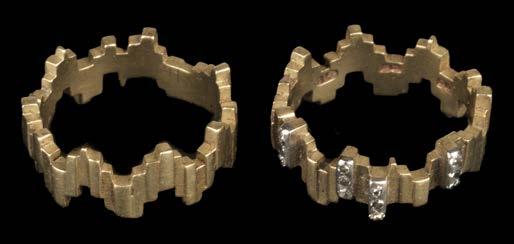
531* Rings. An 18ct gold abstract ‘two-part’ ring, one ring set with four rows of diamond chippings, the other left plain, each stamped ‘18’, size N/O, gross weight 13g (2)
£300 - £500
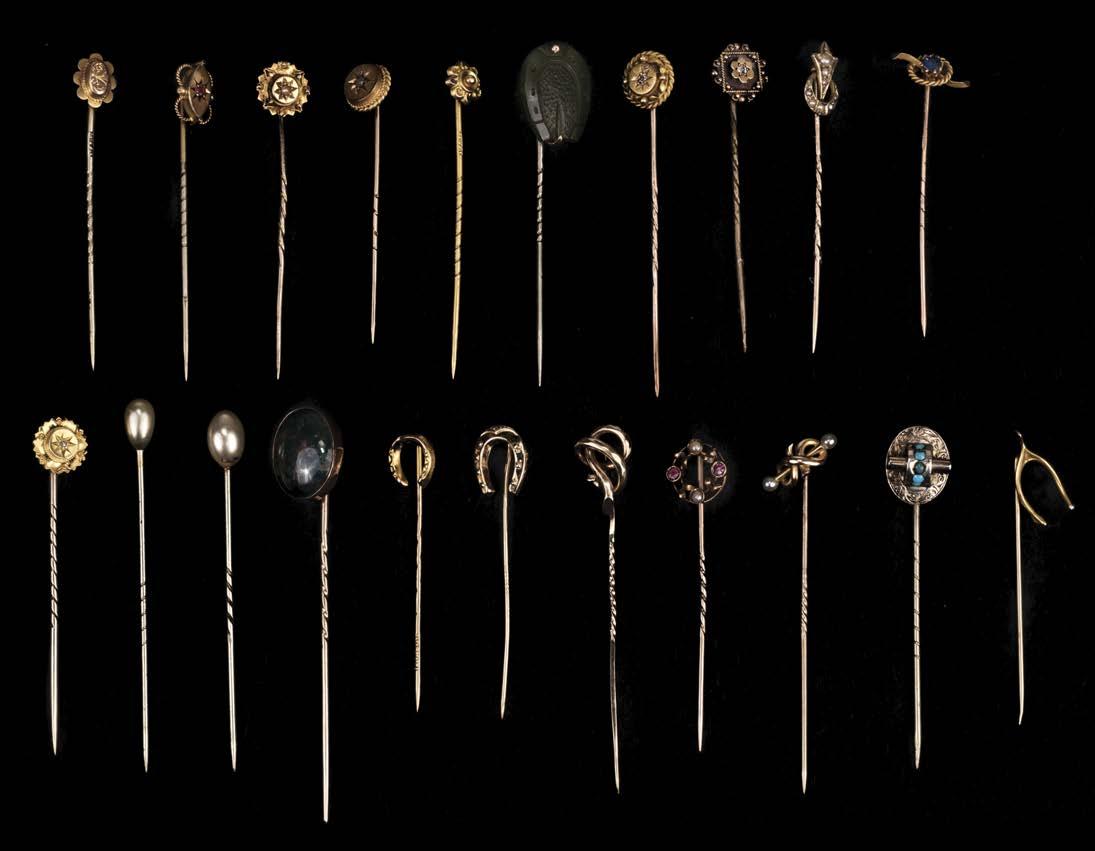
532* Tiepins. A collection of 160 gold and yellow metal Victorian and Edwardian tiepins, many different types, including 9ct gold with green jade stone horseshoe, stamped ‘9ct’, 6 cm, French 18ct gold pin with crescent set with three rough cut diamonds, hallmarked with “tete de marcassin” (wild boar), 7 cm long, 14ct gold pin set with an oval citrine, other examples include opals, amethyst, moonstone, turquoise, carnelian, cameo and agate, presented in two albums with typed descriptions assembled by the current owner, with 20 period boxes (160)
£1,500 - £2,000
533* United States of America. 1896 ten dollar gold coin, obverse showing Liberty, reverse American eagle, 27 mm diameter, converted to a pendant with yellow metal mount, gross weight 17.6g (1)
£800 - £1,200
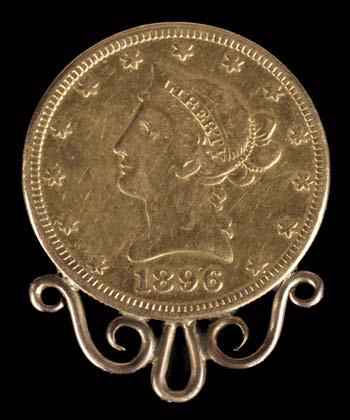
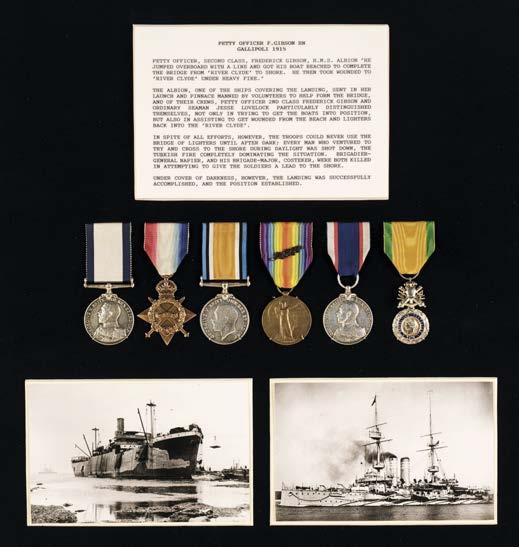

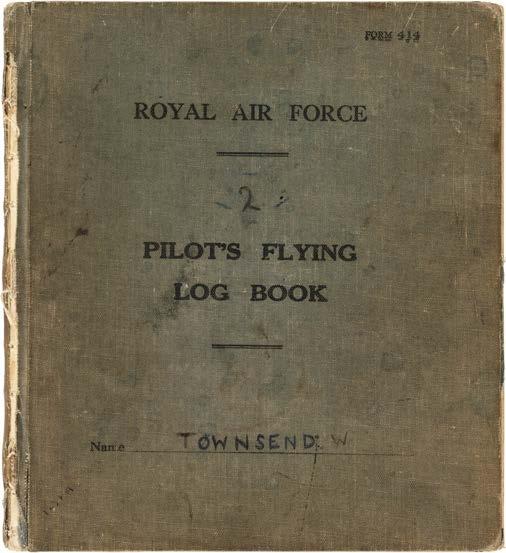
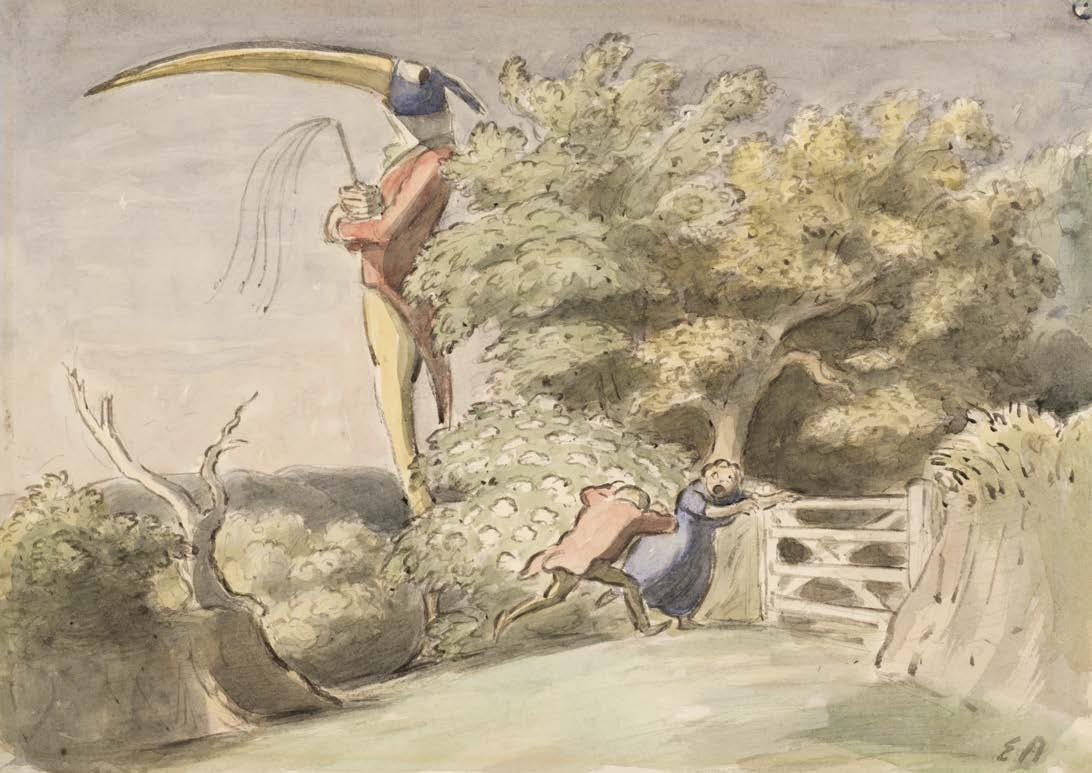
Ardizzone (Edward, 1900-1979). The Watcher, circa 1970, watercolour on thick wove paper, depicting a frightening tree-high slender figure with a birdlike head and very large yellow down-curved beak, wearing hunting pinks and pale yellow breeches with arms folded and holding a cat-o'nine-tails, a boy and girl running away fearfully towards a gate on the near-side of the tree and hedge line, initialled ‘E. A.’ lower right, 27 x 38 cm, some old adhesive tape marks to verso, mounted, 46 x 56 cm
Sketches of 'The Watcher' appear in Gabriel White's Edward Ardizzone, (London: Bodley Head, 1979), plate III. According to White 'it is not clear what their relationship is with human beings, whether they are malevolent figures of foreboding and ill omen, or types of guardian angel', (p. 169).
Estimate £600-800* AR
For further information please contact Paul Rasti or Joel Chandler:
Paul Rasti: paul@dominicwinter.co.uk
Joel Chandler: joel@dominicwinter.co.uk
Online Results: If you weren’t present or able to follow the auction live, you can find results for the sale on our website shortly after the sale has ended.
Payment: The price you pay is the amount at which the auctioneer’s hammer falls (the hammer price), plus a buyer’s premium (a percentage of the final hammer price) and vat where applicable. You will be issued with an invoice made out to the name and address provided on your registration form.
Please note successful bids made via live bidding cannot be invoiced or paid for until the day after an auction. A live bidding fee of 3% + VAT (Dominic Winter / Invaluable) or 4.95% + VAT (the-saleroom) will be added to your invoice.
Cheque: Cheques will only be accepted on the day of the sale by prior arrangement (please contact our office for further information). Cheques by post will be accepted but a period of 5 working days will be required for the cheque to clear before purchases can be collected or posted.
Cash: Payments can be made at the Cashier’s Office, either during or after the sale.
Debit Card: There is no additional charge for purchases made with debit cards in the UK.
Credit Cards: We accept Visa and Mastercard. It is advisable to let your card provider know in advance if you are intending to purchase. This reduces the time needed to obtain authorisation when the payment is made.
Bank Transfer: All transfers must state the relevant invoice number. If transferring from a foreign currency, the amount we receive must be the total due after the currency conversion and the deduction of any bank charges.
Note to Overseas Clients: All payments must be made by bank transfer only. No card payments will be accepted unless by special prior arrangements with the auctioneers.
Collection/Postage/Delivery: If you attend the auction in person and are successful in your bid, you are free to collect your item once payment has been made.
Successful commission or live bids will be invoiced to you the day after the sale. When it is possible for our in-house packing department to send your purchase(s), a charge for postage/packing/insurance will be included in your invoice. Where it is not possible for our in-house packing department to send your item you will be required to make your own arrangements or to contact Mailboxes etc (tel: 01793 525009) or Pack and Send (tel: 01635 887237) who may be able to help.
We provide a monthly delivery service to Central London, usually on Wednesday of the week following an auction. Payment must be received before this option can be requested. A charge will be added to your invoice for this service.
Lots marked with AR next to the lot number may be subject to Droit de Suite.
Droit de Suite is payable on the hammer price of any artwork sold in the lifetime of the artist, or within 70 years of the artist's death. The buyer agrees to pay Dominic Winter Auctioneers Ltd. an amount equal to the resale royalty and we will pay such amount to the artist's collecting agent. Resale royalty applies where the Hammer price is £1,000 or more and the amount cannot be more than £12,500 per lot.
The amount is calculated as follows: Royalty For the Portion of the Hammer Price (in GBP)
4.00% up to 50,000
3.00% between 50,000.01 and 200,000
1.00% between 200,000.01 and 350,000
0.50% between 350,000.01 and 500,000
Please refer to the DACS website www.dacs.org.uk and the Artists’ Collecting Society website www.artistscollectingsociety.org for further details.
1. The Seller warrants to the Auctioneer and the buyer that he is the true owner or is properly authorised to sell the property by the true owner and is able to transfer good and marketable title to the property free from any third party claims.
2. (a) The highest bidder to be the buyer. If during the auction the Auctioneer considers that a dispute has arisen he has absolute authority to settle it or re-offer the lot. The Auctioneer may at his sole discretion determine the advance of bidding or refuse a bid, divide any lot, combine any two or more lots or withdraw any lot without prior notice.
(b) Where goods are bought at auction by a buyer who has entered into an agreement with another or others that the other or others (or some of them) shall abstain from bidding for the goods and the buyer or other party or one of the other parties is a dealer (as defined in the Auction Biddings Agreement Act 1927) the buyer warrants that the goods are bought bona fide on joint account.
3. The buyer shall pay the price at which a lot is knocked down by the Auctioneer to the buyer (“the hammer price”) together with a premium of 20% of the hammer price. Where the lot is marked by an asterisk the premium will be subject to VAT at 20% which under the Auctioneer’s Margin Scheme will form part of the buyer’s premium on our invoice and will not be separately identified (the premium added to the hammer price will hereafter collectively be referred to as “the total sum due”). By making any bid the buyer acknowledges that his attention has been drawn to the fact that on the sale of any lot the Auctioneer will receive from the seller commission at its usual rates in addition to the said premium of 20% and assents to the Auctioneer receiving the said commission.
4. (a) The buyer shall forthwith upon the purchase give in his name and permanent address and pay to the Auctioneer immediately after the conclusion of the auction the total sum due.
(b) The buyer may be required to pay down during the course of the sale the whole or any part of the total sum due, and if he fails to do so after such request the lot or lots may at the Auctioneer's absolute discretion be put up again and resold immediately.
(c) The buyer shall at his own expense take away any lot or lots purchased no later than five working days after the auction day.
(d) The Auctioneer may at his own discretion agree credit terms with a buyer and extend the time limits for collection in special cases but otherwise payment shall be deemed to have been made only after the Auctioneer has received cash or a sterling banker’s draft or the buyer's cheque has been cleared.
5. (a) If the buyer fails to pay for or take away any lot or lots pursuant to clause 4 or breaches any other condition of that clause the Auctioneer as agent for the seller shall be entitled after consultation with the seller to exercise one or other of the following rights:
(i) Rescind the sale of that or any other lots sold to the buyer who defaults and re-sell the lot or lots whereupon the defaulting buyer shall pay to the Auctioneer any shortfall between the proceeds of that sale after deduction of costs of re-sale and the total sum due. Any surplus shall belong to the seller.
(ii) Proceed for damages for breach of contract.
(b) Without prejudice to the Auctioneer's rights hereunder if any lots or lots are not collected within five days or such longer period as the Auctioneer may have agreed otherwise, the Auctioneer may charge the buyer a storage charge of £1.00 + VAT at the current rate per lot per day.
(c) Ownership of the lot purchased shall not pass to the buyer until he has paid to the Auctioneer the total sum due.
6. (a) The seller shall be entitled to place a reserve on any lot and the Auctioneer shall have the right to bid on behalf of the seller for any lot on which a reserve has been placed. A seller may not bid on any lot on which a reserve has been placed.
(b) Where any lot fails to sell, the Auctioneer shall notify the seller accordingly. The seller shall make arrangements either to re-offer the lot for sale or to collect the lot and may be asked to pay a commission not exceeding 50% of the selling commission and any special expenses incurred in cataloguing the lot.
(c) If such arrangements are not made within seven days of the notification the Auctioneer is empowered to sell the lot by auction or by private treaty at not less than the reserve price and to receive from the seller the normal selling commission and special expenses.
7. Any representation or statement by the Auctioneer in any catalogue, brochure or advertisement of forthcoming sales as to authorship, attribution, genuineness, origin, date, age, provenance, condition or estimated selling price is a statement of opinion only. Every person interested should exercise and rely on his own judgement as to such matters and neither the Auctioneer nor his servants or agents are responsible for the correctness of such opinions. No warranty whatsoever is given by the Auctioneer or the seller in respect of any lot and any express or implied warranties are hereby excluded.
8. (a) Notwithstanding any other terms of these conditions, if within fourteen days of the sale the Auctioneer has received from the buyer of any lot notice in writing that in his view the lot is a deliberate forgery and within fourteen days after such notification the buyer returns the same to the Auctioneer in the same condition as at the time of the sale and satisfies the Auctioneer that considered in the light of the entry in the catalogue the lot is a deliberate forgery then the sale of the lot will be rescinded and the purchase price of the same refunded. "A deliberate forgery" means a lot made with intention to deceive. (b) A buyer's claim under this condition shall be limited to any amount paid to the Auctioneer for the lot and for the purpose of this condition the buyer shall be the person to whom the original invoice was made out by the Auctioneer.
9. Lots may be removed during the sale after full settlement in accordance with 4(d) hereof.
10. All goods delivered to the Auctioneer's premises will be deemed to be delivered for sale by auction unless otherwise stated in writing and will be catalogued and sold at the Auctioneer's discretion and accepted by the Auctioneer subject to all these conditions. In the case of miscellaneous books, the Auctioneer reserves the right to extract and dispose of books that, in the opinion of the Auctioneer at his absolute discretion, have no saleable value and, therefore, might detract from the saleability of the rest of the lot and the Auctioneer shall incur no liability to the seller, in respect of the books disposed of. By delivering the goods to theAuctioneer for inclusion in his auction sales each seller acknowledges that he/she accepts and agrees to all the conditions.
11. (a) Unless otherwise instructed in writing all goods on the Auctioneer's premises and in their custody will be held insured against the risks of fire, burglary, water damage and accidental breakage or damage. The value of the goods so covered will be the hammer price, or in the case of unsold lots the lower estimate, or in the case of loss or damage prior to the sale that which the specialised staff of the Auctioneer shall in their absolute discretion estimate to be the auction value of such goods.
(b) The Auctioneer shall not be responsible for damage to or the loss, theft, or destruction of any goods not so insured because of the owner’s written instructions.
12. The Auctioneer shall remit the proceeds of the sale to the seller thirty days after the day of the auction provided that the Auctioneer has received the total sum due from the buyer. In all other cases the Auctioneer will remit the proceeds of the sale to the seller within seven days of the receipt by the Auctioneer of the total sum due. The Auctioneer will not be deemed to have received the total sum due until after any cheque delivered by the buyer has been cleared. In the event of the Auctioneer exercising his right to rescind the sale his obligation to the seller hereunder lapses.
13. In the case of the seller withdrawing instructions to the Auctioneer to sell any lot or lots, the Auctioneer may charge a fee of 12.5% of the Auctioneer's middle estimate of the auction price of the lot withdrawn together with Value Added Tax thereon and any expenses incurred in respect of the lot or lots.
14. The Auctioneer’s current standard notices and information (i.e. Collation and Amendments) will apply to any contract with the Auctioneer as if incorporated herein.
15. These conditions shall be governed by and construed in accordance with English Law.
